Report

India’s consumption story is back on track in 2022, driven by a favourable demographic dividend, increasing digitisation, improving public infrastructure, and continued technological innovation. As Covid-19 concerns recede and demand rebounds, the country’s population will resume its shift from an income pyramid to a diamond-shaped economy as lower-income households ascend to middle-income levels. Across income levels, consumption is expected to grow from $1.8–$1.9 trillion in FY21 to about $3 trillion by FY26 due to increased demand from an added 4 million affluent and 33 million mass affluent households. Along with households, micro, small, and medium enterprises (MSMEs) will be key to the economy, contributing an expected $1.3 trillion in gross value added by FY26.
Despite this expected growth, both household consumption and MSMEs remain underserved by formal credit. Credit penetration in most living expenditure categories is less than 5% for households. MSMEs also lack access to formal credit, with more than 60% relying on costly informal sources of credit. This funding gap is expected to provide strategic opportunities for fintechs.
Digital financial services (FS) are accelerating financial inclusion, democratising access, and spurring personalisation of products and customer journeys. With a strong foundation provided by the Jan Dhan-Aadhaar-Mobile (JAM) trinity, Unified Payments Interface (UPI) rails, and other positive regulatory frameworks, the pandemic has aided acceleration in digital adoption and provided a fillip to digital FS solutions by incumbents (banks, traditional NBFCs, insurers, etc.) and insurgents (fintechs). With expected growth in smartphone users to approximately 1.1 billion by FY26, up from about 750 million today, and more than 850 million Internet users in FY26, up from about 650 million today, India is shifting towards a mobile-first economy, especially in FS.
Emergence of fintech
Enabled by UPI, Indian fintechs have made rapid gains in the payments space over the past few years. Digital payments have soared, with UPI monthly transactions reaching a value of approximately $135 billion (as of June’22), a remarkable nine times that of credit cards (CCs), which have been around for more than four decades in India.
Fintechs are expected to play a vital role in increasing financial inclusion and digital adoption. India has seen a significant rise in fintech investment, with about $35 billion invested across segments thus far, more than doubling India’s share of global fintech funding since 2016. The years 2021 and 2022 saw more than $19 billion of fintech funding and the addition of 18 fintech unicorns.
It is estimated that Indian fintechs currently contribute about $100 billion of enterprise value (EV), compared to an overall FS EV of $1.4 trillion, in 2021. We expect Indian fintechs to follow a similar trajectory to Brazilian fintechs, considering India has similar macro fundamentals and lower penetration of most financial products and services. The Brazilian fintechs grew from a 2% share of FS market capitalisation in 2017 to a greater than 35% share in 2021, reflecting tremendous gains in retail banking by Brazilian fintechs and neobanks. Similarly, we expect Indian fintechs to capture nearly $350 billion in EV by FY26, contributing more than 15% of India FS EV. While both incumbents and insurgents will benefit from this growth, customer engagement and retention will remain a critical strategic priority, creating potential for collaboration and consolidation between the two.
While payment service providers (PSPs) have established leadership in domestic payments, several emerging trends will shape the future of fintechs in India:
- Payments. Continued growth in real-time account-to-account (A2A) payments driving out cash, payment gateways (PG)/payment aggregators (PA) and point of sale (POS) providers expanding from payment acceptance to providing full-stack merchant solutions, emergence of faster cross-border payment solutions
- Lending. Proliferation of embedded lending options for consumption financing, digitization of asset-backed lending, experimentation with decentralised finance (DeFi)
- Wealthtech. Direct distribution converging with discount broking; convergence of robo-advisory services with personal finance management and manufacturing of standardised model portfolios; growth of investment in alternate asset classes, especially crypto
- Insurtech. Expansion of digital non-life insurers and bite-sized insurance, rise of digital platforms for insurance distribution
- Fintech infrastructure. Rise of banking as a service (BaaS) providers, commercialisation of Distributed Ledger Technology (DLT)/blockchain-based use cases in corporate banking, emergence of open banking service providers (e.g., account aggregators, Open Credit Enablement Network enablers), launch of retail/wholesale Central Bank Digital Currency (CBDC)
- Neobanking. Expansion of millennial, MSME-focused neobanks, and incumbent- launched digital attackers
The fintech sector has seen tremendous growth till now and has driven digital adoption across diverse use cases in FS. However, going forward we see it facing increased regulatory and compliance scrutiny, evident from the recent notifications released by the Reserve Bank of India (RBI). This, coupled with a tightening funding environment, is expected to drive increased collaboration with the incumbents and potential consolidation in the sector.
Indian economy and customer outlook
- Addition of approximately 4 million affluent and about 33 million mass affluent households by FY26 is expected to drive 2–2.5 times higher spending on essential products and 3–4 times more spending on well-being services, such as education, healthcare, and entertainment, along with higher consumer durables (CDs) penetration.
- MSMEs are expected to grow at 11% compound annual growth rate (CAGR) by FY26, uplifting the economy, as this sector directly employs more than 120 million Indians (about 20% of the workforce), contributes 49% of merchandise exports, and constitutes 6% and 25% ofmanufacturing and service sector GDP, respectively.
- More than 40% of consumers are expected to transition to online channels for banking transactions, travel, and lifestyle purchases due to a favourable digital ecosystem and changing consumer behaviour.
- Offline consumption is expected to grow at about 12% while online consumption is expected to grow at about 27%, facilitated largely through a growing share of digital payment modes, such as UPI, which is likely to make India a 50% non-cash economy by FY26.
- UPI monthly transaction value, which has grown to nine times that of CCs in the past four years, has demonstrated promising growth due to declining share of digital wallet, increasing merchant adoption due to low/zero merchant discount rate (MDR), and increasing smartphone penetration in Tier 2–4 regions, with new technology on feature phones enabling UPI without internet connectivity.
- Apart from payments, other financial themes have also seen exponential growth such as wealthtech (discount brokers have seen their active user base grow by seven times in the past two years) and alternate assets (digital asset unique users have grown by four times in the past two years).
Amid rapid economic growth, a favourable shift towards more affluent and mass affluent households (HHs) is expected to drive consumption growth in India to $2.7T+ by FY26
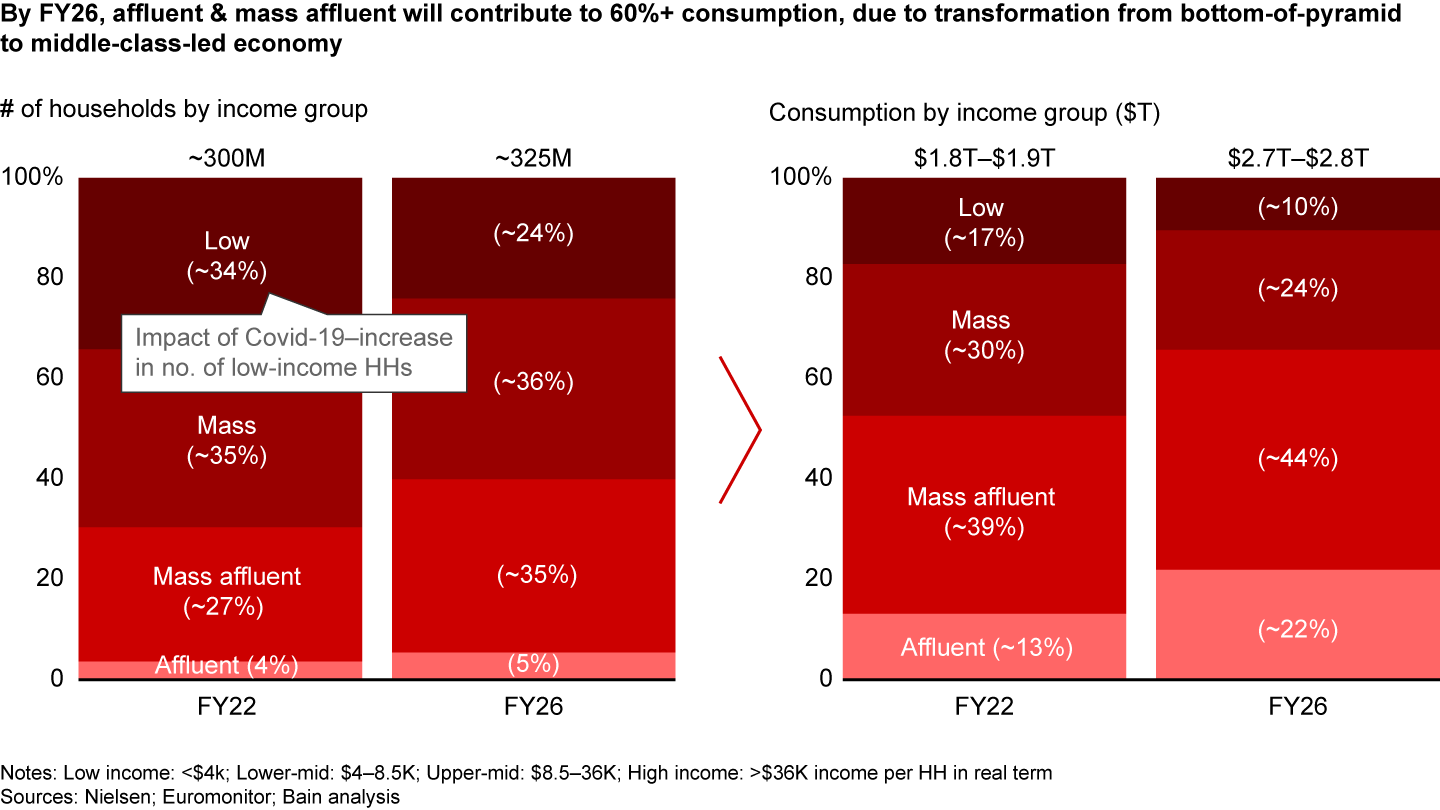
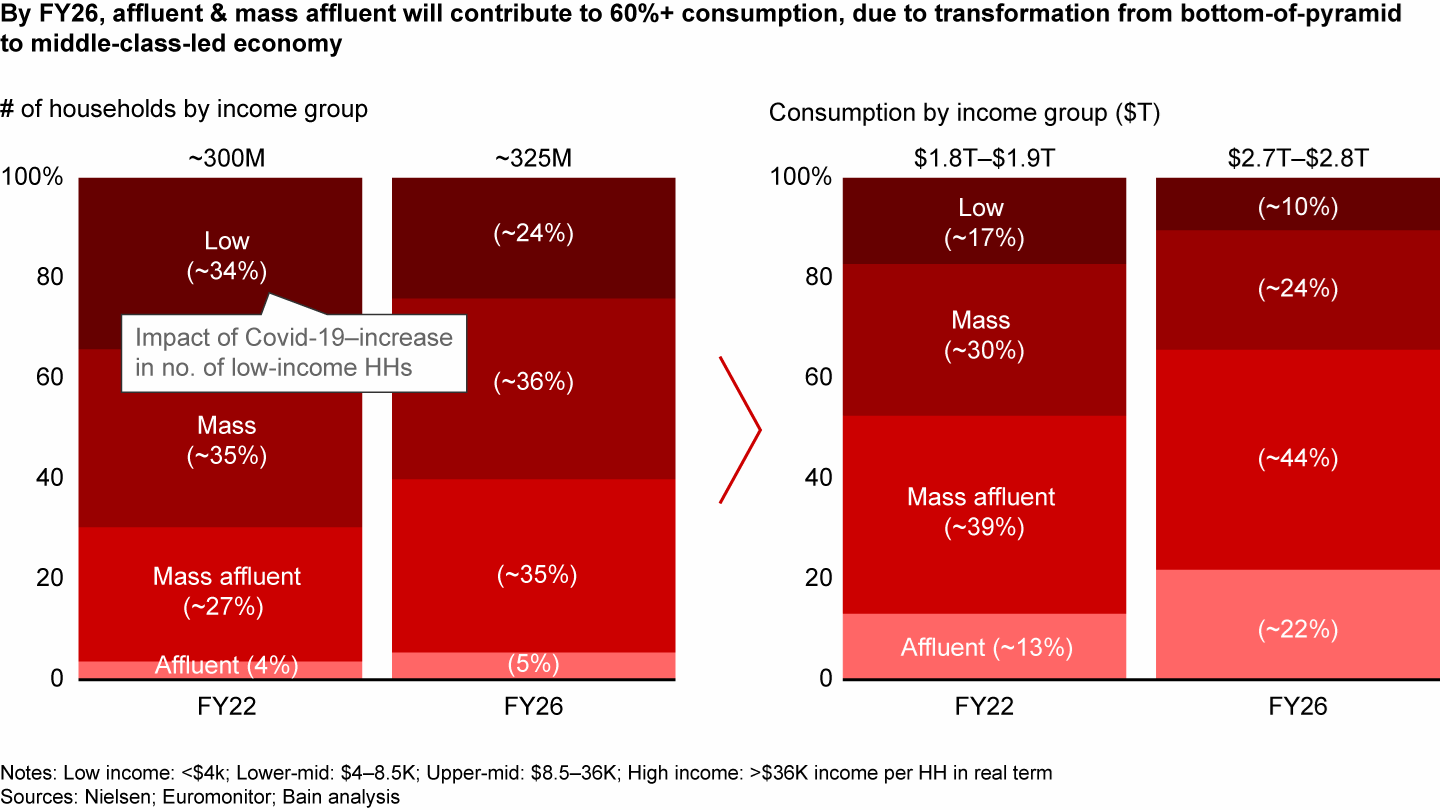
However, consumption financing across discretionary spending remains low with <5% credit penetration for many spend categories, such as travel, lifestyle, health, etc.
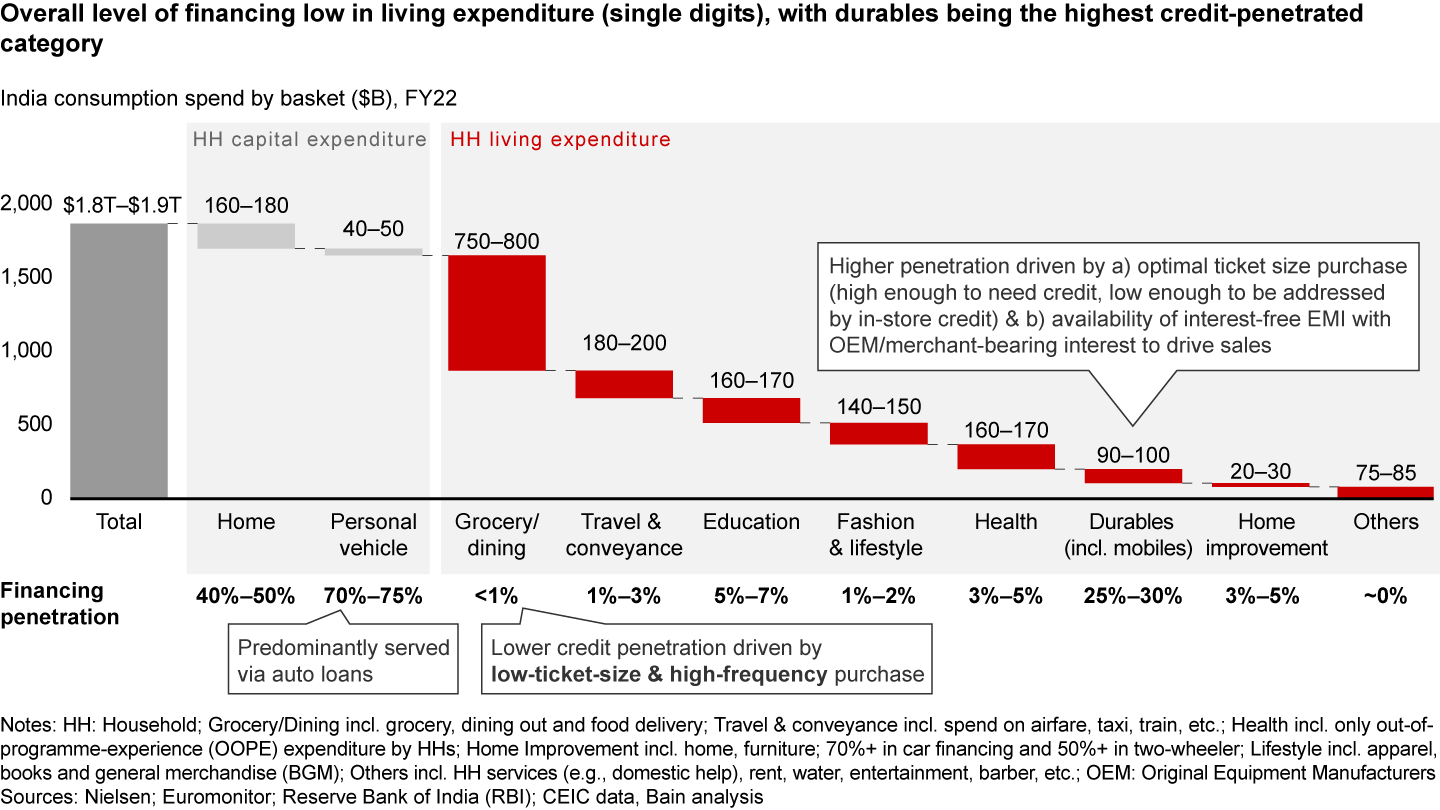
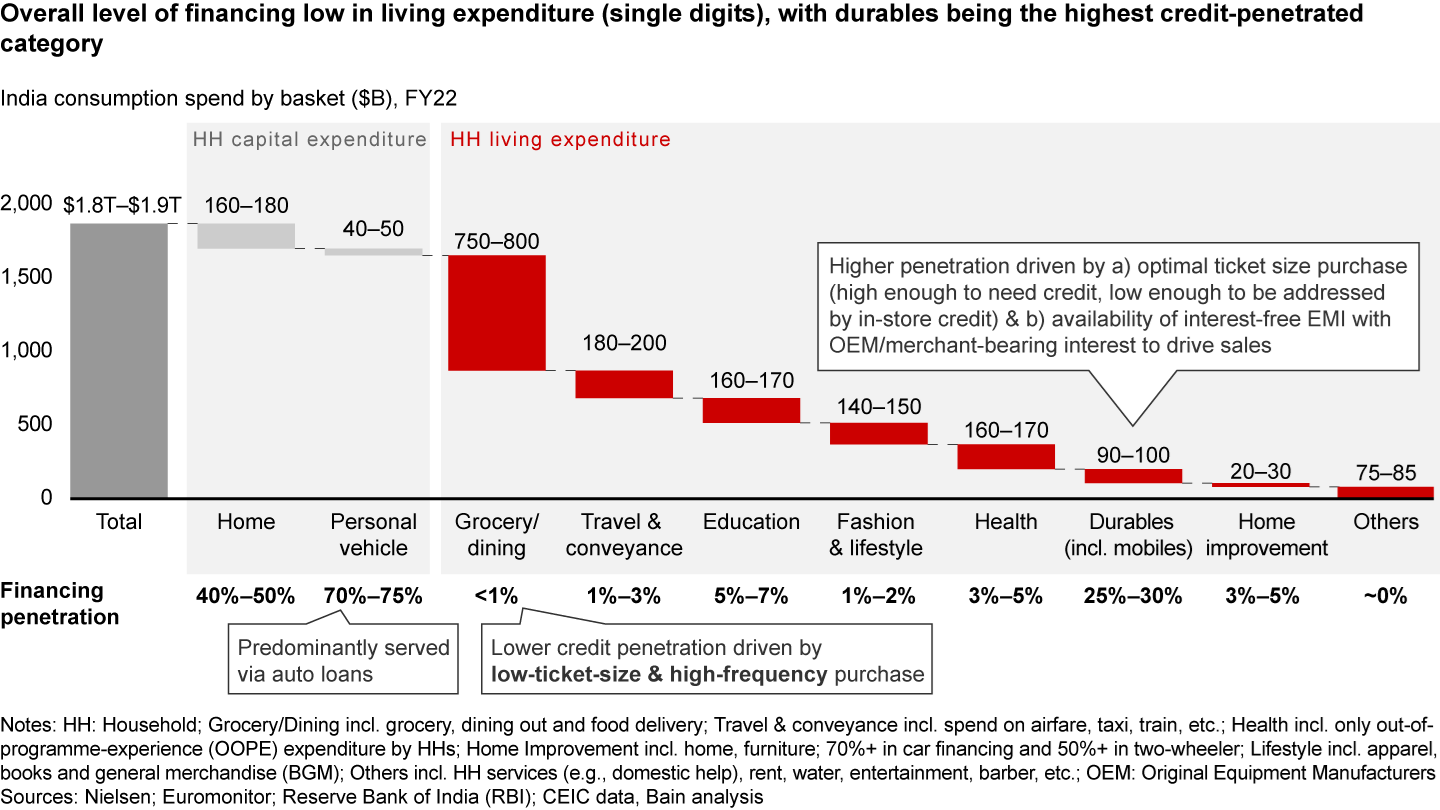
The MSME segment is also projected to grow at a healthy rate and contribute $1.3T to India’s GDP by FY26
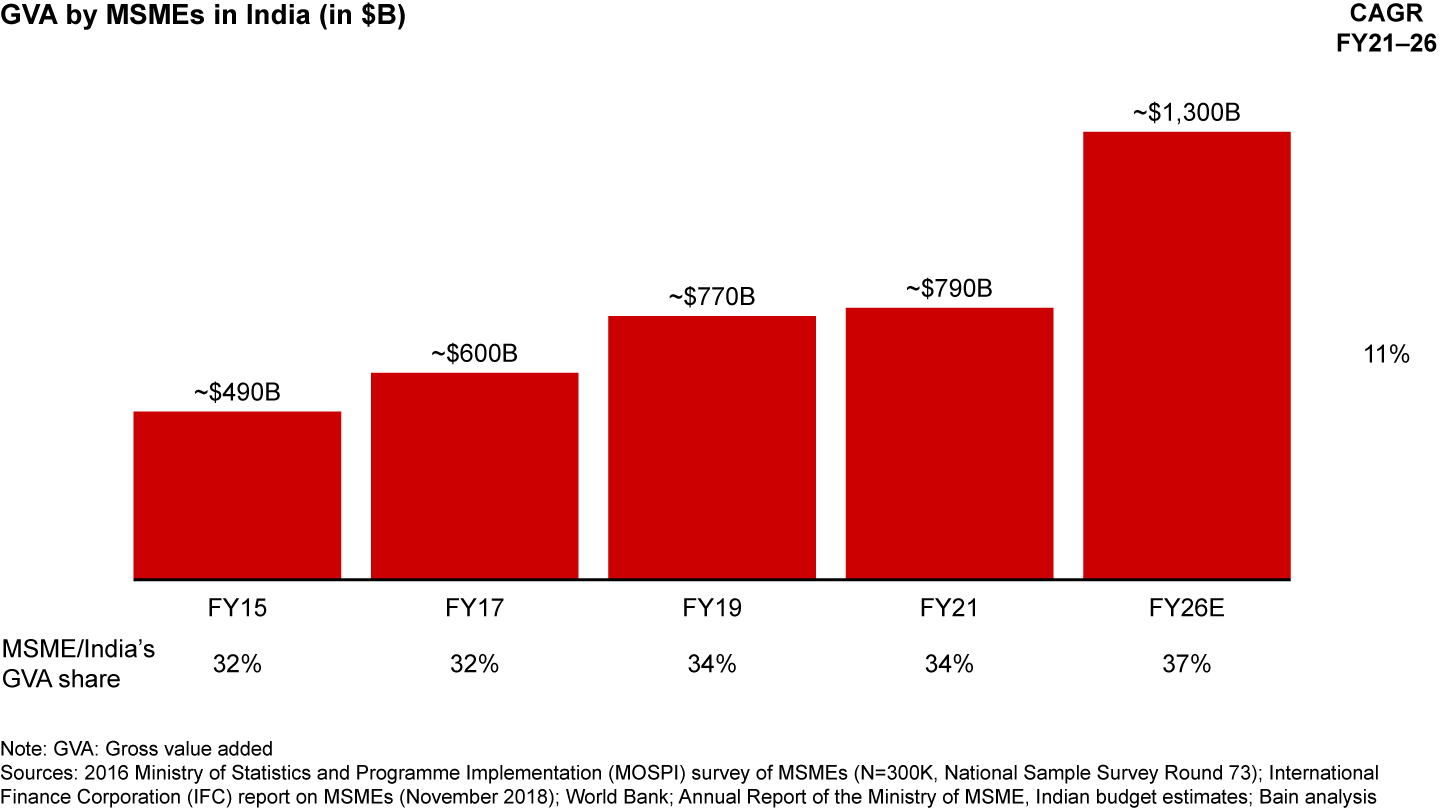
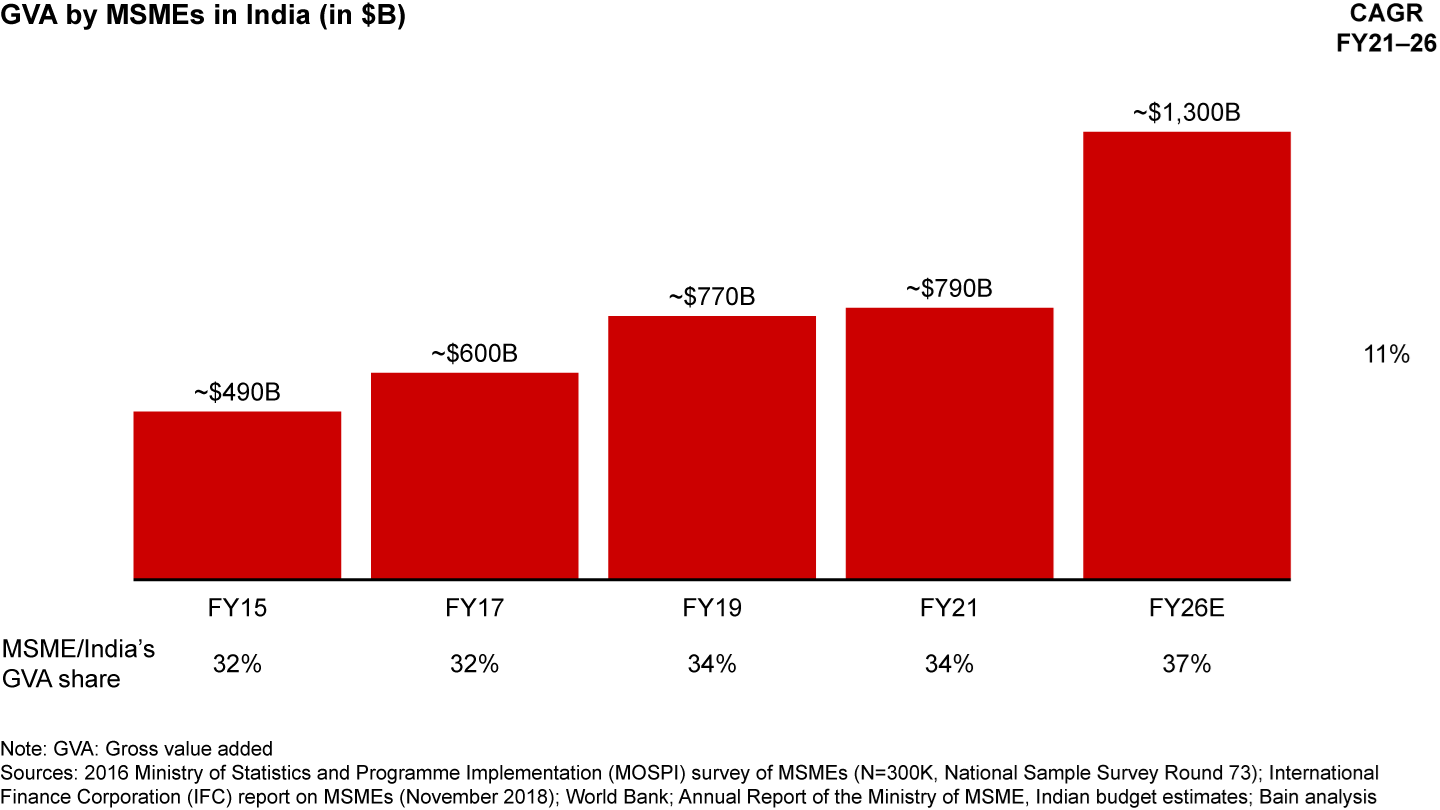
MSMEs, however, lack access to formal credit and rely on costly informal sources; share of formal credit in overall debt demand remains low (~<40%) across categories, most notably in micro and small enterprises
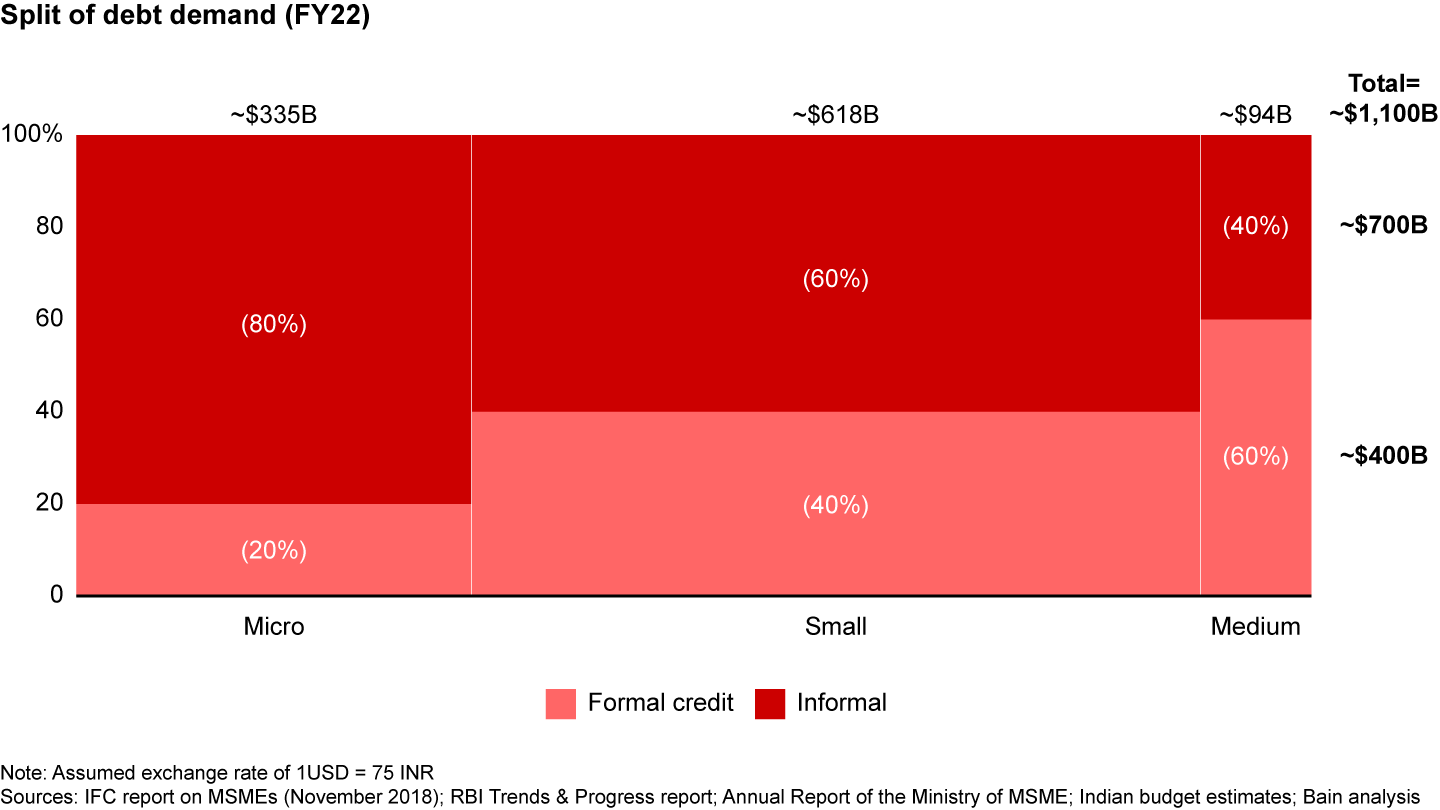
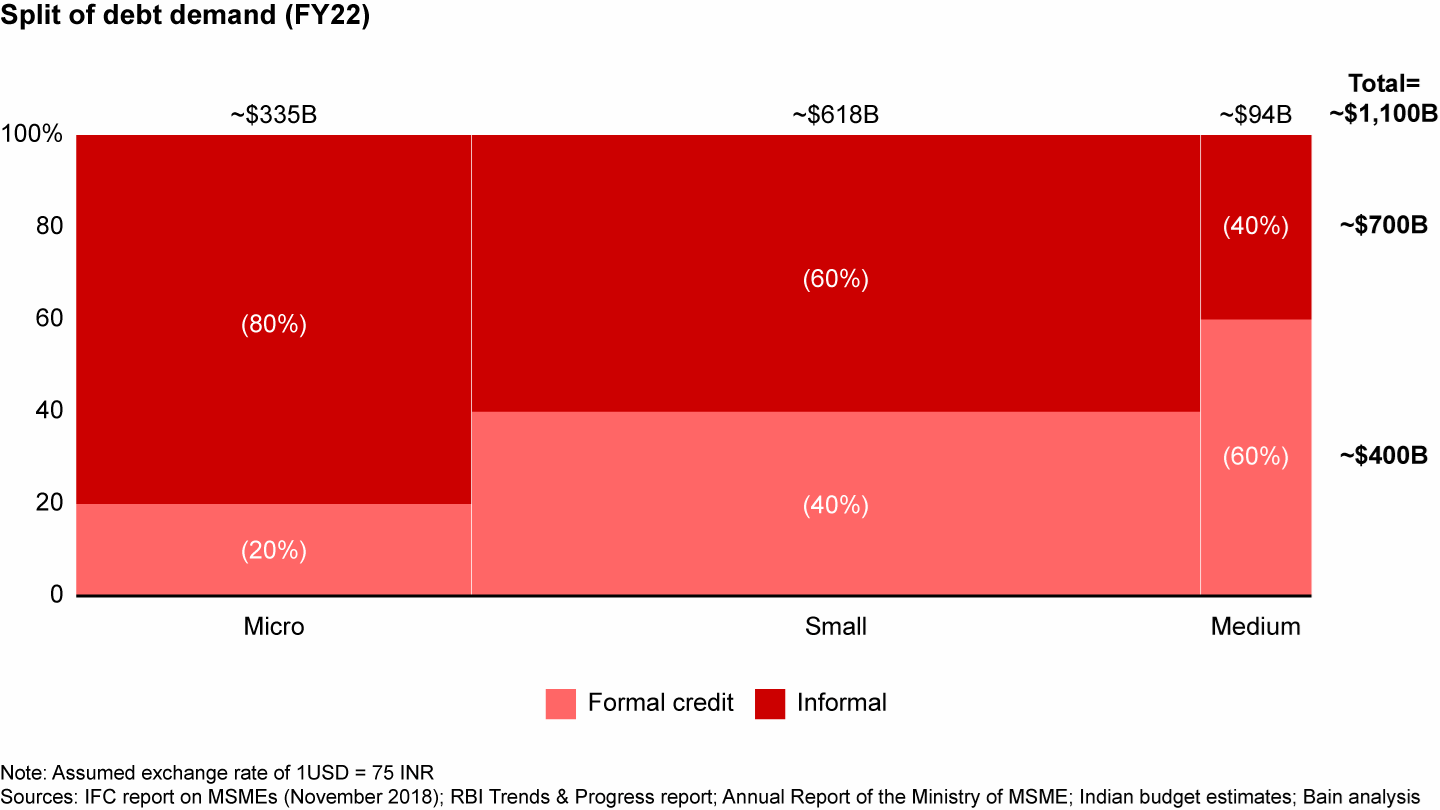
The digital ecosystem is primed to support the growth of fintech; customer purchasing behavior is shifting towards more online buying
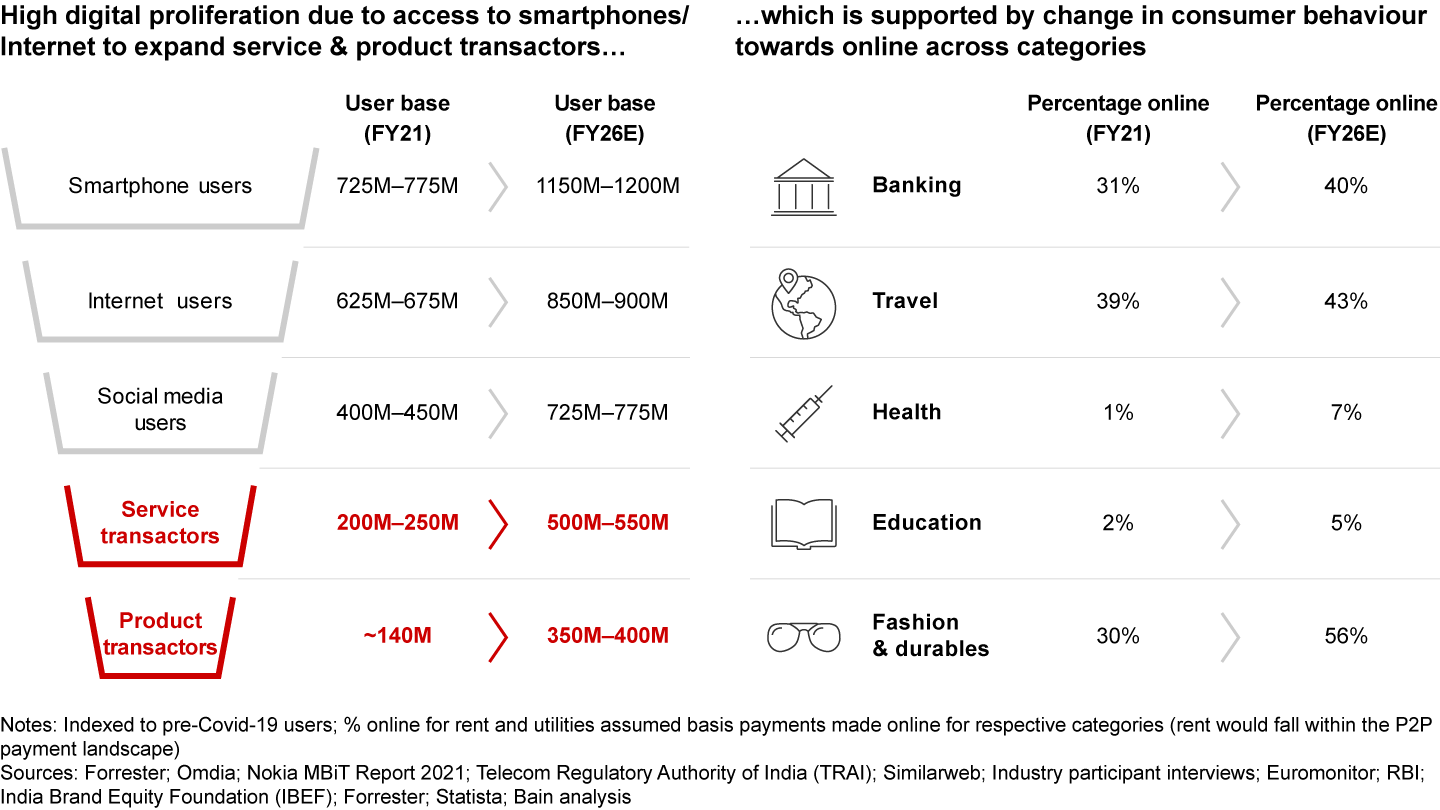
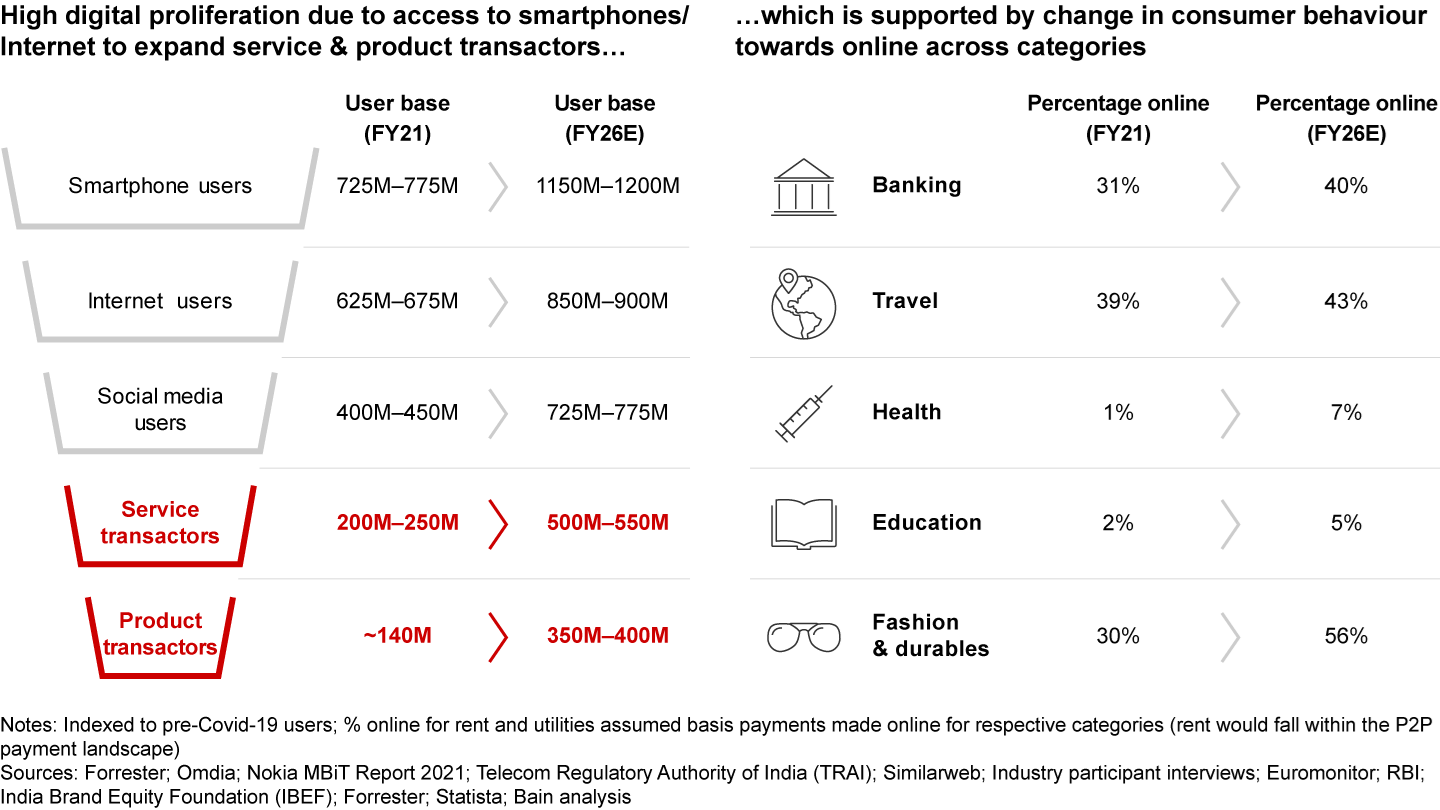
While traditional players will remain key beneficiaries of formal credit growth, fintechs will increase market share over the next five years
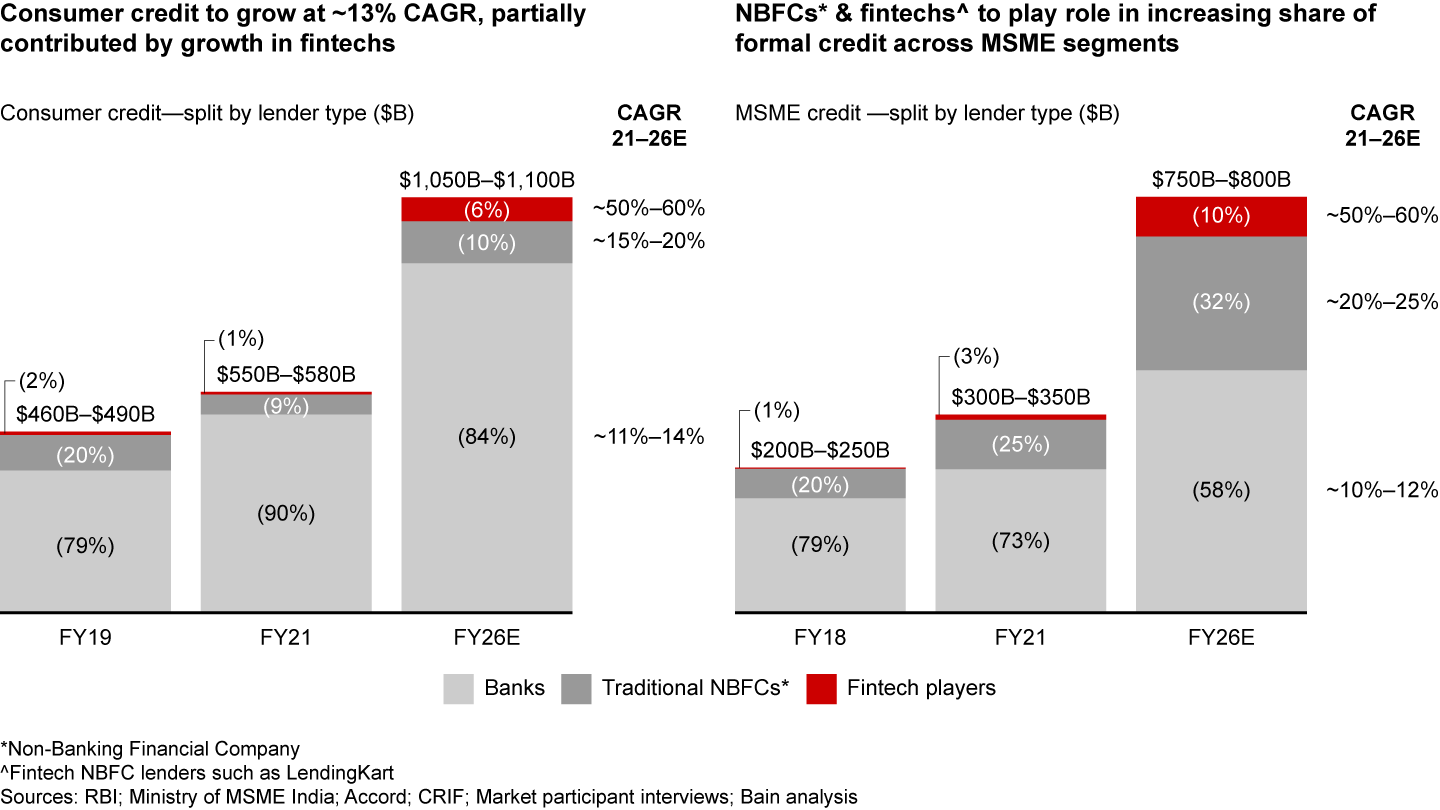
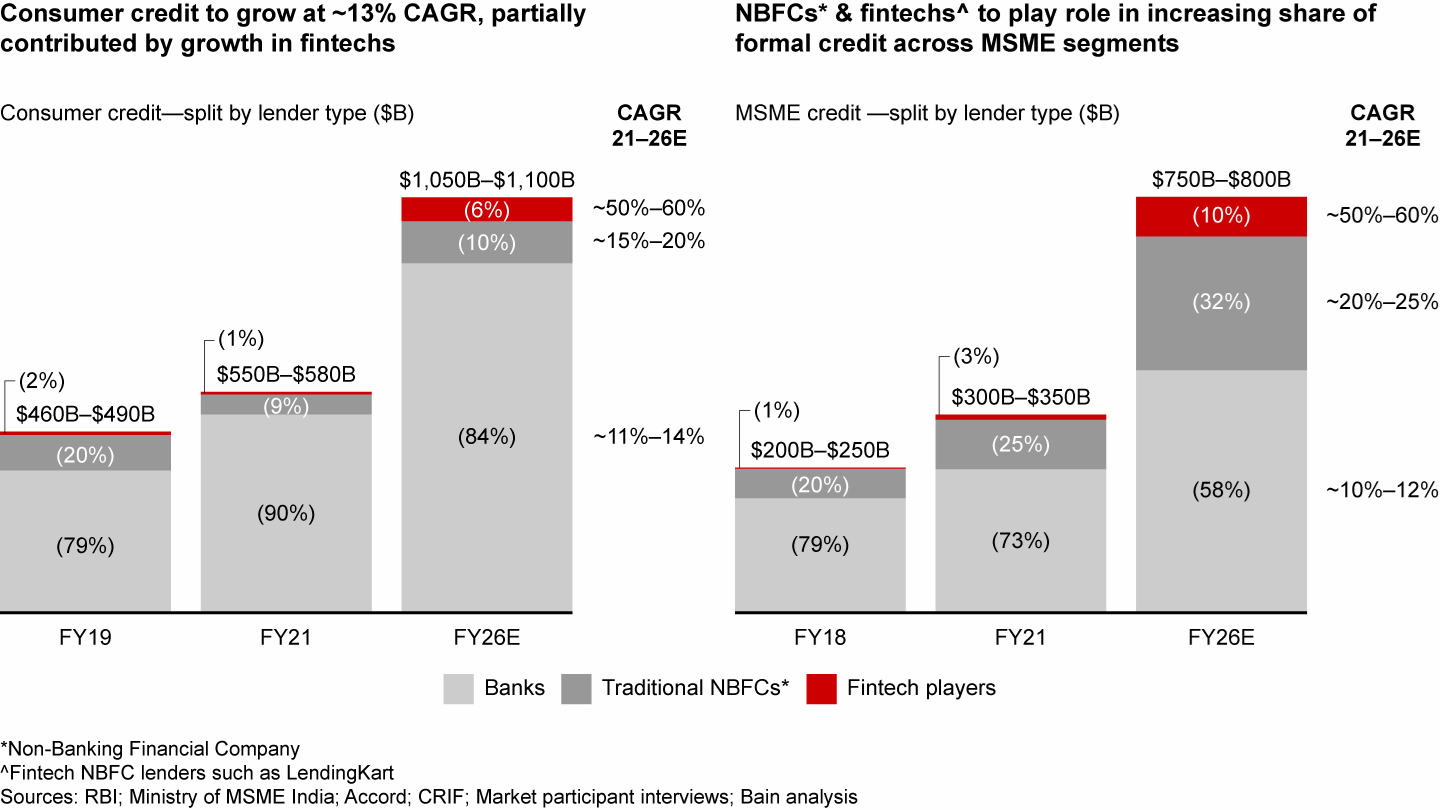
Fintechs have established a strong foundation in the payments space thanks to UPI, which has transformed digital payments and contributed to transaction values ~9x that of CCs over four years
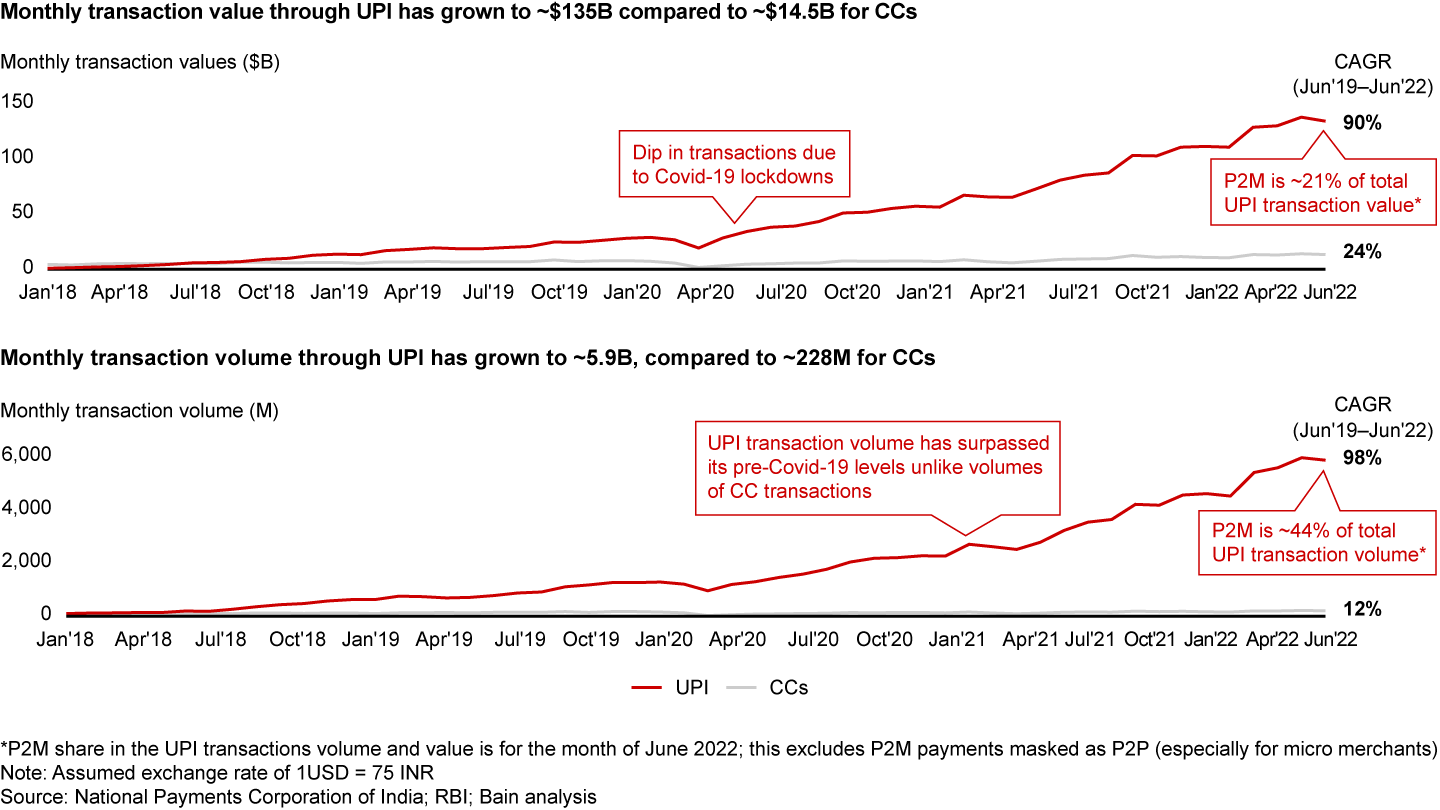
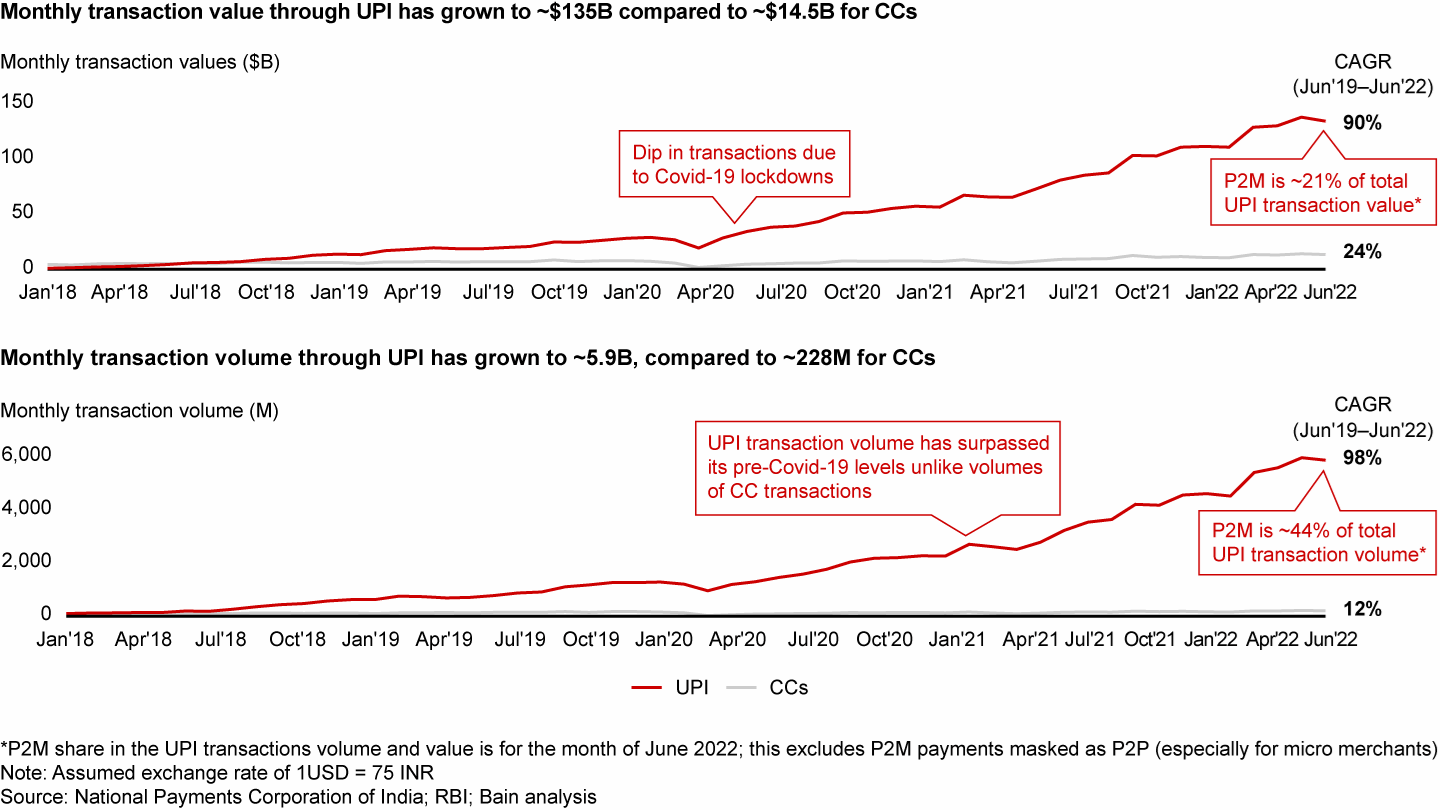
While fintechs have taken a lead in digital payments, their presence in other financial services categories is gradually expanding
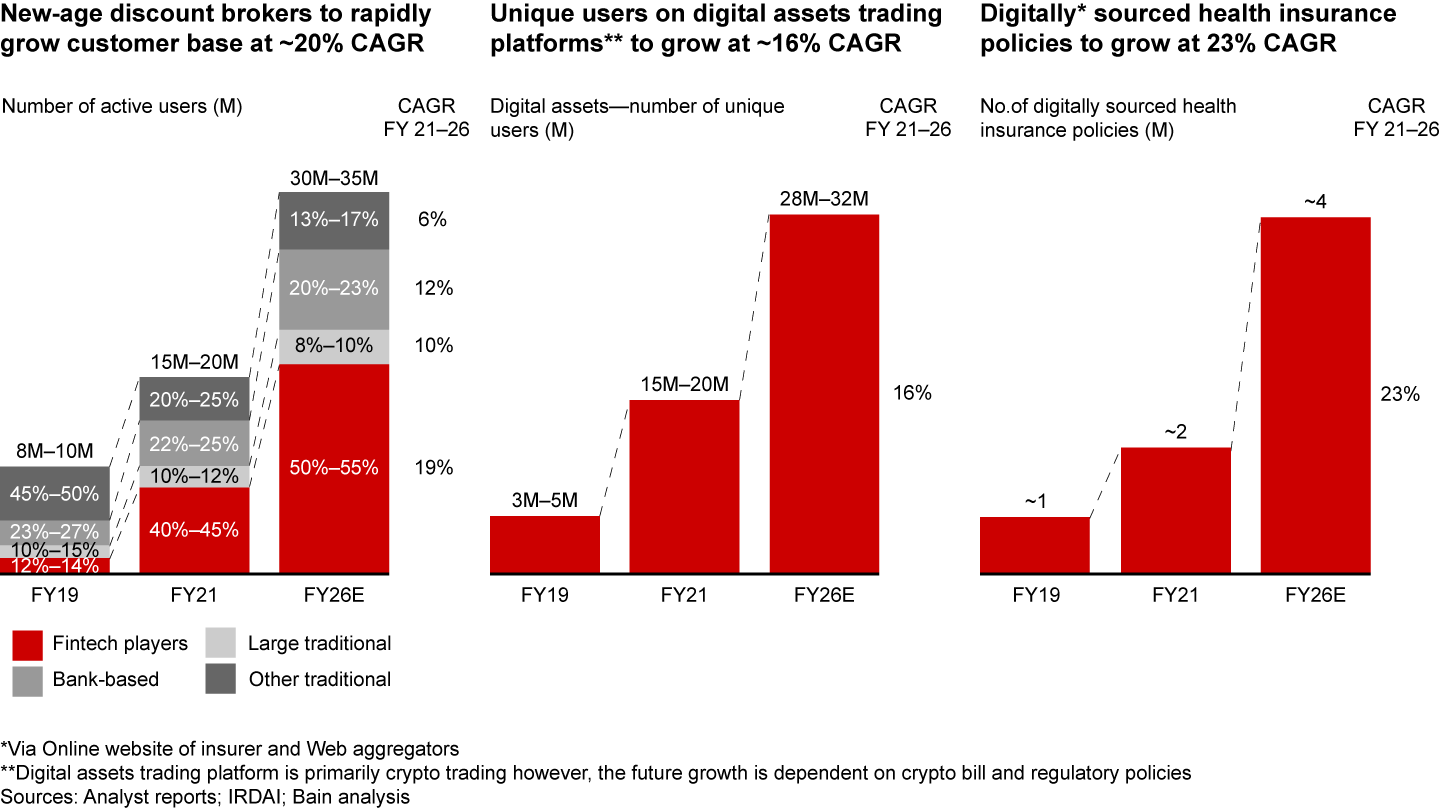
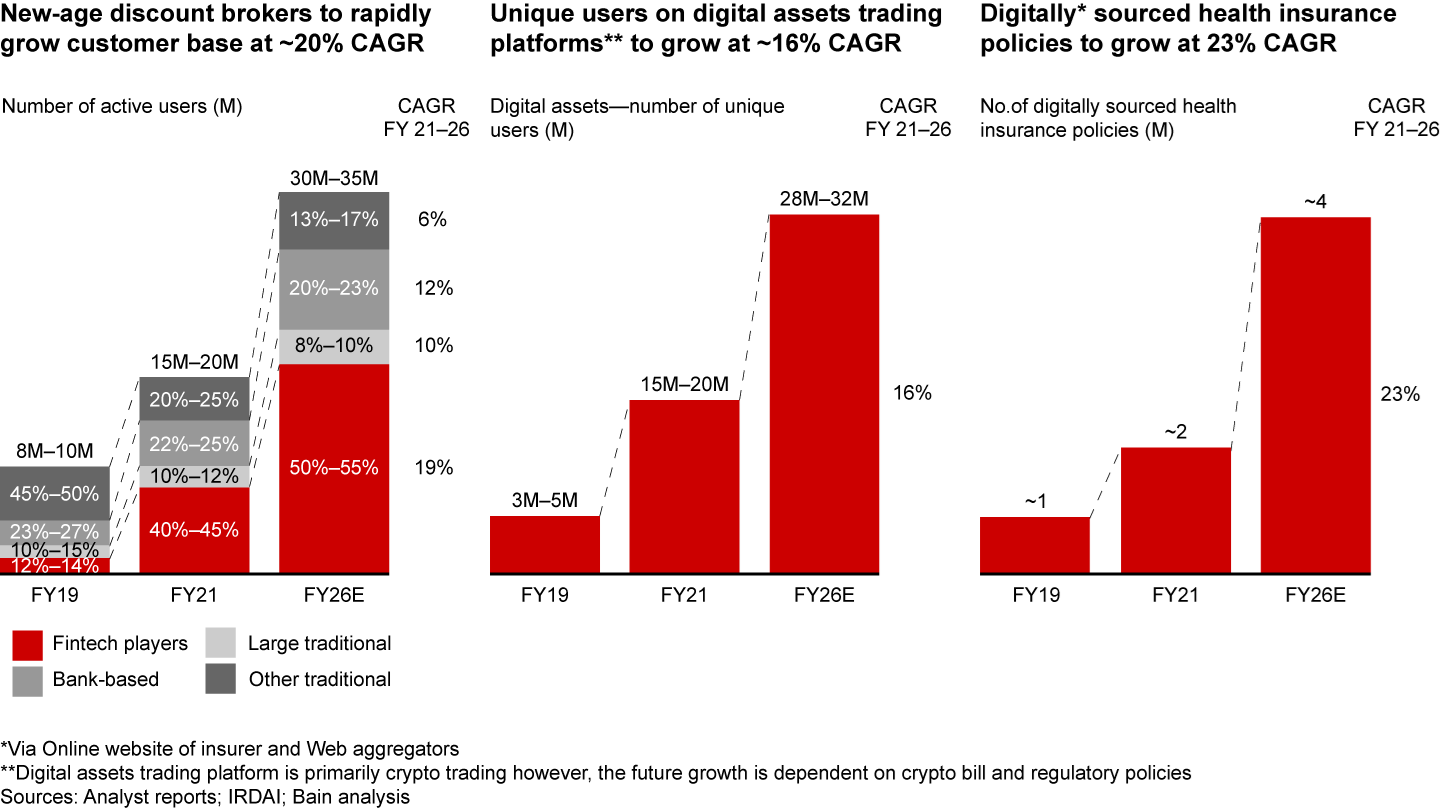
Evolution of fintechs in India
- Currently accounting for about 7% of India’s $1.4 trillion FS EV, the fintech sector is expected to grow to $350 billion in EV by 2026, representing nearly 15% of FS market cap.
- The Brazilian market, with similar macro fundamentals and demographics to India, saw fintech’s share in FS market capitalisation grow from 2% in 2017 to 35% in 2021.
- Covid-19 led to transformational shifts in consumer behaviour and accelerated digital adoption:
- Non-cash payments soared, with more than 75% year-over-year (YoY) growth in UPI transactions between FY20–21.
- Digital lending apps (DLAs) accounted for more than 60% of loans disbursed by nonbank financial companies (NBFCs) in FY21.
- Over 35 million demat accounts were added in FY22 (till Nov’21), thereby increasing the tally of demat accounts by 63%, from 55 million in FY21 to nearly 90 million in FY22.
- Indian fintechs witnessed record investment and deal activity, receiving approximately $10 billion in funding across more than 580 deals in FY21, which was three times the $3.5 billion received in 2020. The first half of 2022, has seen conservative funding of $4.2 billion, which is lower than H1 FY21, but twice the funding received in H1 FY20. While payments and lending continue to attract the bulk of funding (60%), other segments, including financial infrastructure, wealthtech, and neobanks, are now catching up.
- Amassing a sizeable customer base through their core offerings, fintechs are now seeking to boost customer retention and engagement by introducing new revenue streams and cross-selling related services and products.
- Several winning elements underpin the success of India’s leading fintech unicorns, including:
- Relentless focus on customer needs within the identified target segment(s) to continuously innovate on value propositions (after the initial “hook” product) with superior customer experiences/journeys as table stakes.
- Focus on scaling customer acquisition through significant investments in marketing before driving efforts on monetisation.
- Initiatives for deeper customer engagement and higher retention, including activation campaigns, gamification, expert-moderated social communities, and education forums (e.g., educational courses and discussion forums for new investors).
- Long-term view on customer lifetime value (CLTV)/customer acquisition cost (CAC) from day one, translating to focus on organic acquisition and stitching together a value proposition that drives higher average revenue per user (ARPU).
- Gradual expansion into full-service ecosystems and super-apps across broader FS categories for greater engagement and monetisation (especially by UPI players and business-to-business [B2B] fintechs).
- Inorganic growth strategies, such as mergers and acquisitions (M&A) for product/market expansion, to add revenue synergies and enhance capabilities and carve-outs where needed for growth without impact on valuation multiples (e.g., carving out NBFC from core tech business).
- Partnerships with incumbents to obtain access to requisite licences, low-cost capital, risk management know-how, and access to bank platform for scaling up (BaaS) especially for neobanks and alternative lenders.
- Leading fintech decacorns and unicorns have managed to stitch together coherent ecosystems by expanding their core value proposition to drive higher engagement and ARPU.
- In payments, UPI players, such as PhonePe, gained scale and user growth by incentivising platform usage through rewards, creating an app-in-app ecosystem, and driving hyperlocal commerce with their merchant ecosystem and are now leveraging their scale to cross-sell other FS products.
- Wealthtech players such as Zerodha and Groww banked on their unique low-brokerage proposition to attract new investors while increasing activation through community engagement forums and educational resources.
- CC bill payment player CRED prioritised building a prime-plus customer base on its platform and driving engagement through its store, gamified rewards, etc.over early monetisation, eventually monetising its customer base by venturing into lending.
- Merchant-focused payment players, such as Pine Labs and Razorpay, are building one-stop solutions for merchants. They started with payment acceptance; expanded to consumer lending at POS, merchant working capital financing, and business management solutions for merchants; and are now expanding from online to offline and vice versa and into new segments like neobanking.
- Neobanks such as Jupiter, NiyoX, and Fi have started with a hook product for millennials or MSMEs that is either credit-led, deposit-led, or software-led (for MSMEs) and are now expanding into other FS segments after acquiring scale.
Home to more than 7,000 fintech start-ups and the highest number of unicorns in the region, India has emerged as the front runner in the fintech landscape in Asia
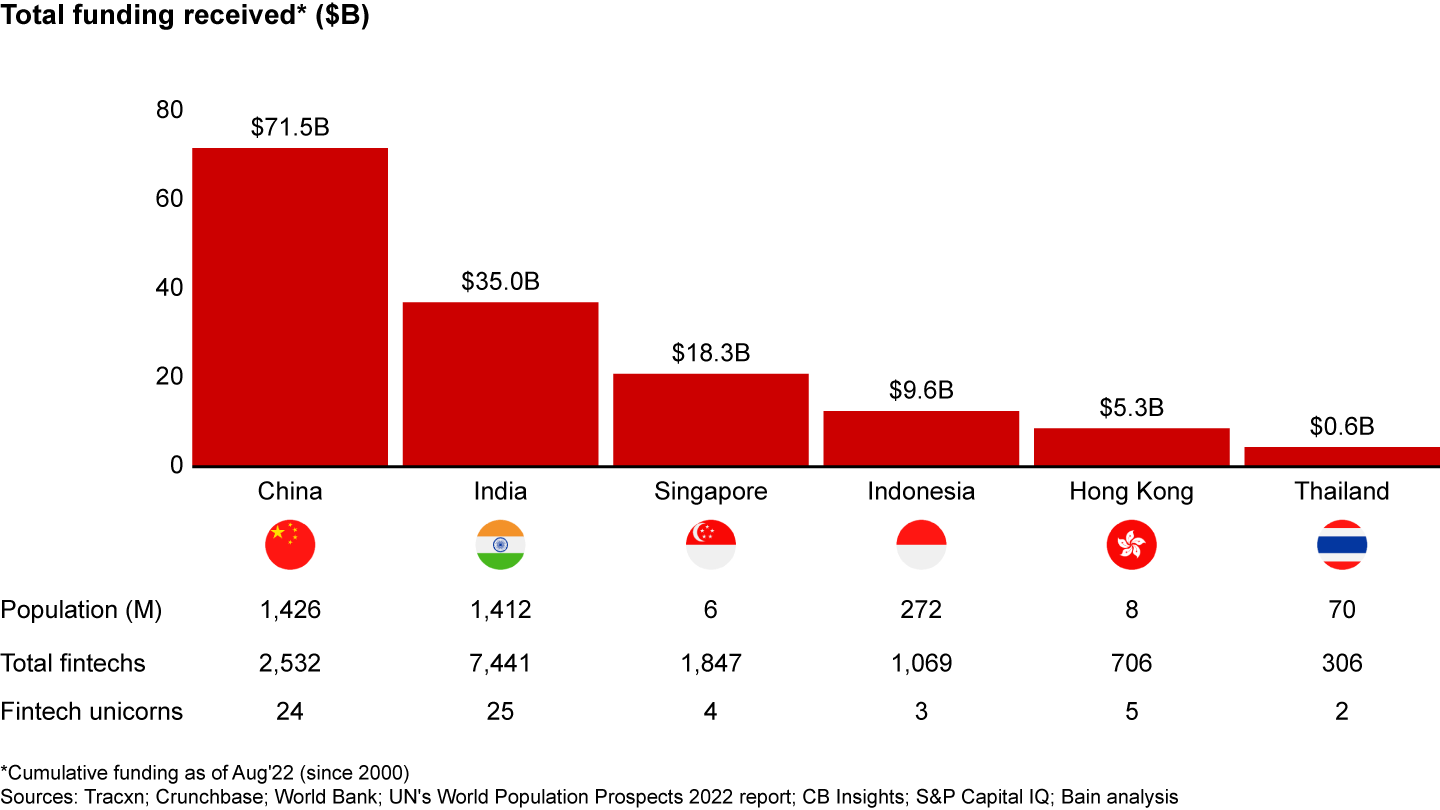
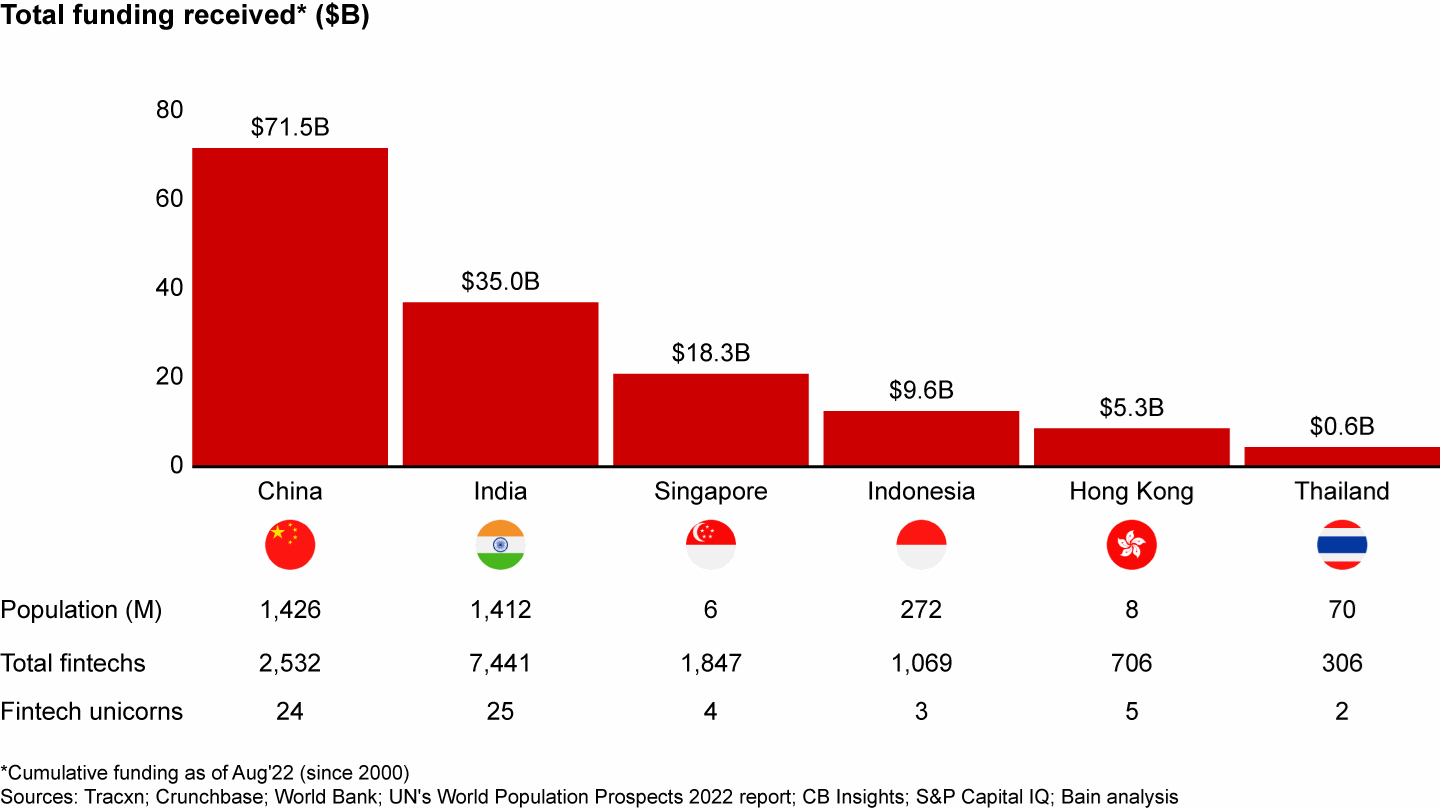
With favourable demographics and increasing digital adoption, this sector is expected to disrupt the $1.4T financial services sector in India and capture $350B in EV by FY26E
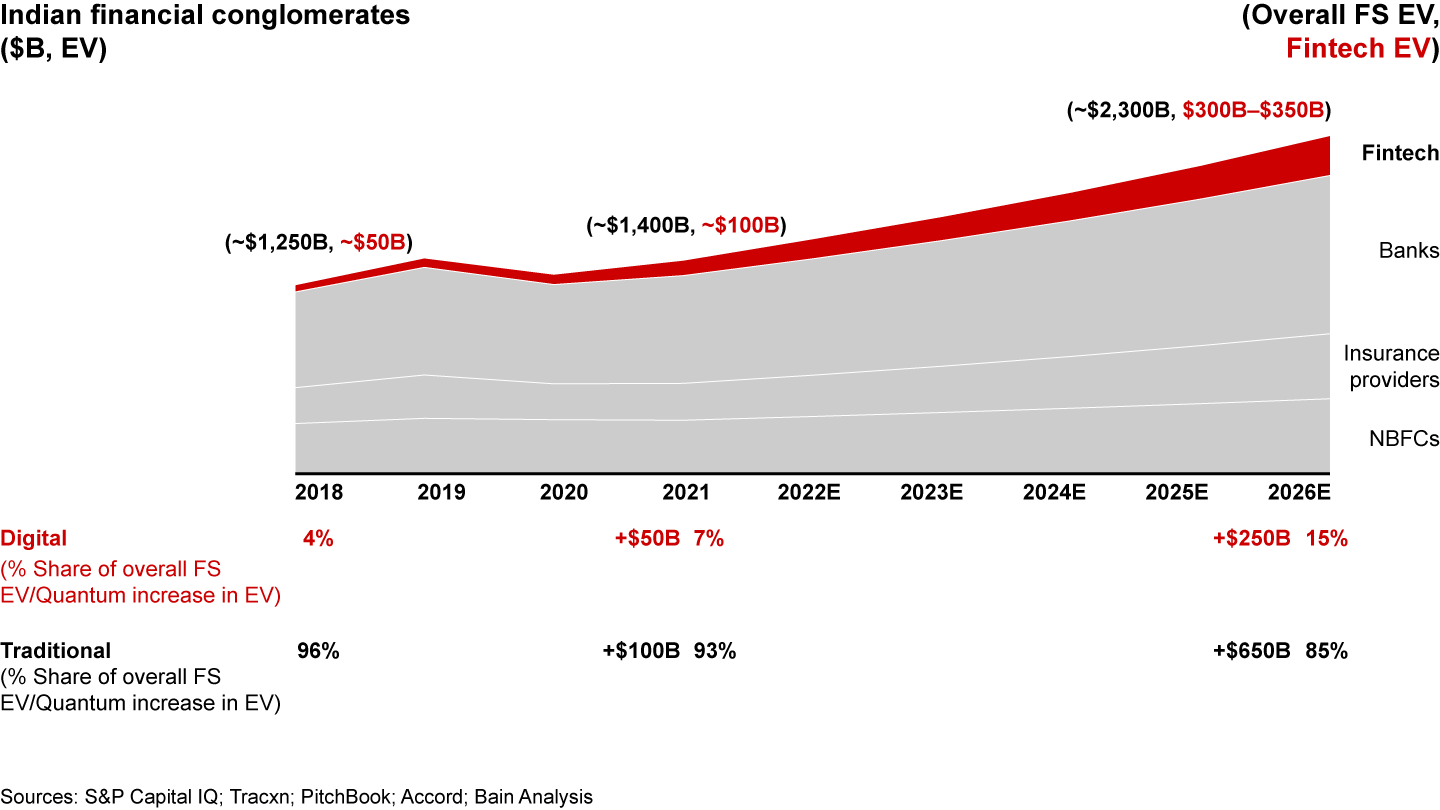
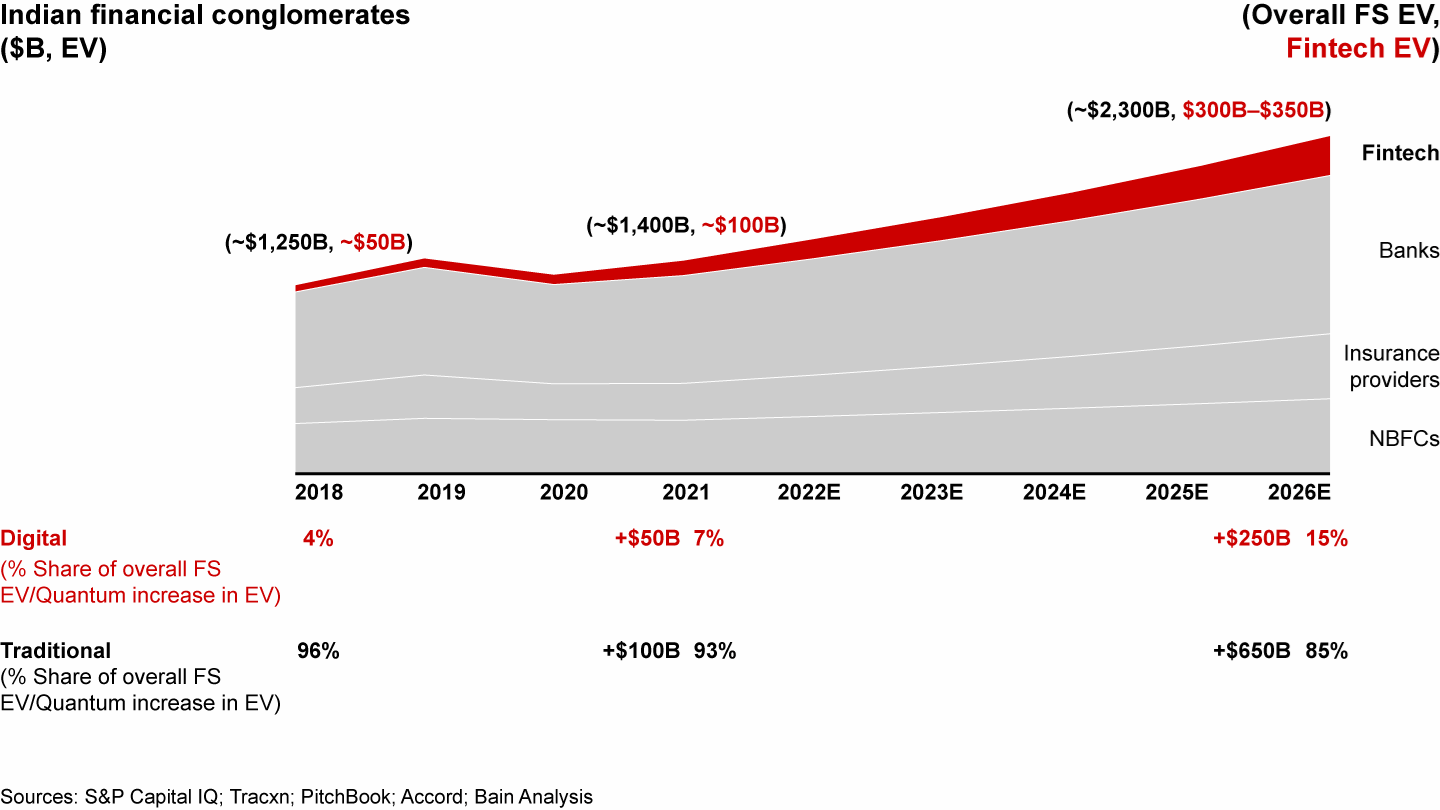
The pandemic accelerated digital adoption across multiple segments, building consumer acceptance of fintech-based digital solutions
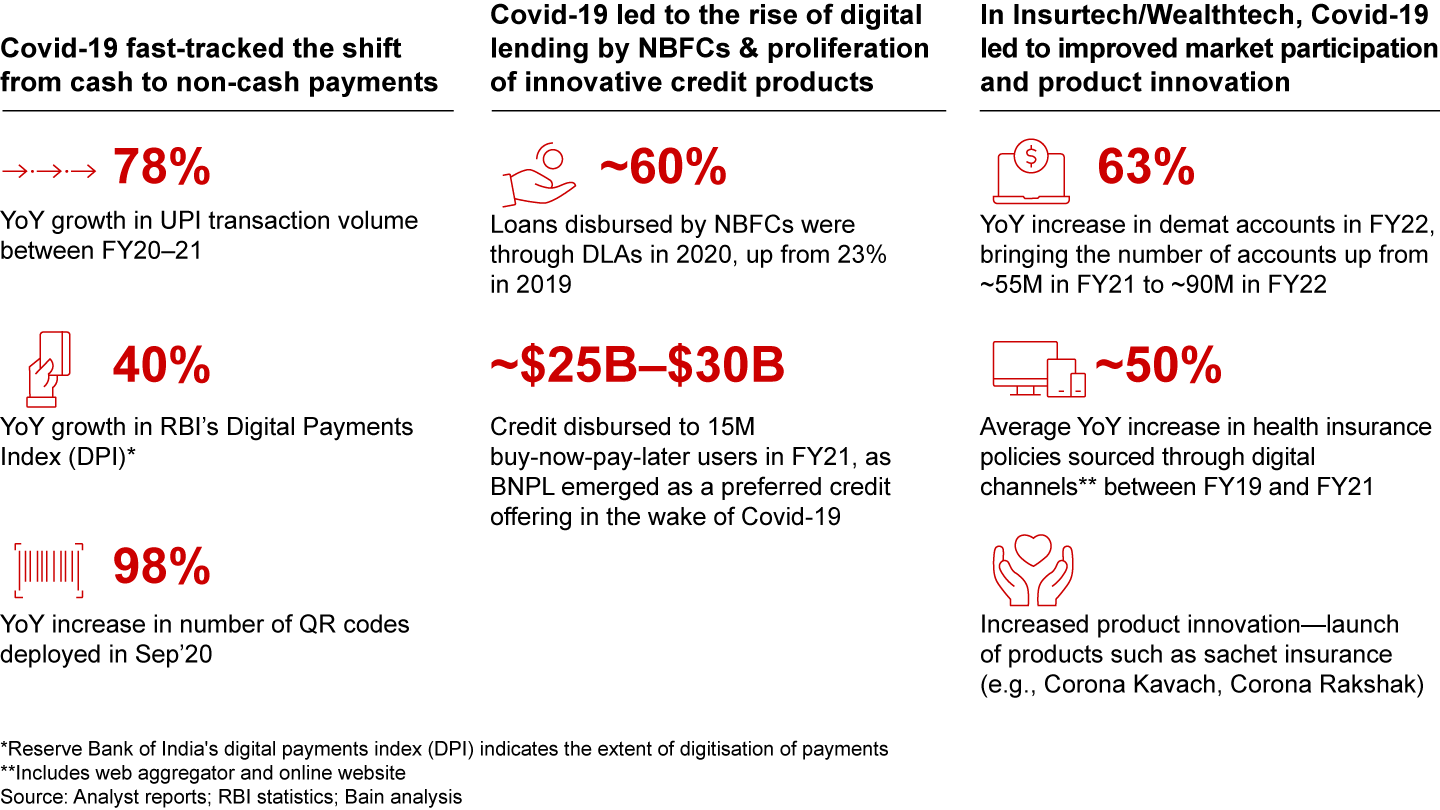
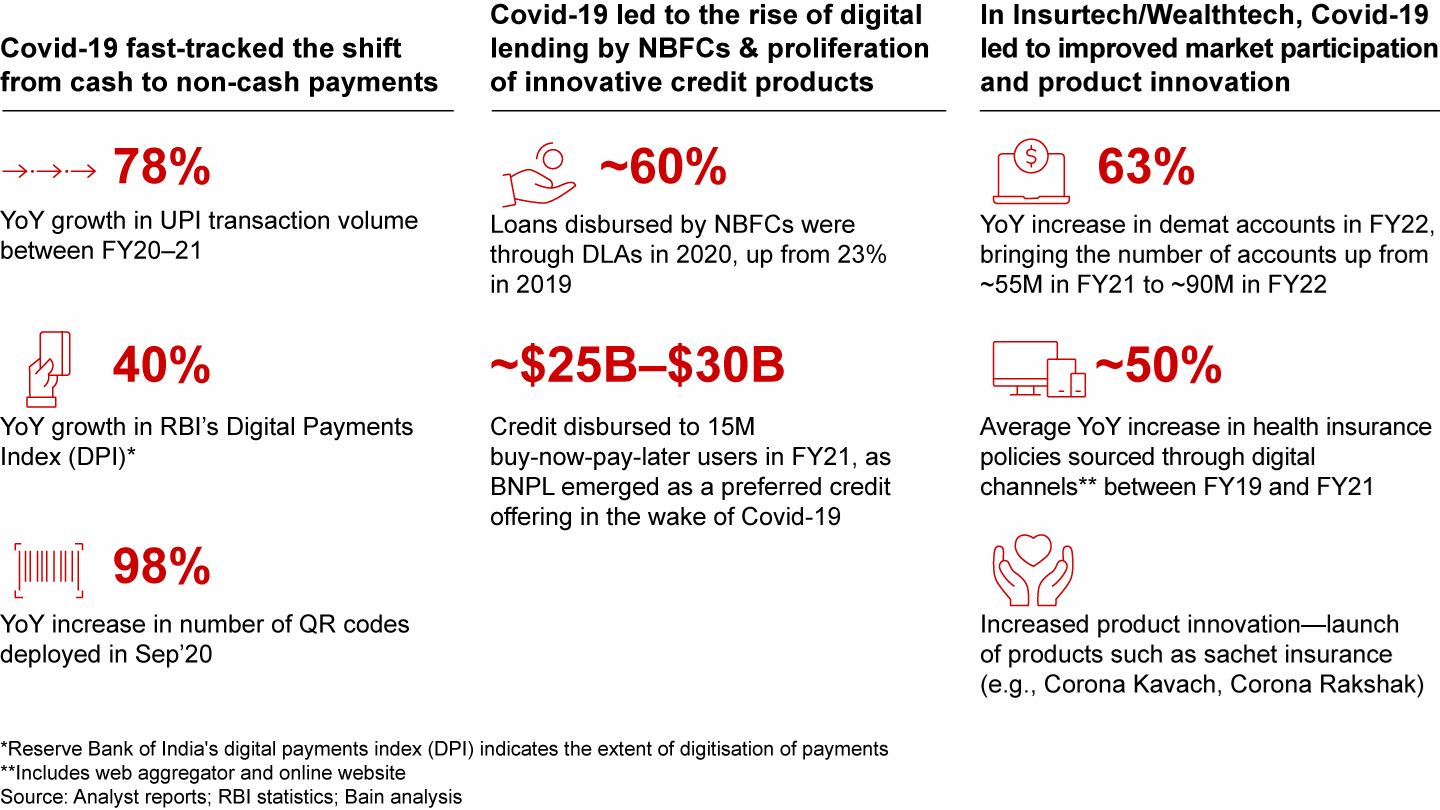
Fintech funding in India has increased impressively in recent years; while payments and lending have garnered the majority share of funding, other segments such as wealthtech, insurtech, and neobanking are fast catching up
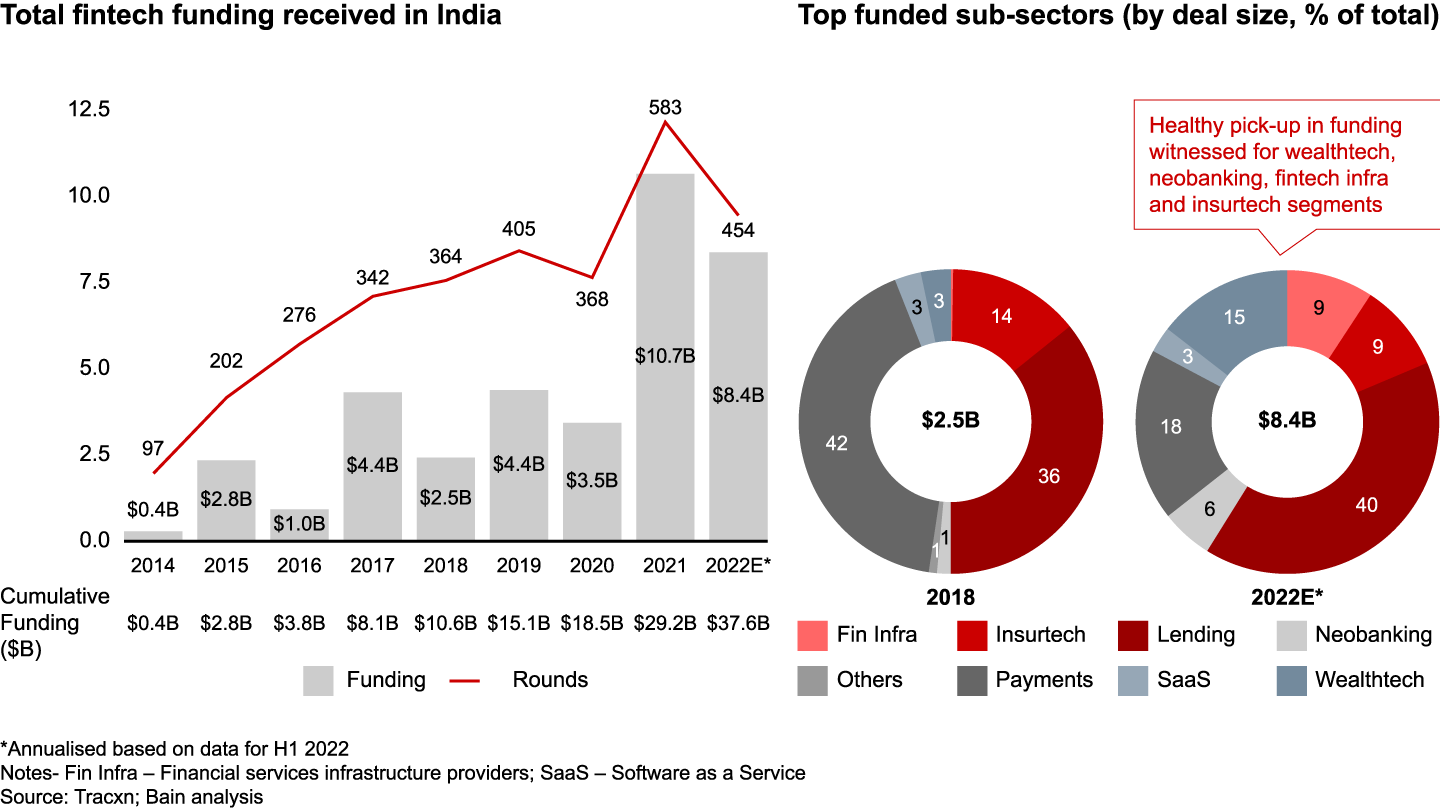
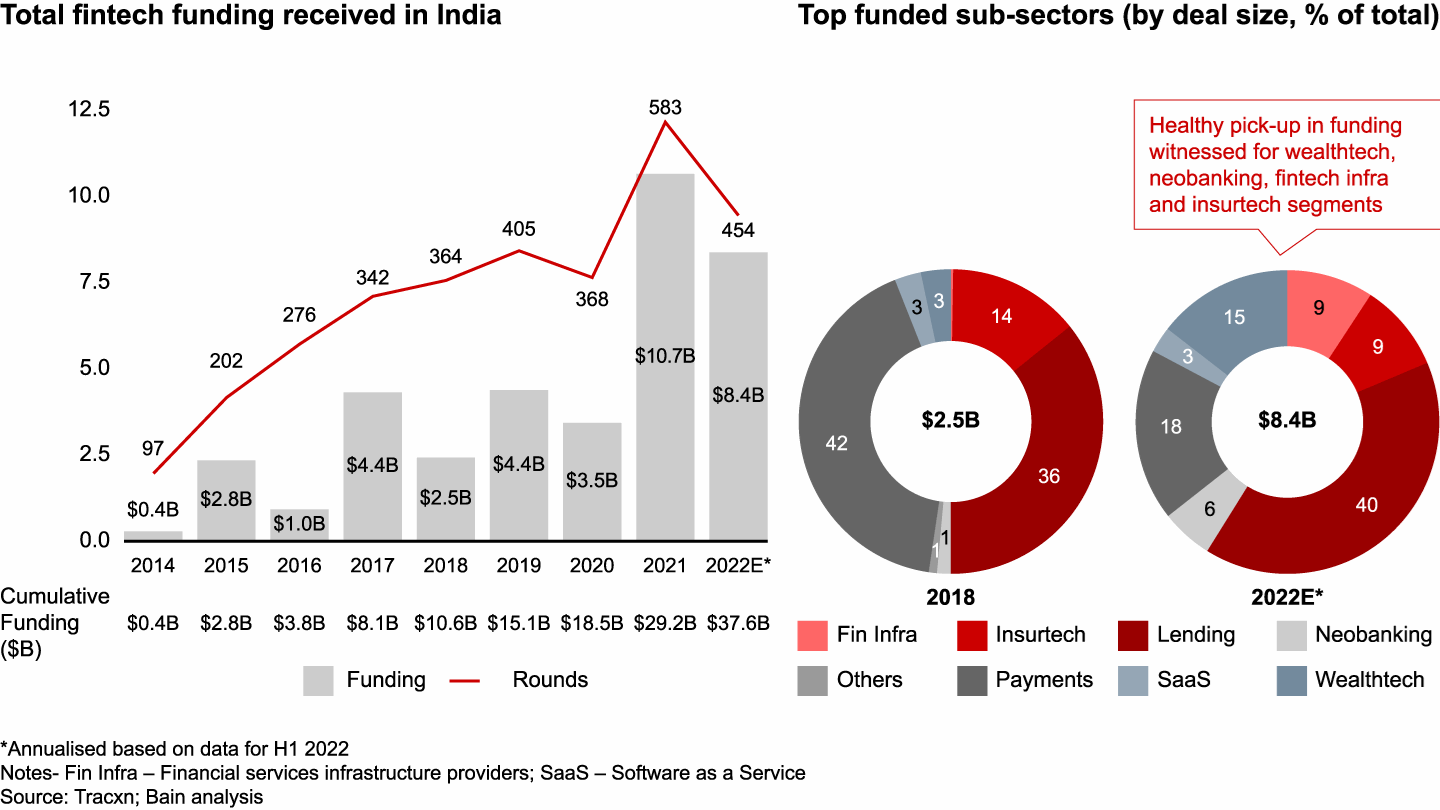
In 2021 and 2022, India witnessed the addition of 15 fintech unicorns in segments beyond payments
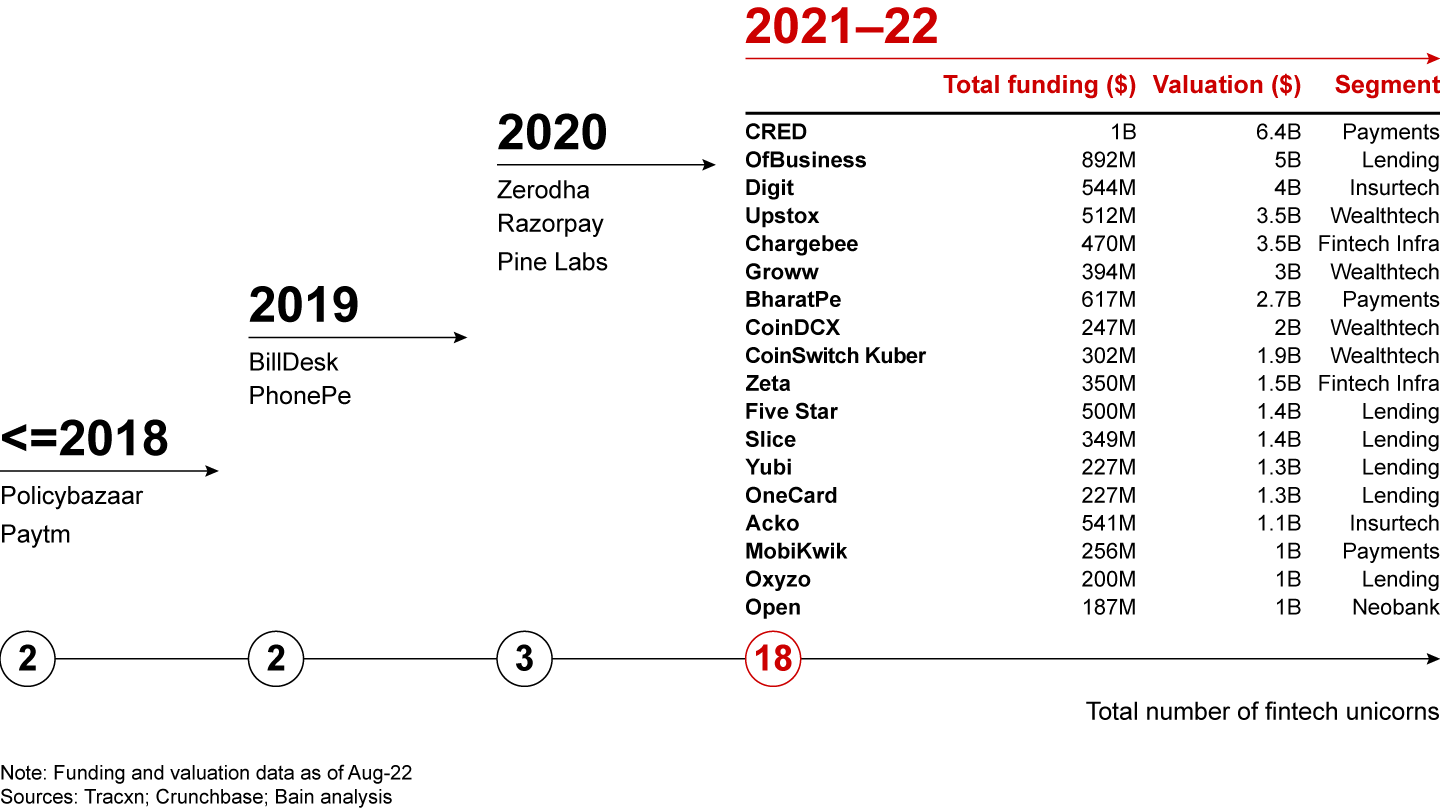
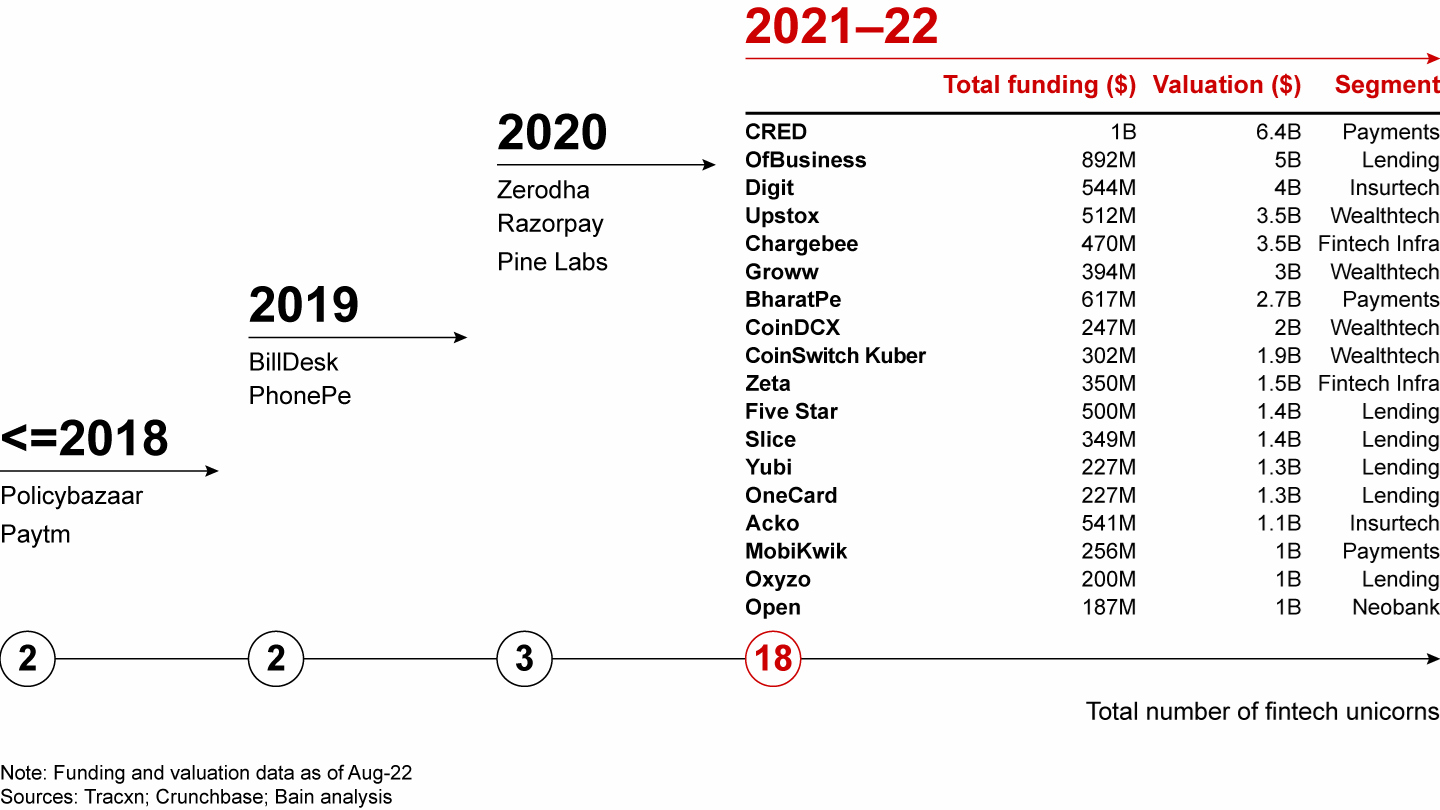
Indian unicorns adopted a variety of strategies to achieve scale, user growth, and market expansion
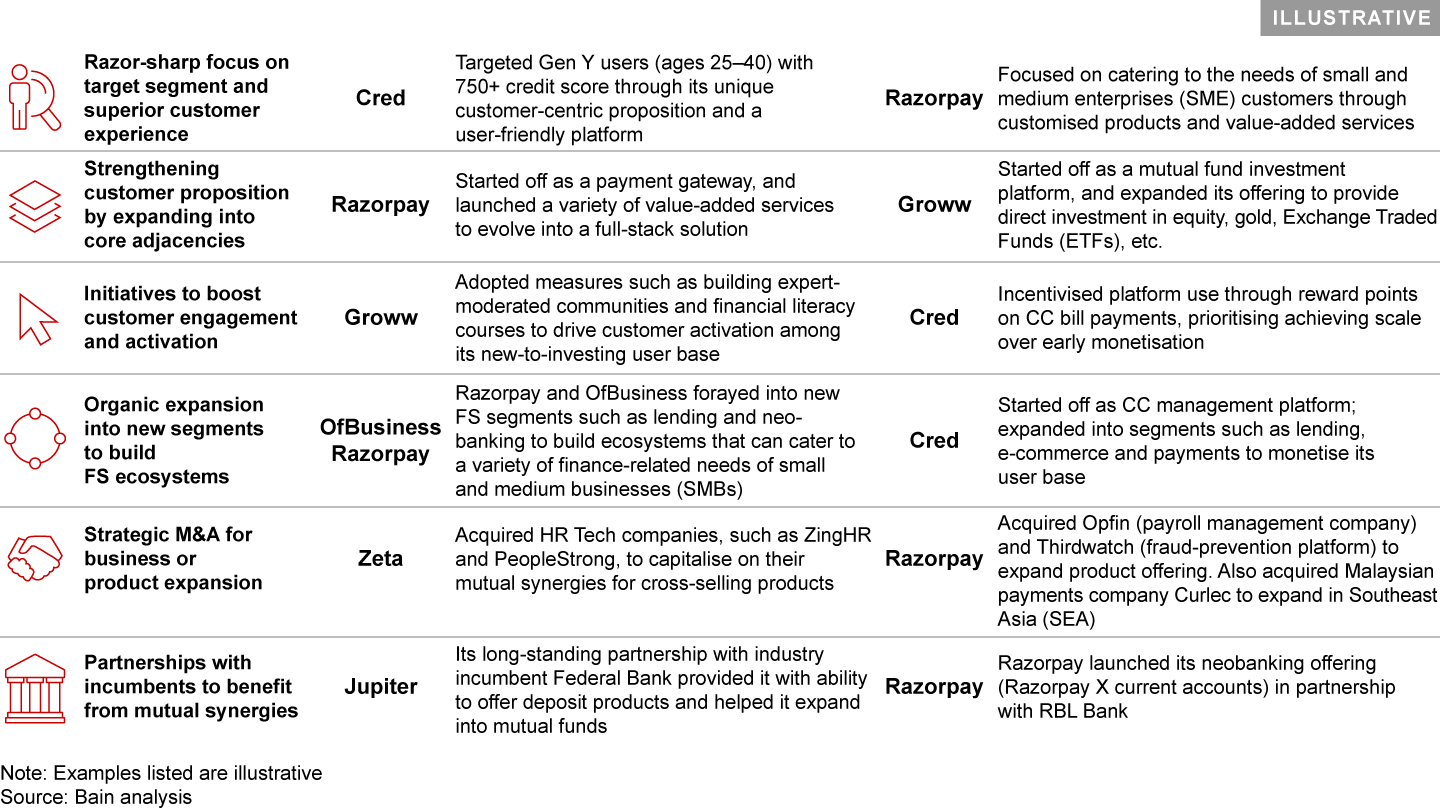
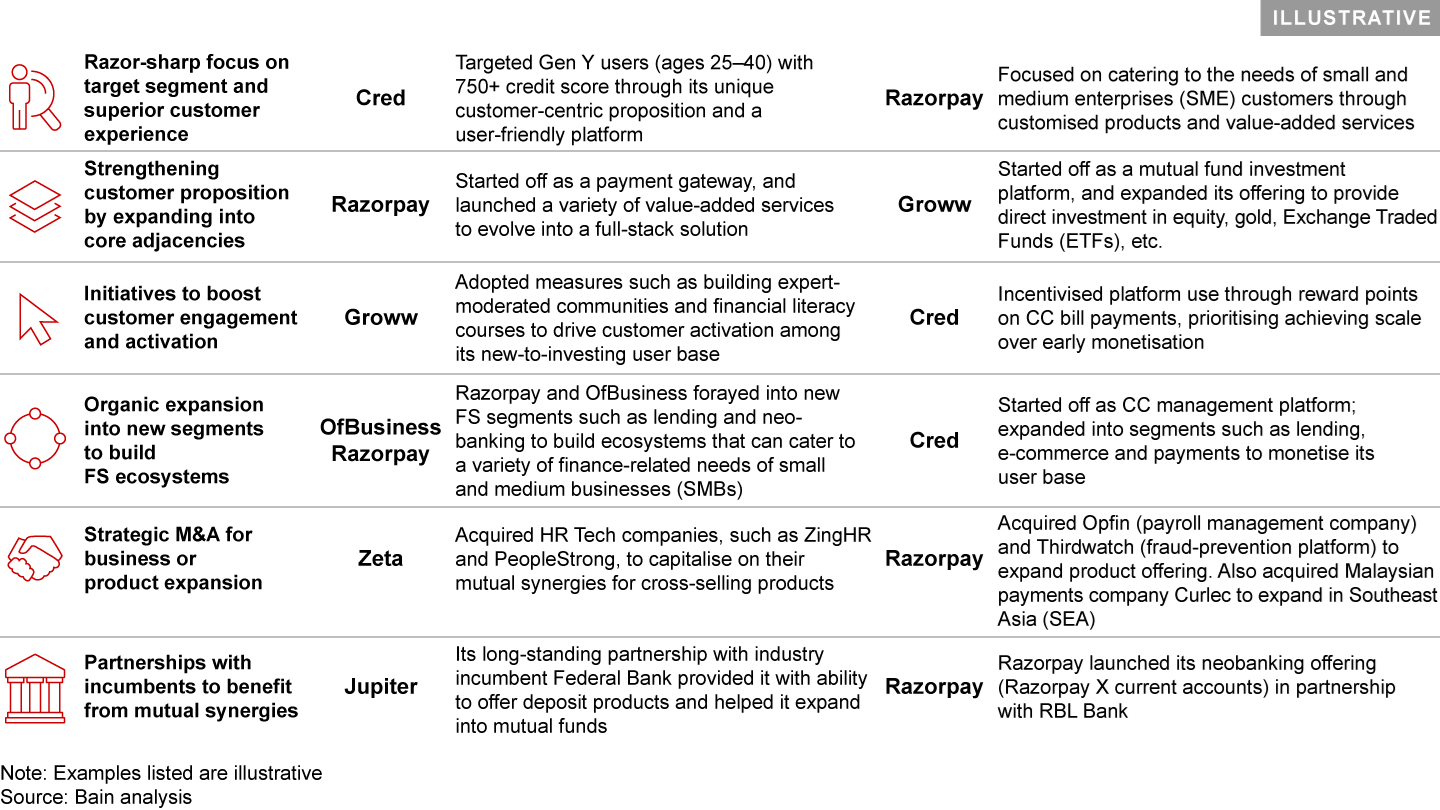
Diverse themes have emerged in the past across financial services segments and have disrupted the industry
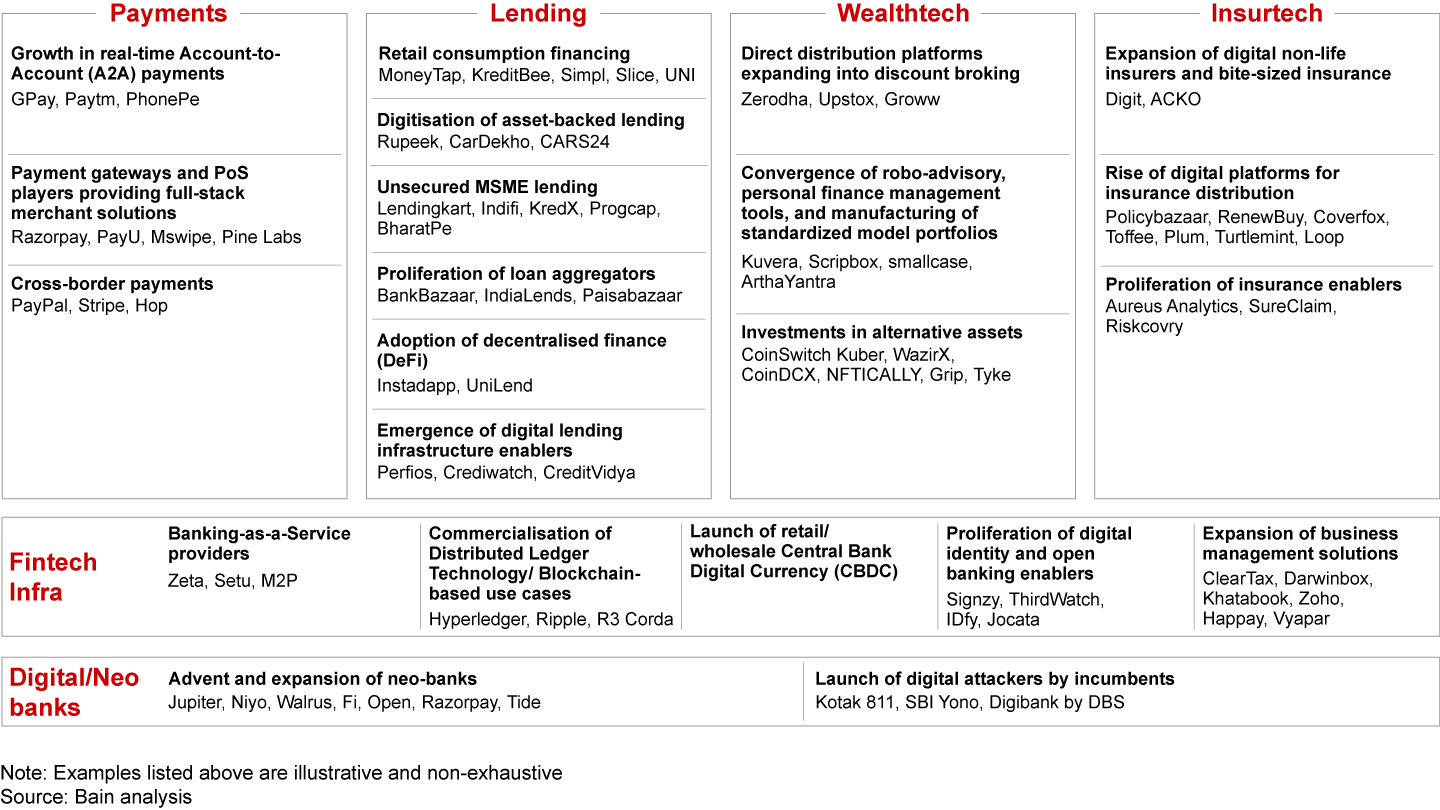
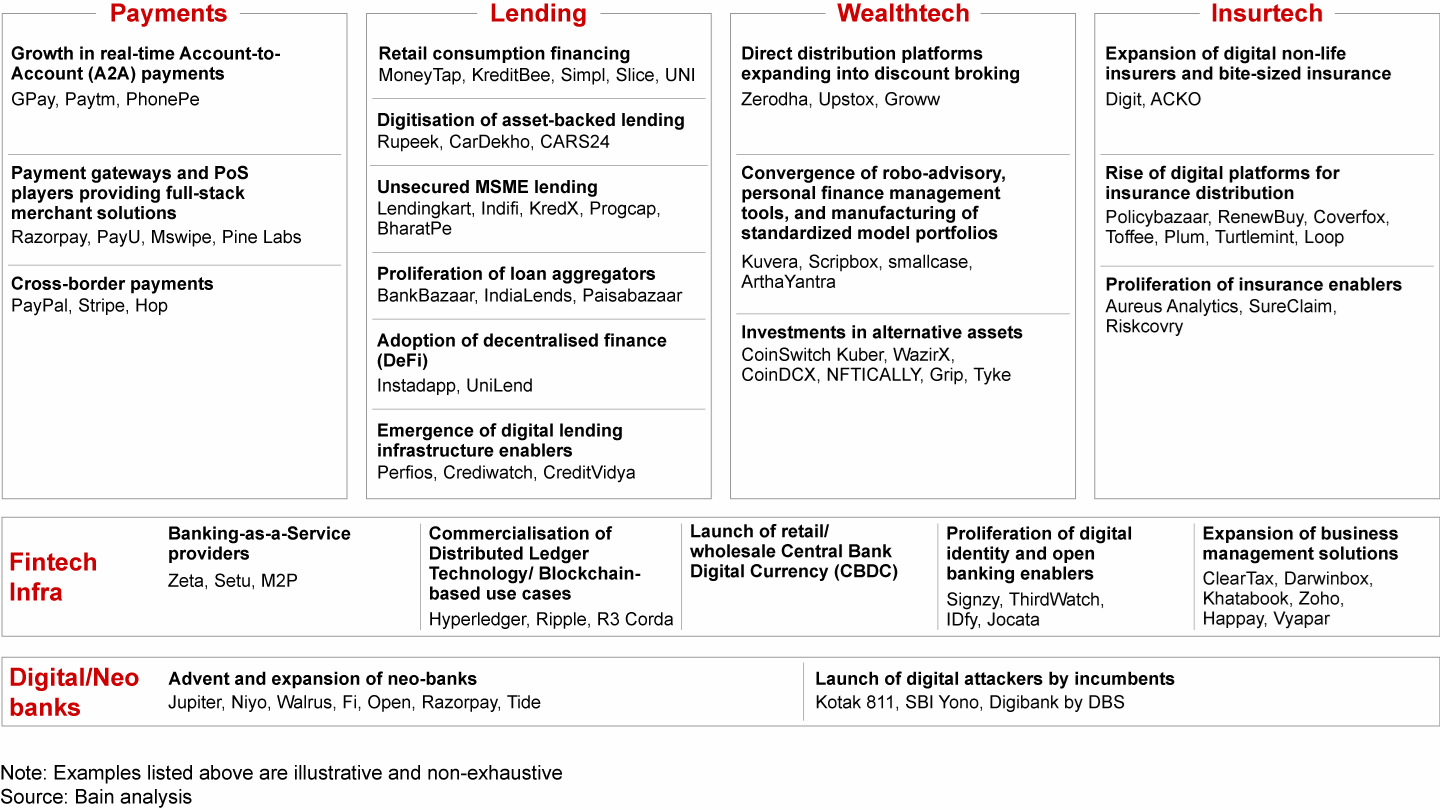
Voice of industry: Insights from C-suite executives (CXO) survey
- Industry leaders across incumbents, insurgents, and private equity/venture capital firms believe that favourable macro fundamentals, such as low financial services penetration and increasing digital adoption, along with strong consumer demand for better product propositions and customer journeys are driving fintech and digital adoption in India FS.
- Consumption financing, neobanking, and fintech infrastructure (for Banking as a Service) have emerged as the top three fintech themes that industry leaders are most bullish on for the short to medium term. Apart from the top three themes, incumbents also consider the emergence of full-service ecosystems as a vital theme, while insurgents believe that insurtech will be disruptive.
- 96% of leaders at incumbent banks, NBFCs, and insurers have clearly highlighted redesigning existing customer journeys as one of their top three strategic priorities.61% of incumbents also highlighted providing embedded finance by partnering with fintechs and about 57% of incumbents believe reimagining distribution models by shifting from physical to digital as the key areas of focus for the next five years.
- 68% of fintech leaders believe that customer engagement and retention is their biggest strategic priority. Nearly 60% believe that obtaining appropriate licences and core capabilities will be essential for driving long-term relevance and sustainable growth. Monetisation and profitability have also emerged as key strategic priorities for fintech leaders.
- About 75% of incumbents have highlighted collaboration with fintechs as the most critical enabler for maintaining leadership in digital FS. Acquiring and retaining the right talent (data scientists, product owners, developers, designers, enterprise architects, etc.) has emerged as a critical enabler for both incumbents (65%) and insurgents (79%).
- More than 65% of incumbents stated that they are partnering with insurgents to improve customer acquisition and enable superior customer experience, while most fintechs seek partnerships with incumbents for regulatory expertise, requisite licences and access to low-cost capital.
- 83% of incumbents believe that risk management will be the biggest challenge while partnering with insurgents, while 79% of insurgents believe that tech agility and digital ways of working between insurgents and incumbents will be a key challenge while collaborating. While both parties are looking for increased collaboration, misalignment in expectations is evident in a few key areas, specifically organisational culture/ways of working, risk management practices, commercial models, and tech agility.
- 88% of the surveyed investors view the Indian fintech sector as an attractive opportunity due to the existence of a large, addressable market. Investors also cite fintechs’ ability to deploy a differentiated value proposition at scale as the second-biggest critical factor driving investments.
- Looking ahead, about 80% of respondents expect increased collaboration between incumbents and insurgents across use cases. Most respondents are also predicting consolidation through M&A amongst fintechs, and between incumbents and fintechs, along with the emergence of clear winners and “also-rans” within each sub-sector/fintech theme, based on clear differentiation in value proposition.
Strong macro fundamentals and increasing consumer expectations are making C-suite executives bullish on emerging fintech themes, such as consumption financing, fintech infra, and neobanking
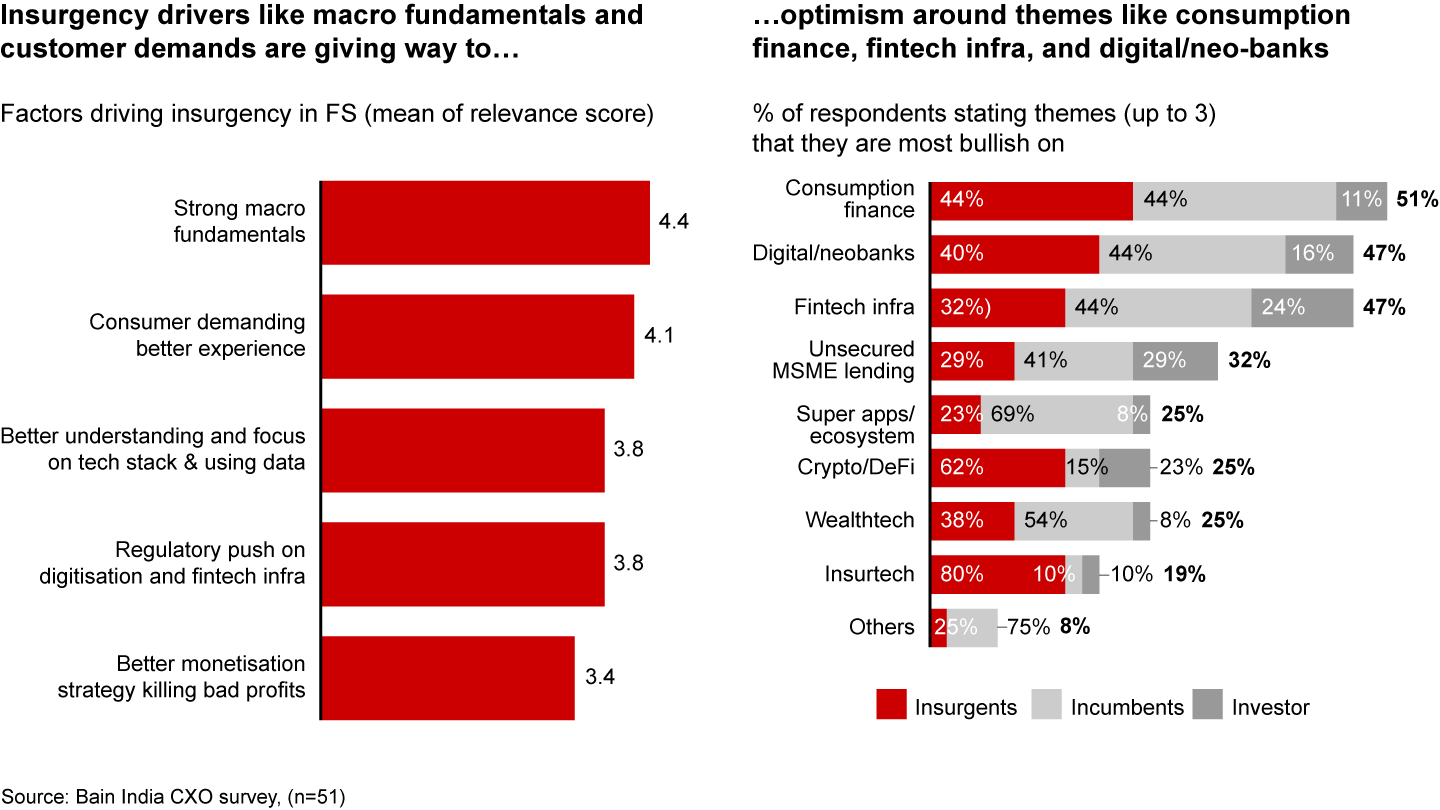
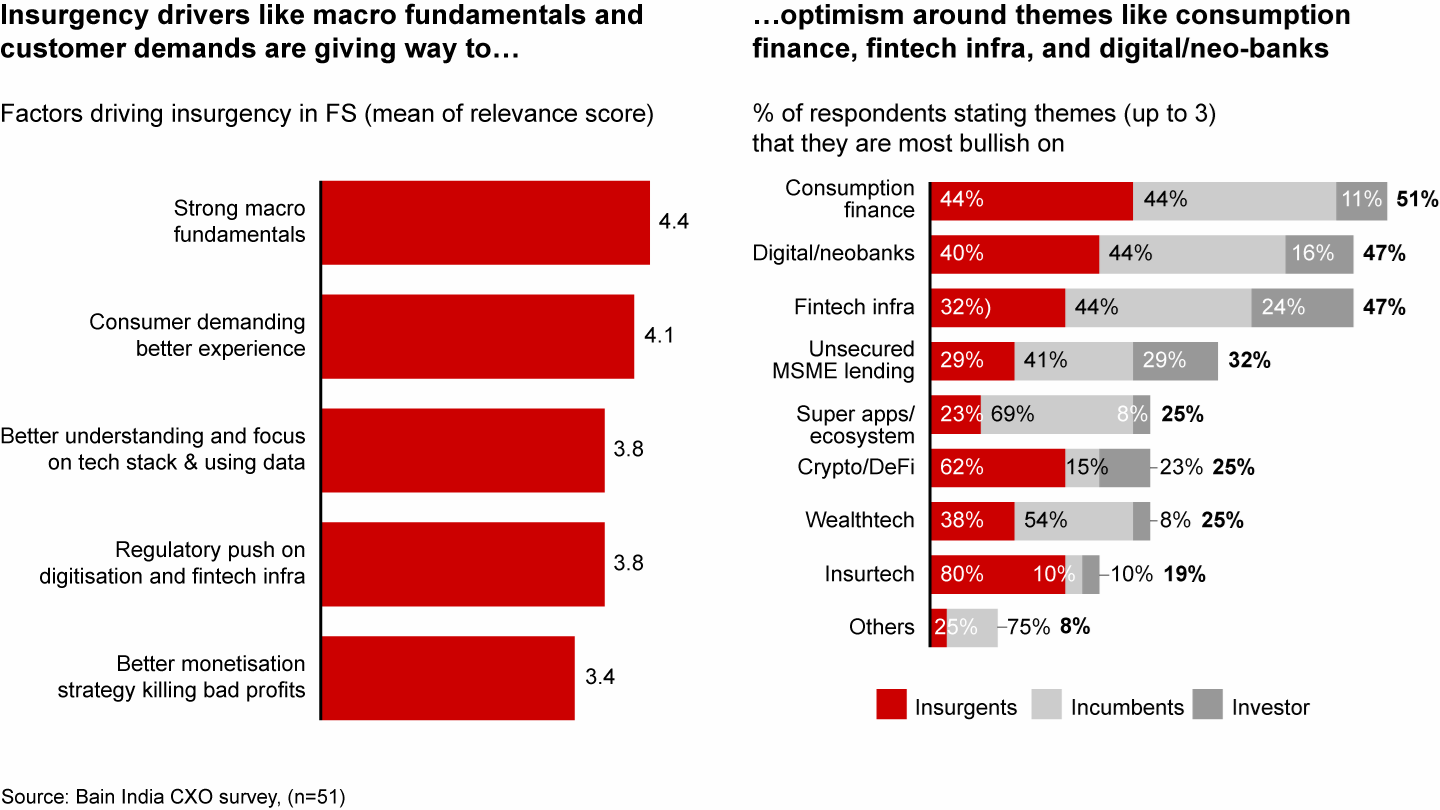
Redesigning the customer journey remains a top priority for incumbents, while insurgents are focused on improving customer engagement and retention
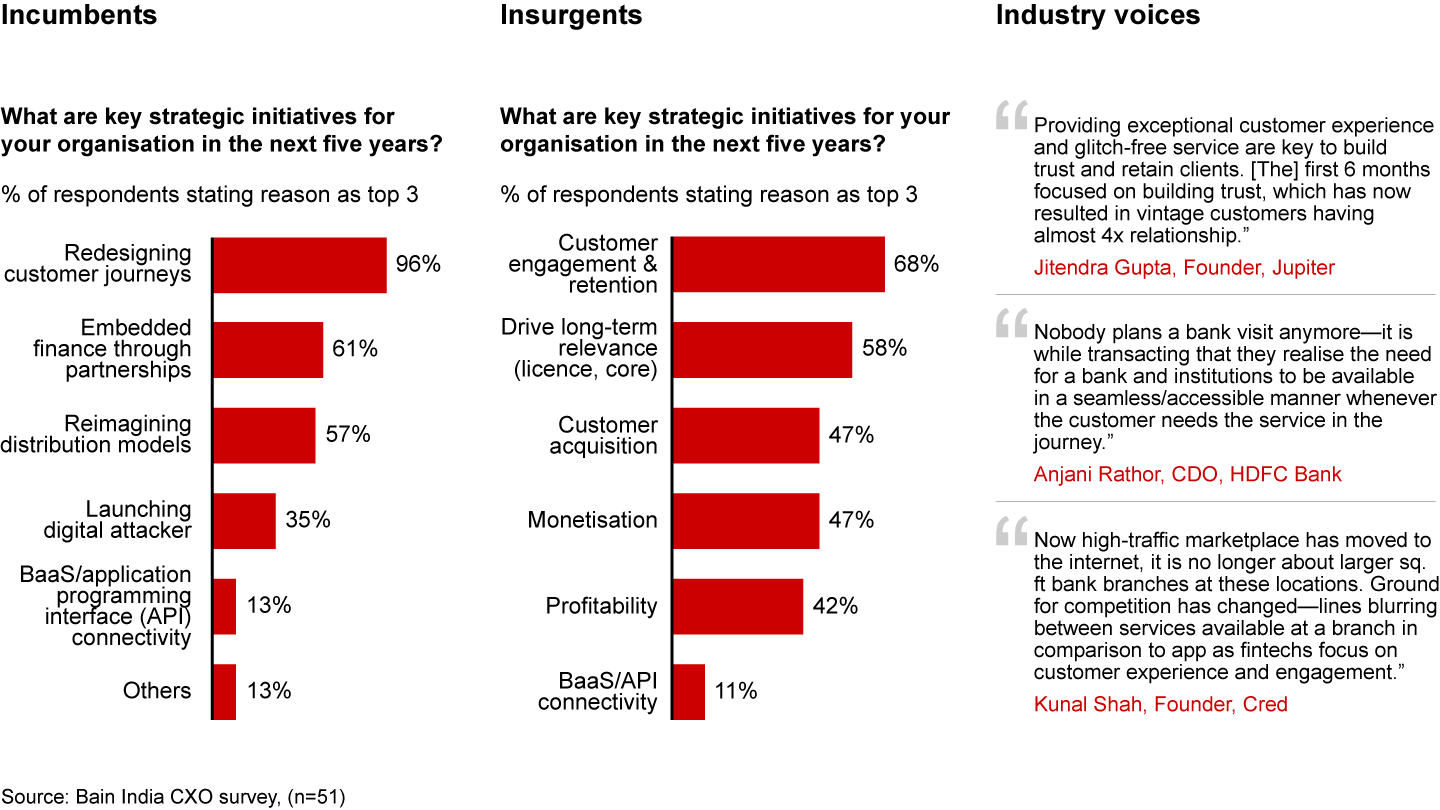
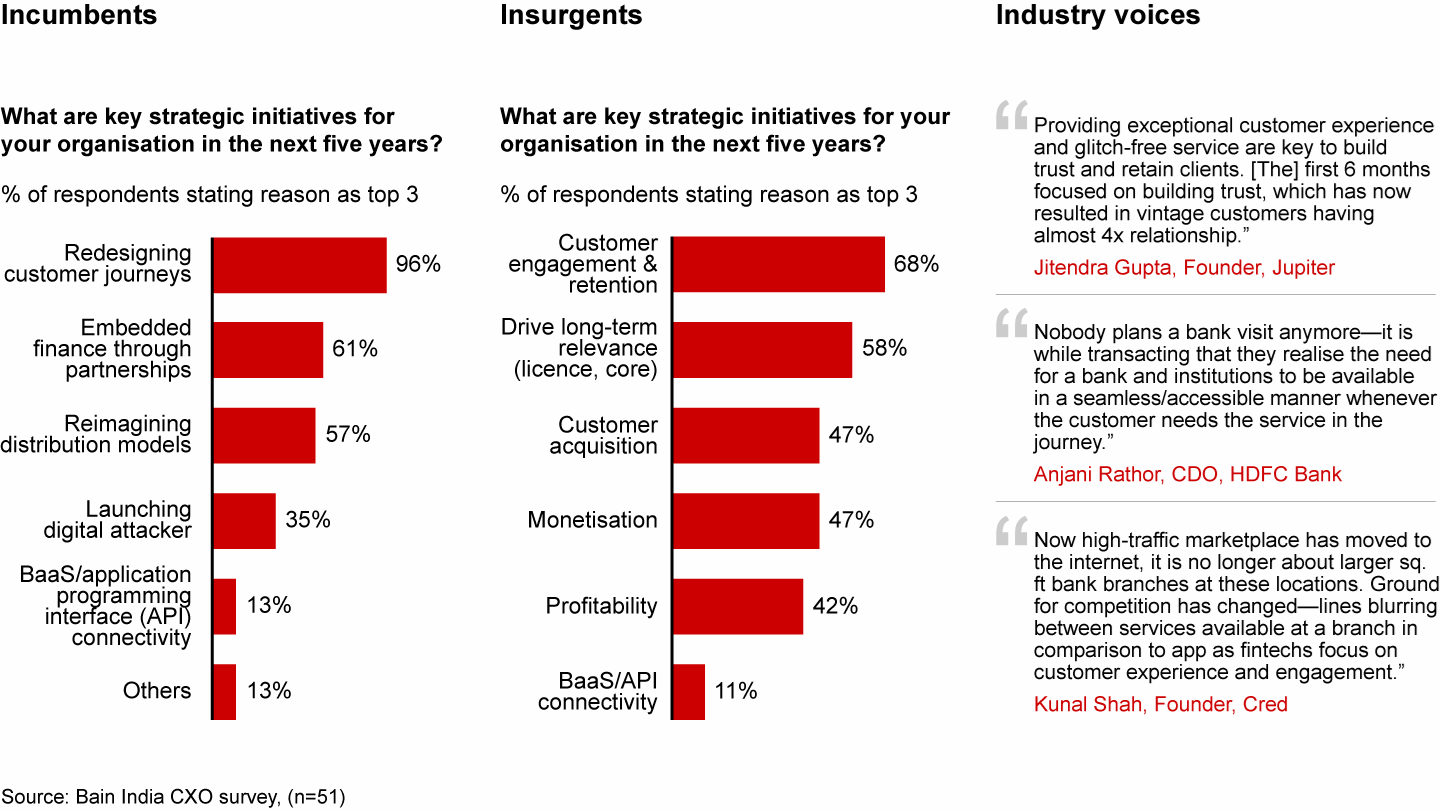
Industry leaders believe that a digital-first operating model, with adequate investment in talent and technology, will be a critical enabler for maintaining or achieving leadership
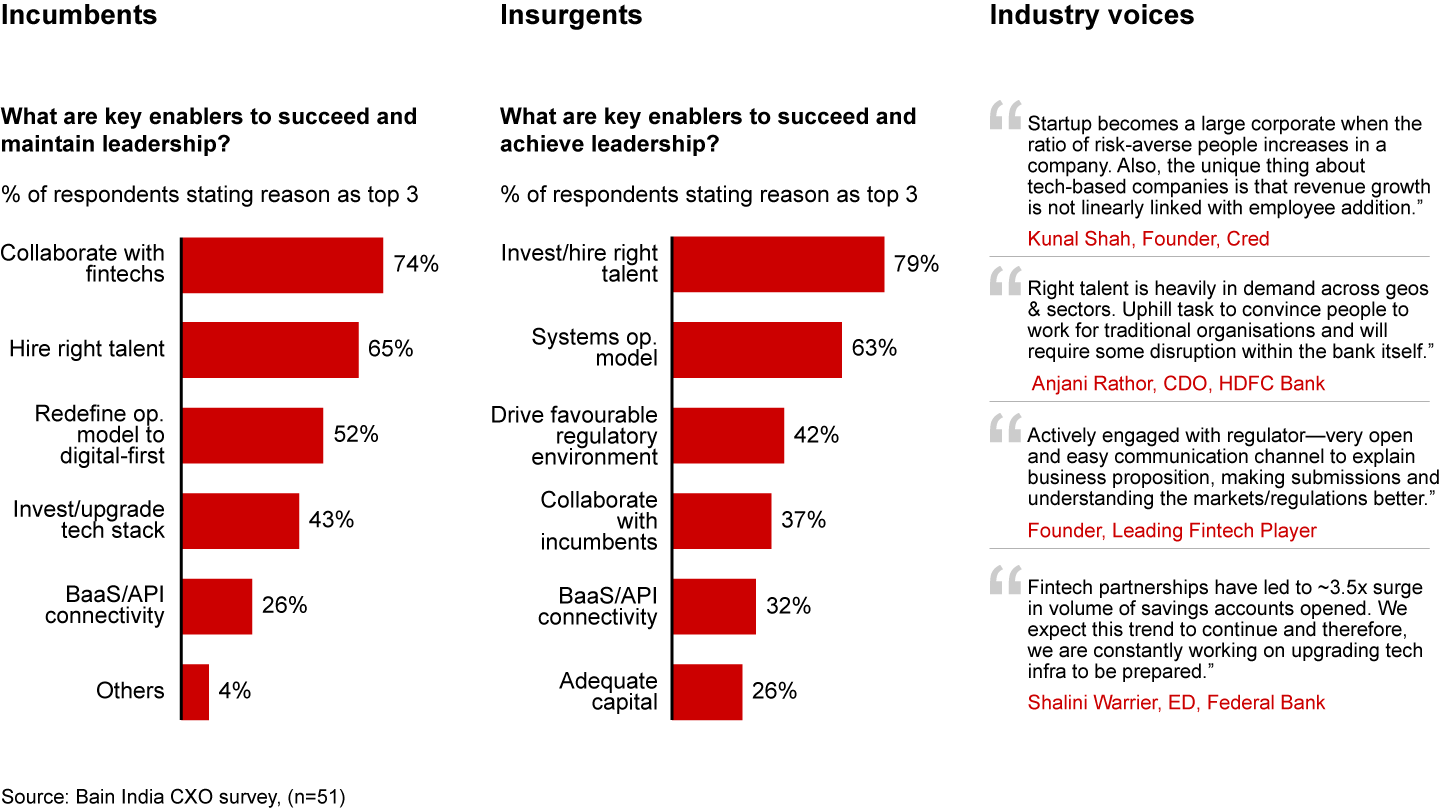
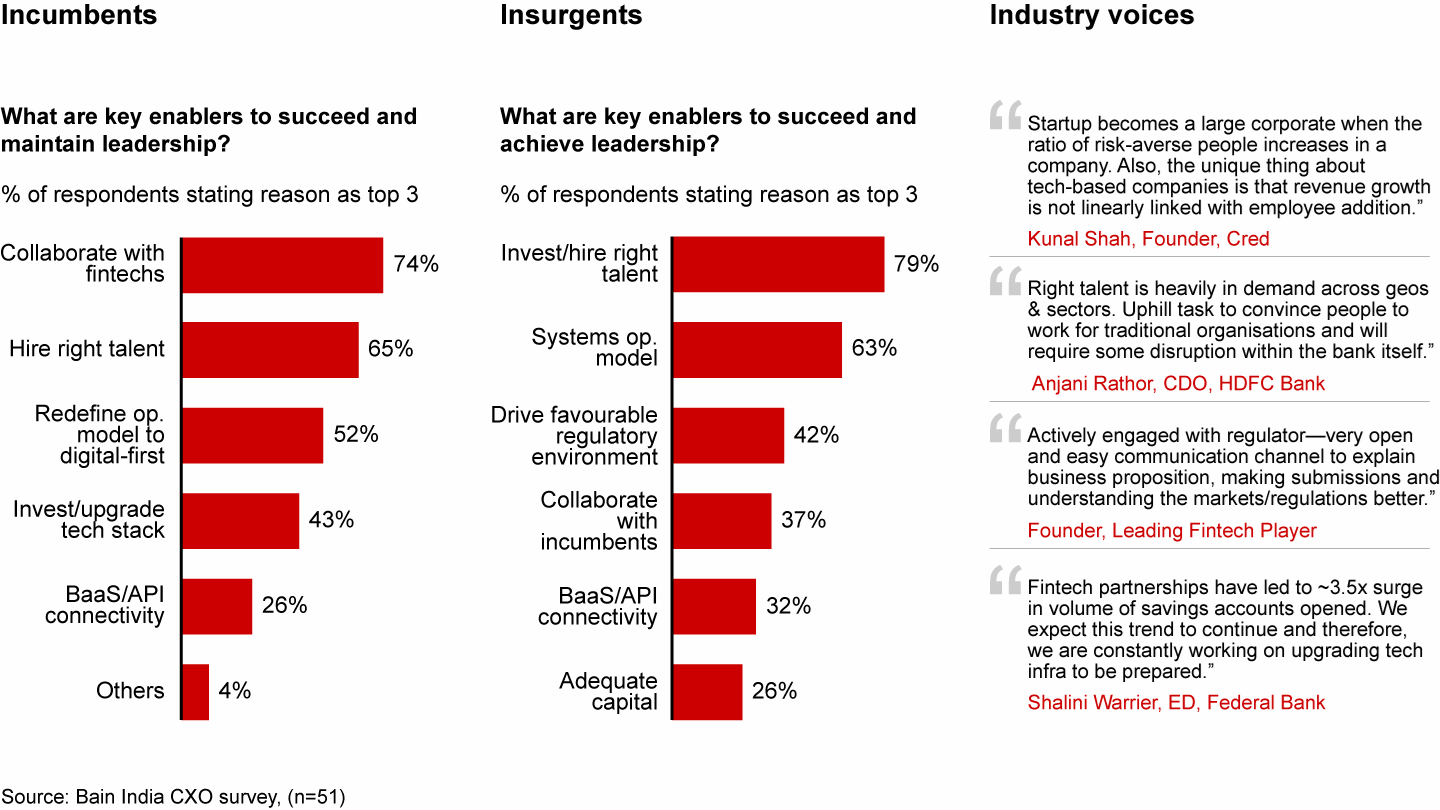
Incumbents prefer to partner with insurgents for superior customer experience while insurgents prefer to partner with incumbents for their regulatory expertise
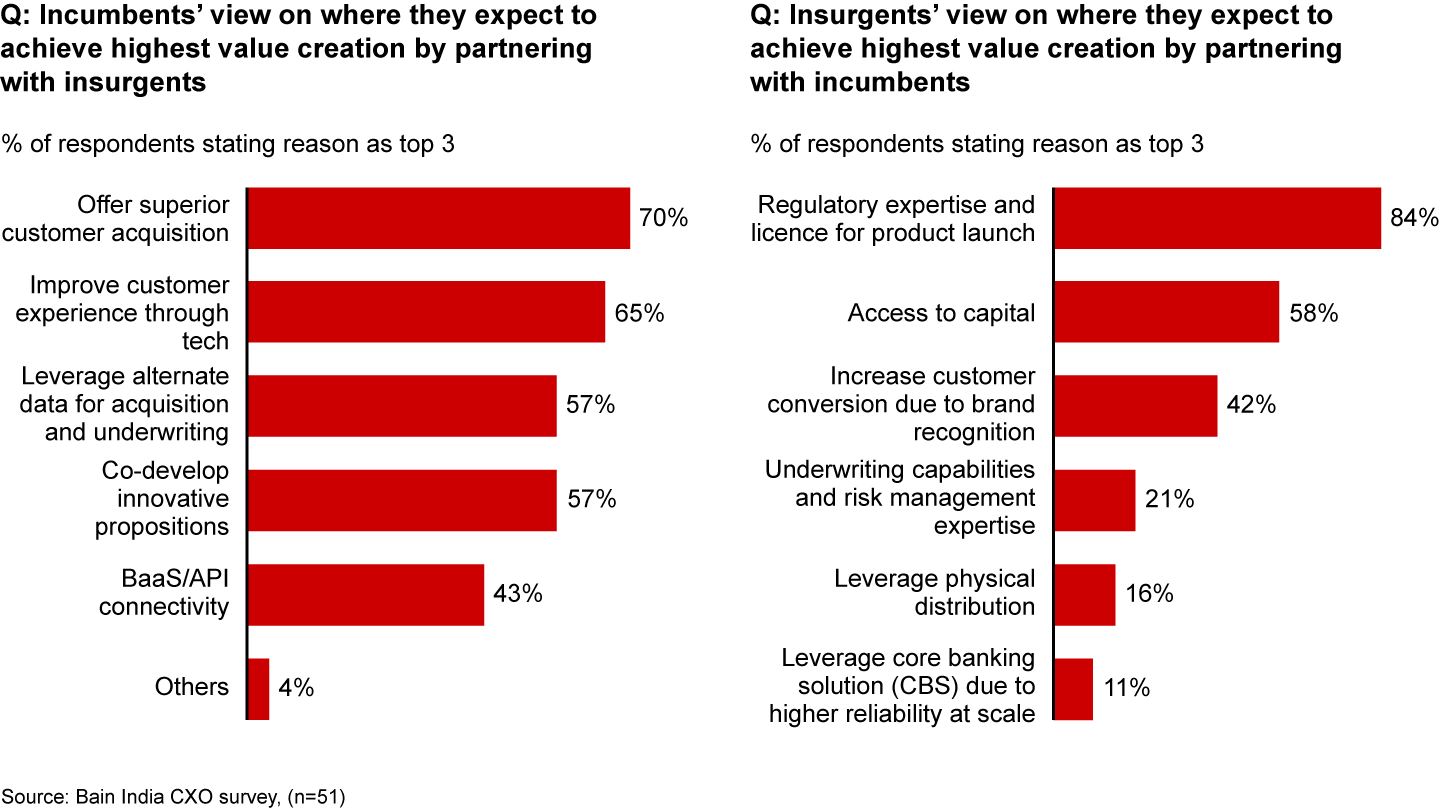
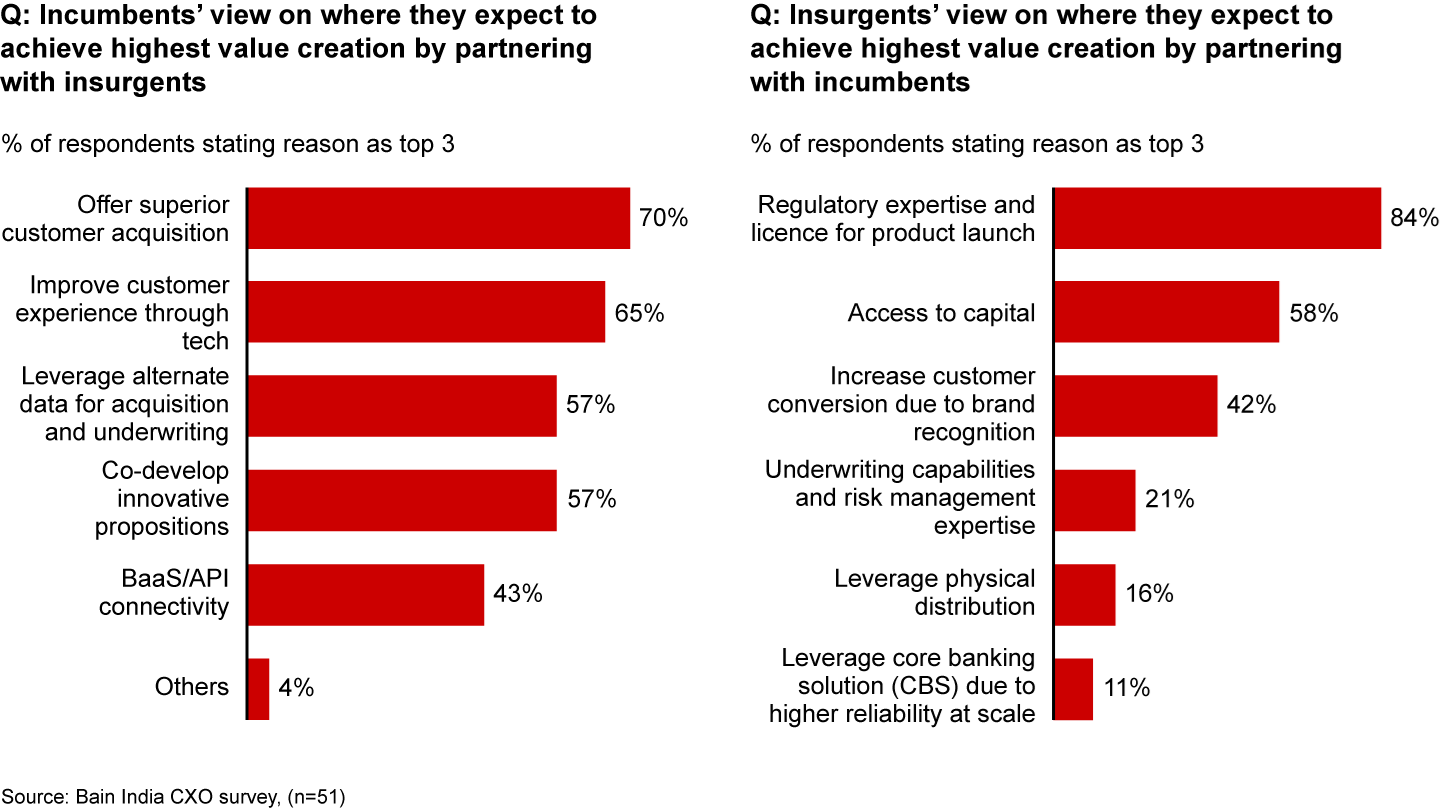
Incumbents believe risk management will be a top challenge for such partnerships, while digital ways of working and agility are top concerns for insurgents
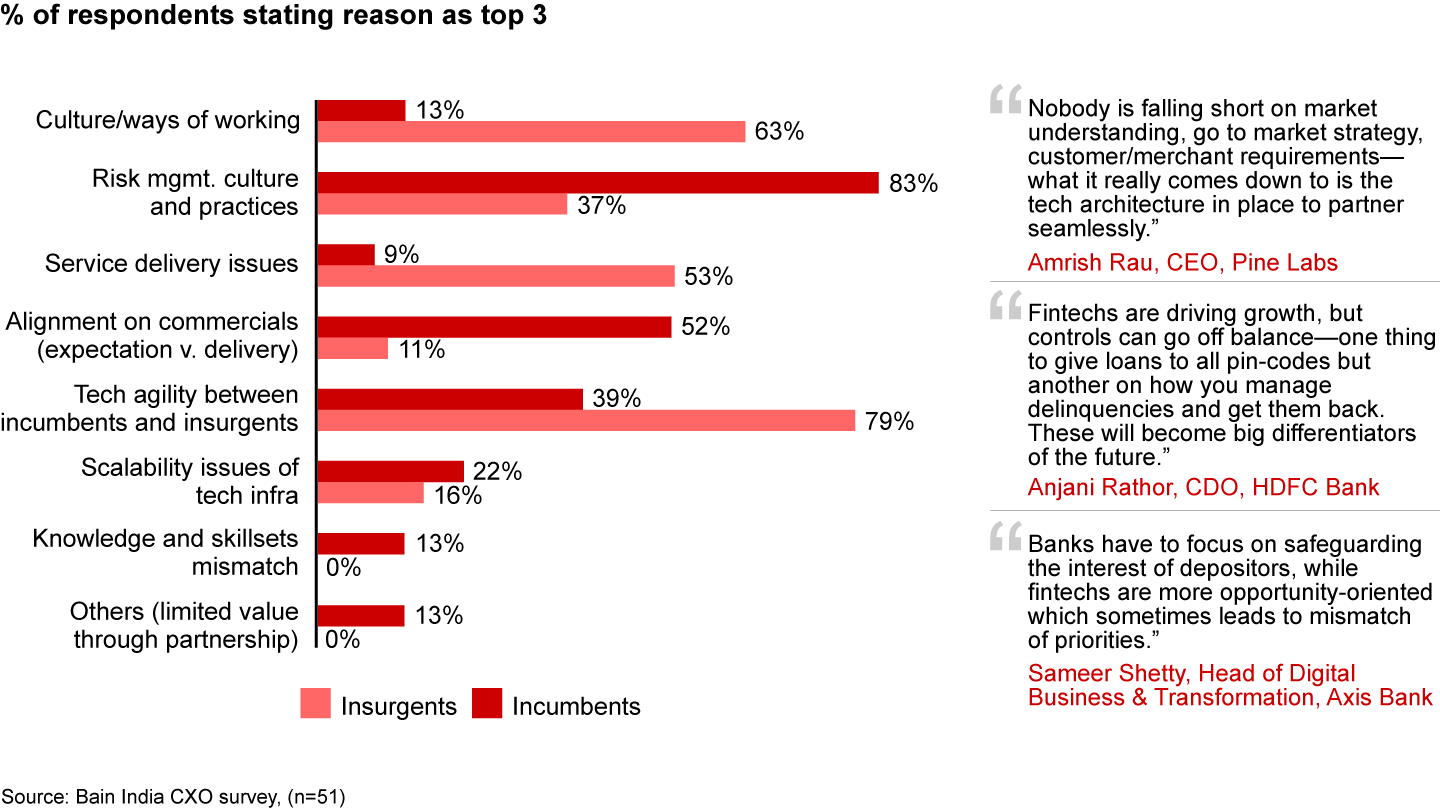
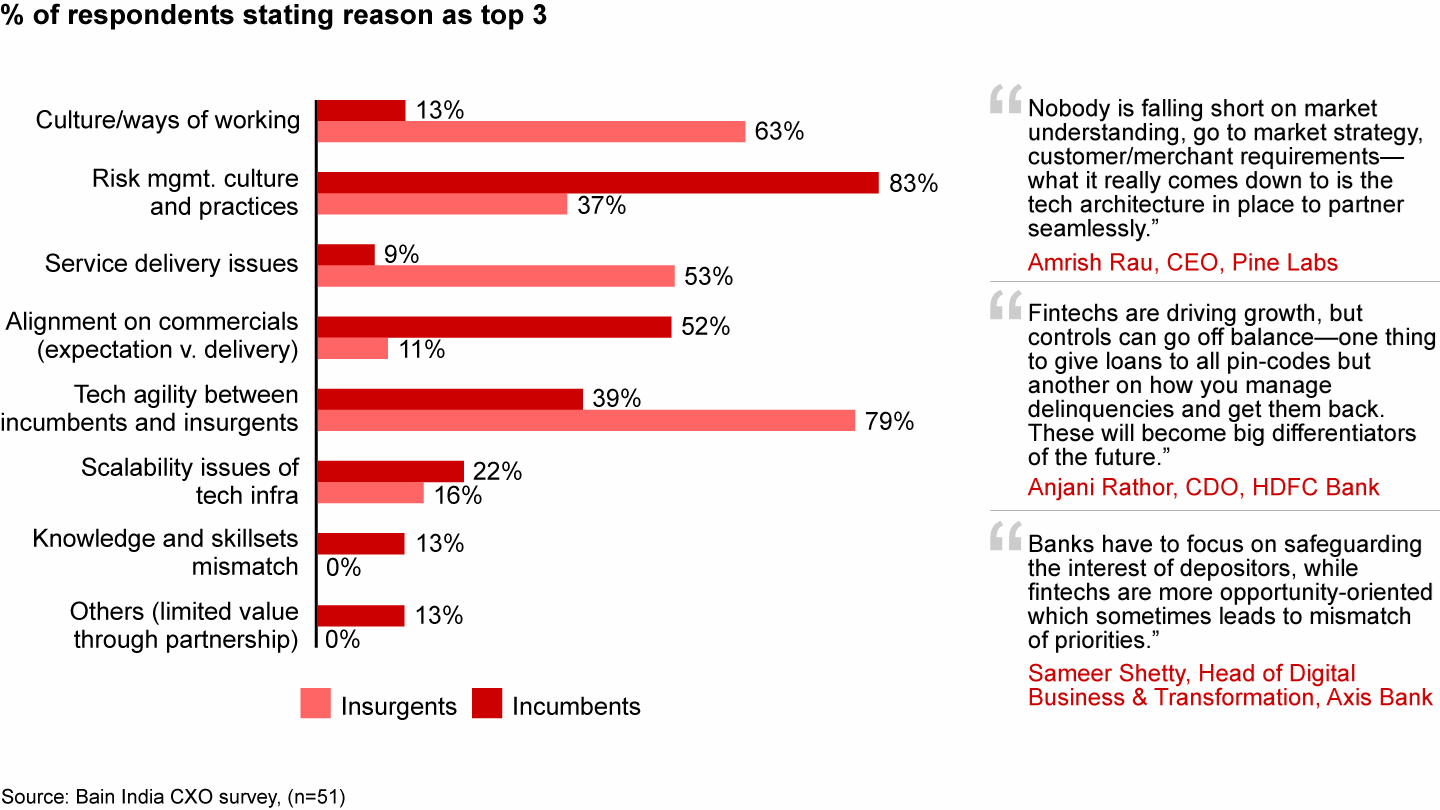
Investors see the Indian fintech market as an attractive space for investment due to a large, addressable market and conducive investment environment
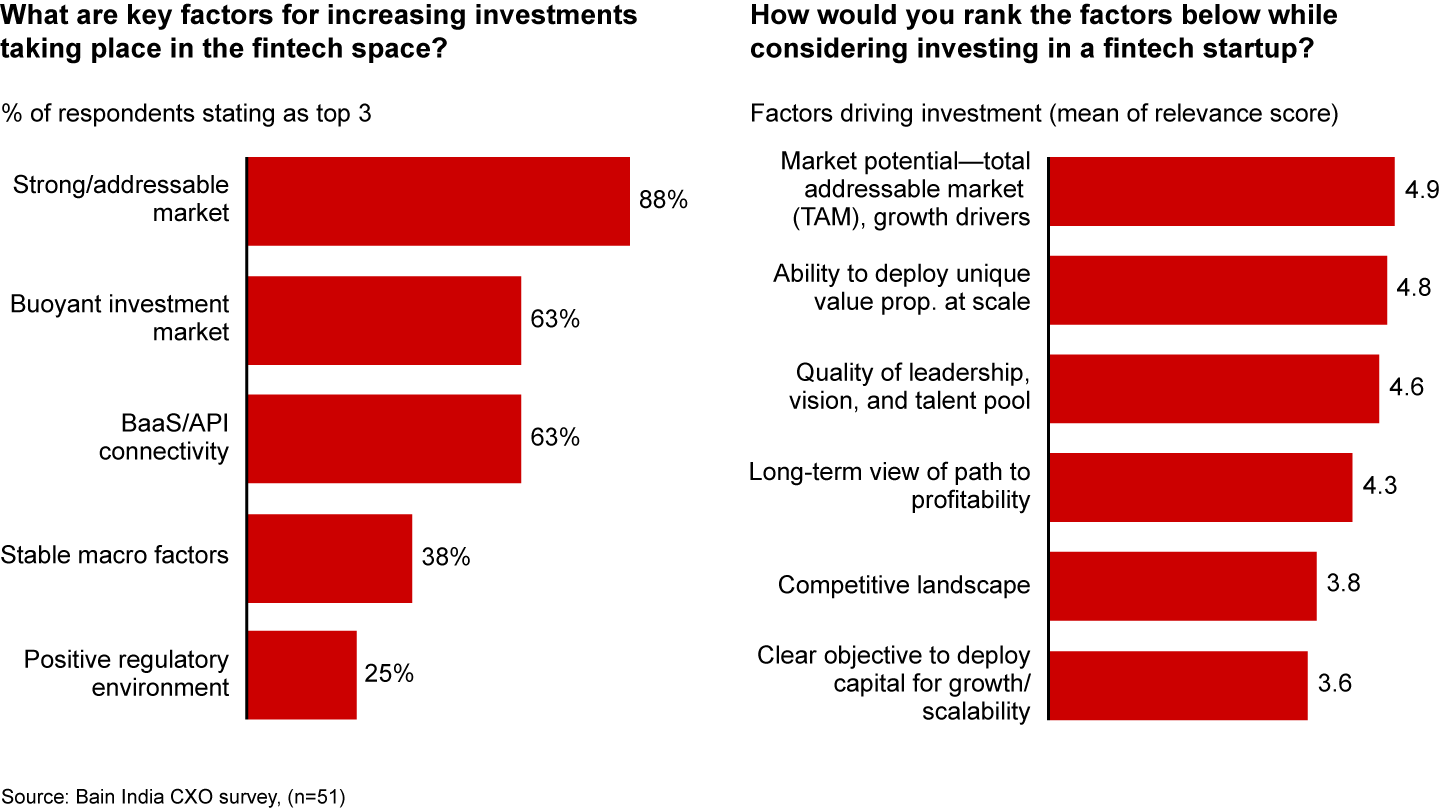

Future play—CXOs believe collaboration is the way forward, with coexistence as the larger theme to play out
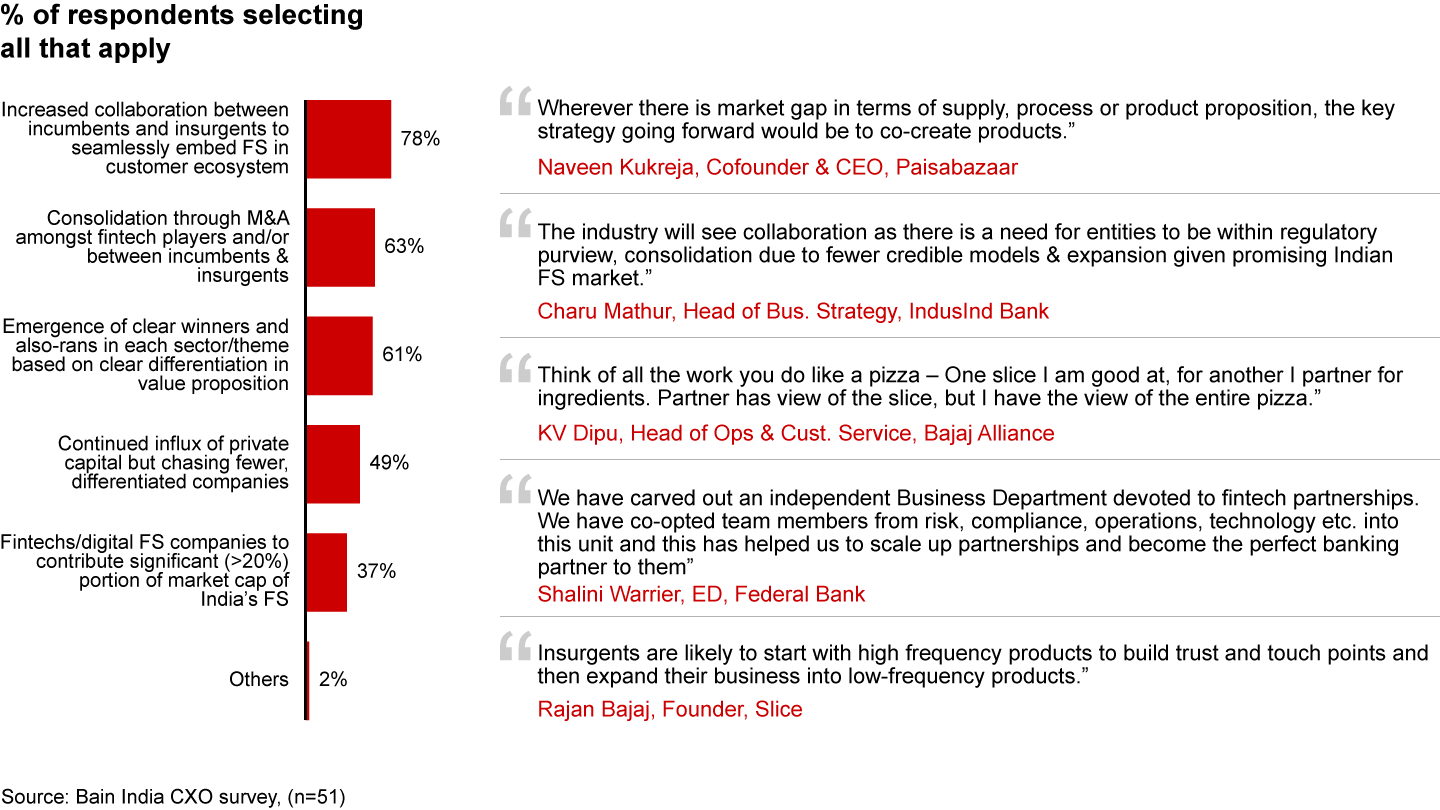
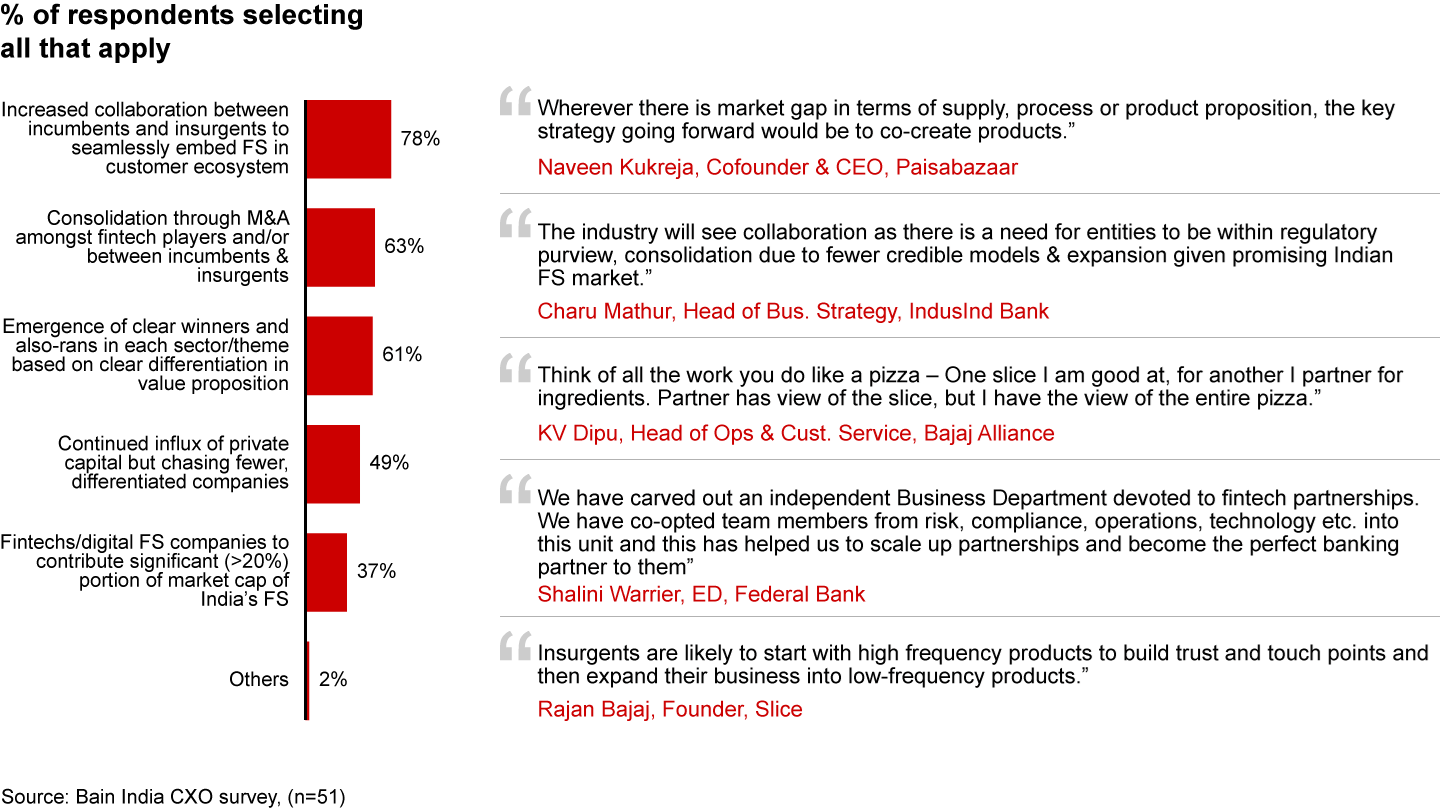
Unsecured retail lending and rise of consumption finance
- Despite the Covid-19 pandemic, unsecured retail financing has steadily grown at about 25% over the past three years (FY19–FY22):
- Credit cards (CCs) showed resilience with a 19% CAGR
- Personal loans (PLs) grew at an impressive 29% CAGR
- Consumer durable (CD) loans recovered to pre-pandemic levels and grew at 13% CAGR
- Semi-urban markets have been the primary source of growth for unsecured retail lending products, with about 32% CAGR in Tier 4 regions v. approximately 18% CAGR in Tier 1 regions over the past three years.
- Average ticket sizes for various lending products, especially PLs and CDs, are declining due to an increased focus on small-ticket-size lending led by fintech and NBFC lenders. The average ticket size of NBFCs in the PL category decreased by 70% over the past two years.
- CCs have shown impressive growth of 12% CAGR over the past three years in the small-ticket-size segment (less than $650), with no real impact on asset quality and expansion primarily driven by semi-urban regions.
- PLs have shown robust growth of 120% CAGR in the small-ticket-size (<$650) segment, with 85% of disbursements in small ticket size (<$650) to consumers less than 35 years old.A similar theme is visible in PLs as witnessed in CCs, where the primary driver of growth have been the semi-urban regions.
- Small-ticket CD loans have also recovered to pre-pandemic levels, with an 11% CAGR over the past three years. Over 70% of disbursements have been to the <40 years age group with 36% to the 30–40 years age group and 37% to the <30 years age group, highlighting significant demand for consumption financing by millennials and members of Gen Z. New-to-Credit (NTC) customers have shown best credit behavior in CCs, but performance challenged in PLs and CD loans.
- The above factors highlight a clear trend in favour of bite-sized consumption financing solutions, especially driven by millennials and Gen Z. Growth in semi-urban regions and in the NTC segment also shows that lenders are beginning to successfully increase their reach through digital channels and leverage alternate data for underwriting.
- Short-term, small-ticket consumer loan products, which offer convenience and a better customer experience, grew rapidly as a preferred mode of consumption financing. Additionally, equated monthly instalment (EMI)-based CC propositions are gaining traction in the small-ticket-size segments. From a fintech perspective, we saw the emergence and scale-up of convenience Buy Now Pay Later (BNPL) such as Simpl and LazyPay, affordability BNPL (e.g., ZestMoney), and card-based lending products.
- However, recent regulations restricting Prepaid Payment Instruments (PPIs) from offering credit lines and the new digital lending guidelines will adversely impact the current business models of these players, especially card-based lending and BNPL players providing a revolving line of credit.
- While tightening of the regulatory environment will result in conservative growth of fintechs in the short-term consumption financing market, the fundamentals for consumption financing still remain strong. We expect the form factors to change to adhere to regulatory guidelines with greater collaboration between fintechs and banks expected on consumption financing (e.g., co-branded cards), expansion of low-limit credit cards with innovative and flexible repayment options, increasing traction for end use-specific financing facilitated at point of sale by POS providers and payment aggregators, etc. Additionally, regulatory oversight on consumption financing specifically led by fintechs as DLAs or loan service providers (LSPs) and on fintechs more generally is expected to increase going forward, with RBI expected to set up a fintech division.
India’s unsecured retail lending market has grown at an impressive 25% CAGR over the past three years, with increasing focus on the semi-urban regions of India
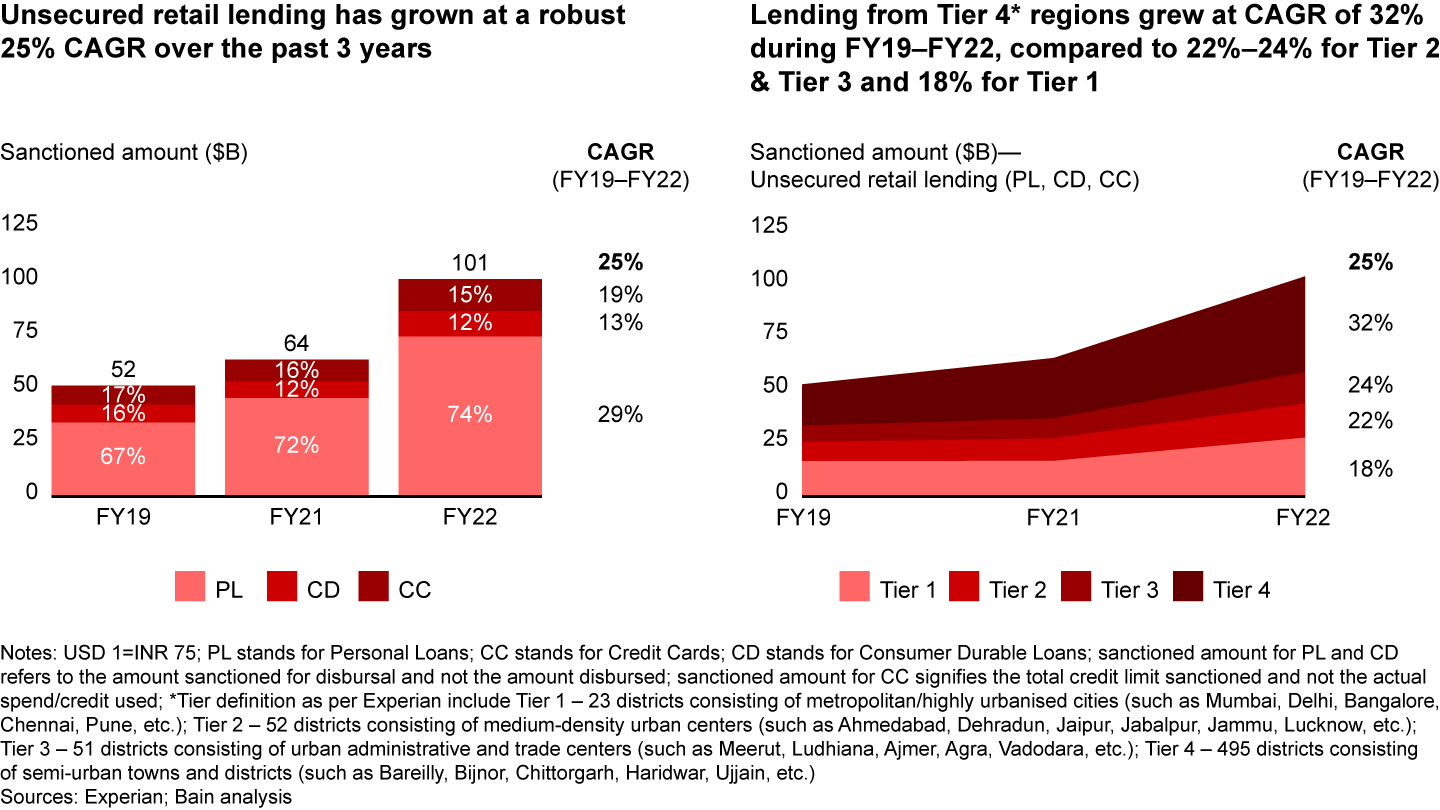
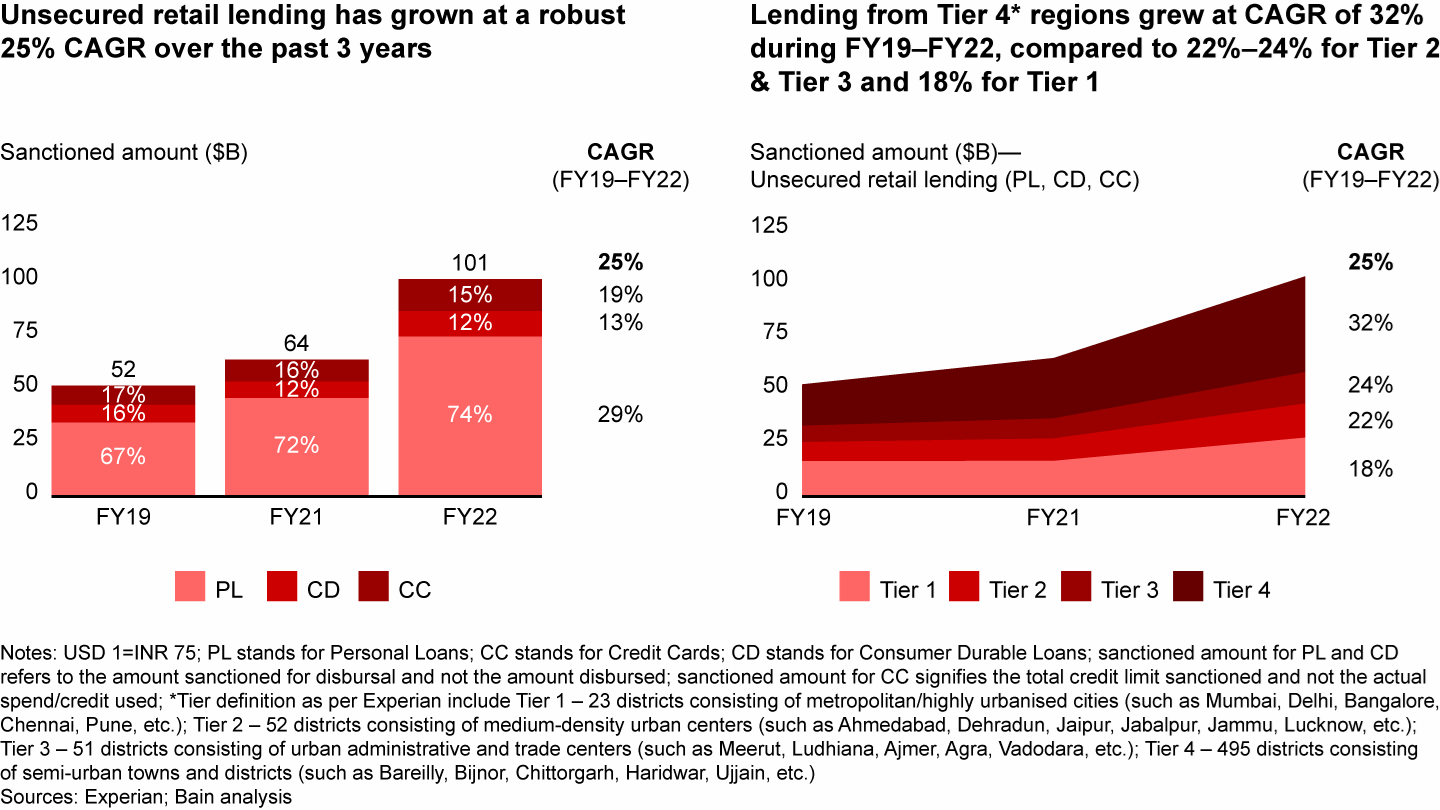
Over the past 3 years, private sector banks continued to lead the CC market, public sector banks expanded aggressively into PLs, and NBFCs continued to dominate CDs
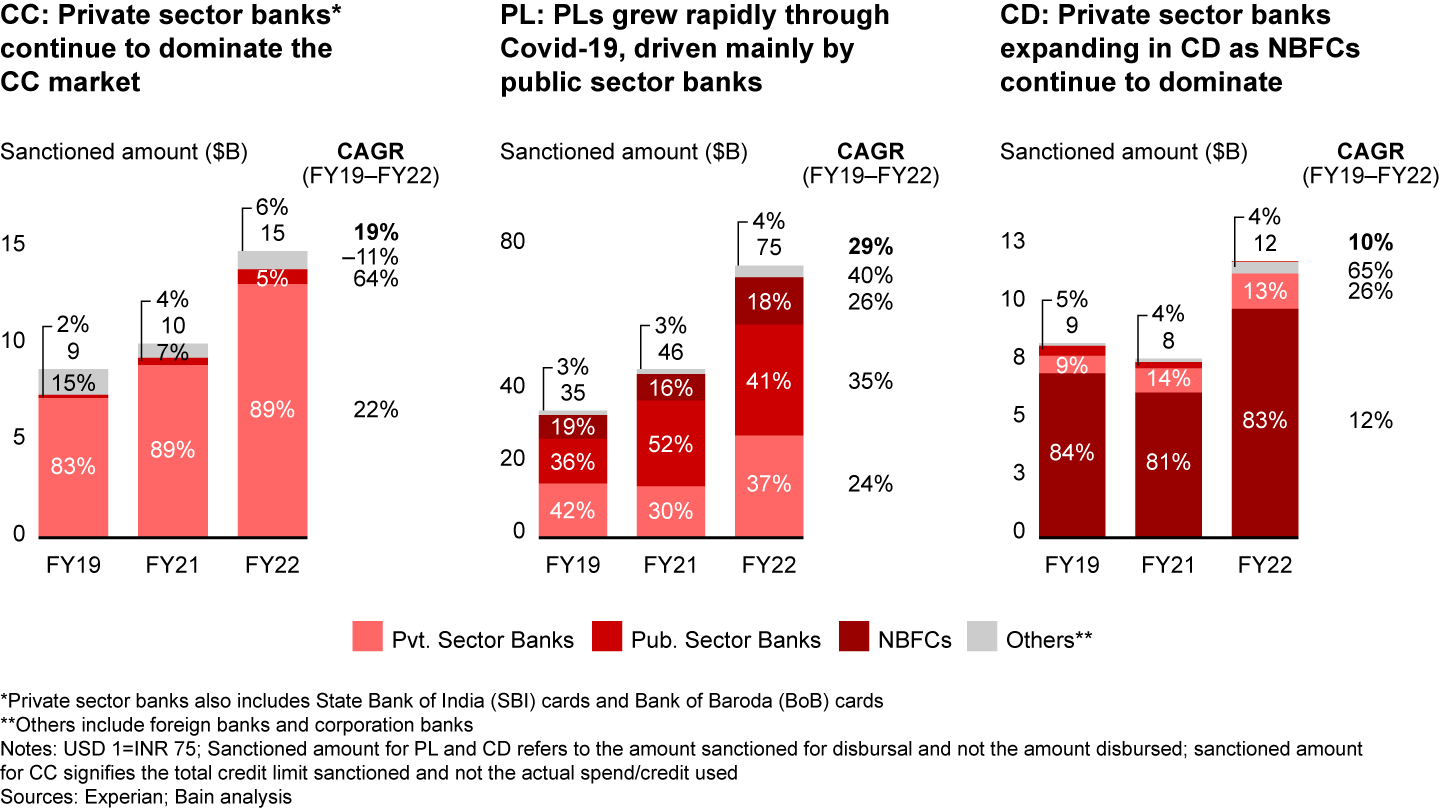
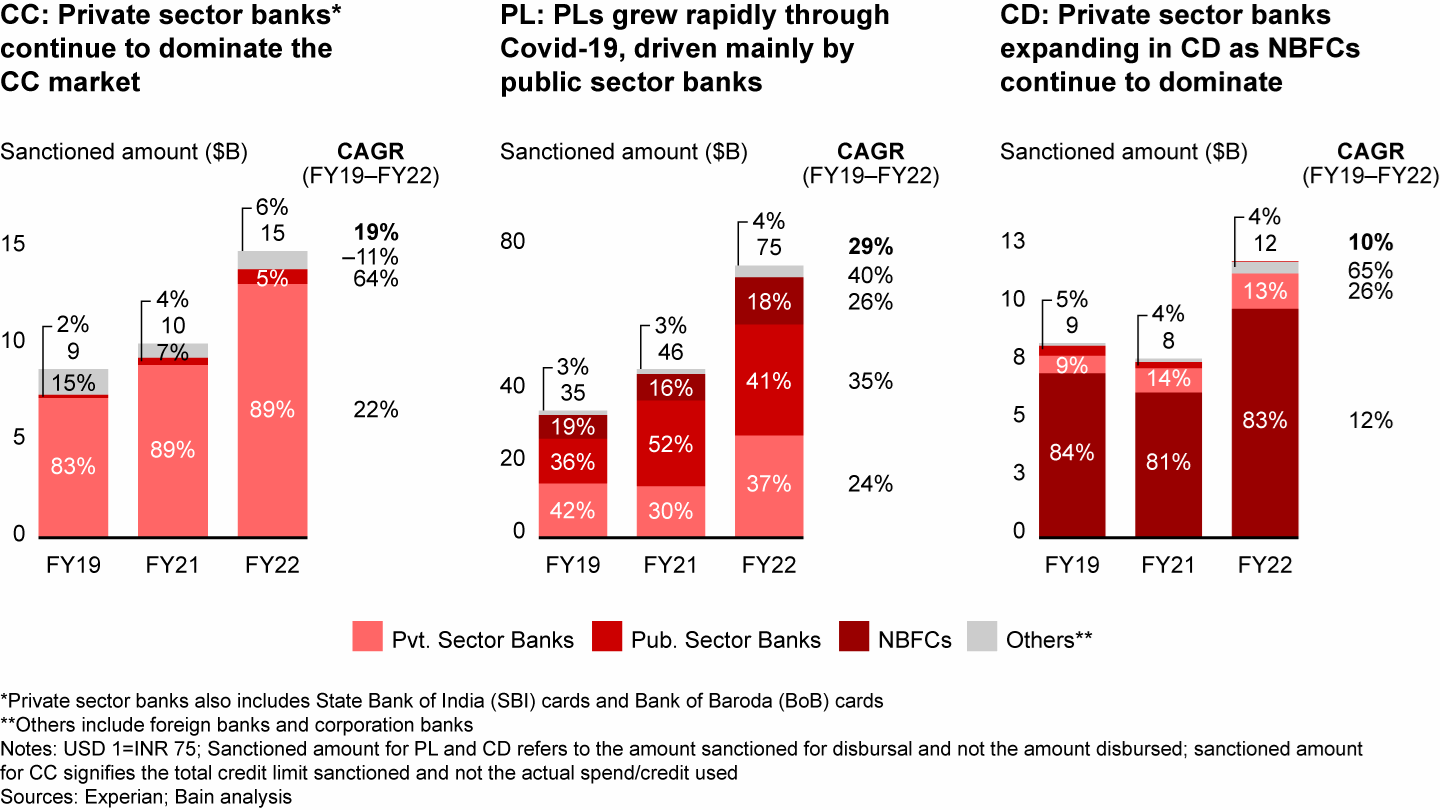
NBFCs continue to drive down the overall average ticket size for PLs and CD loans, indicating consumer preference towards bite-sized lending products that offer ease of use
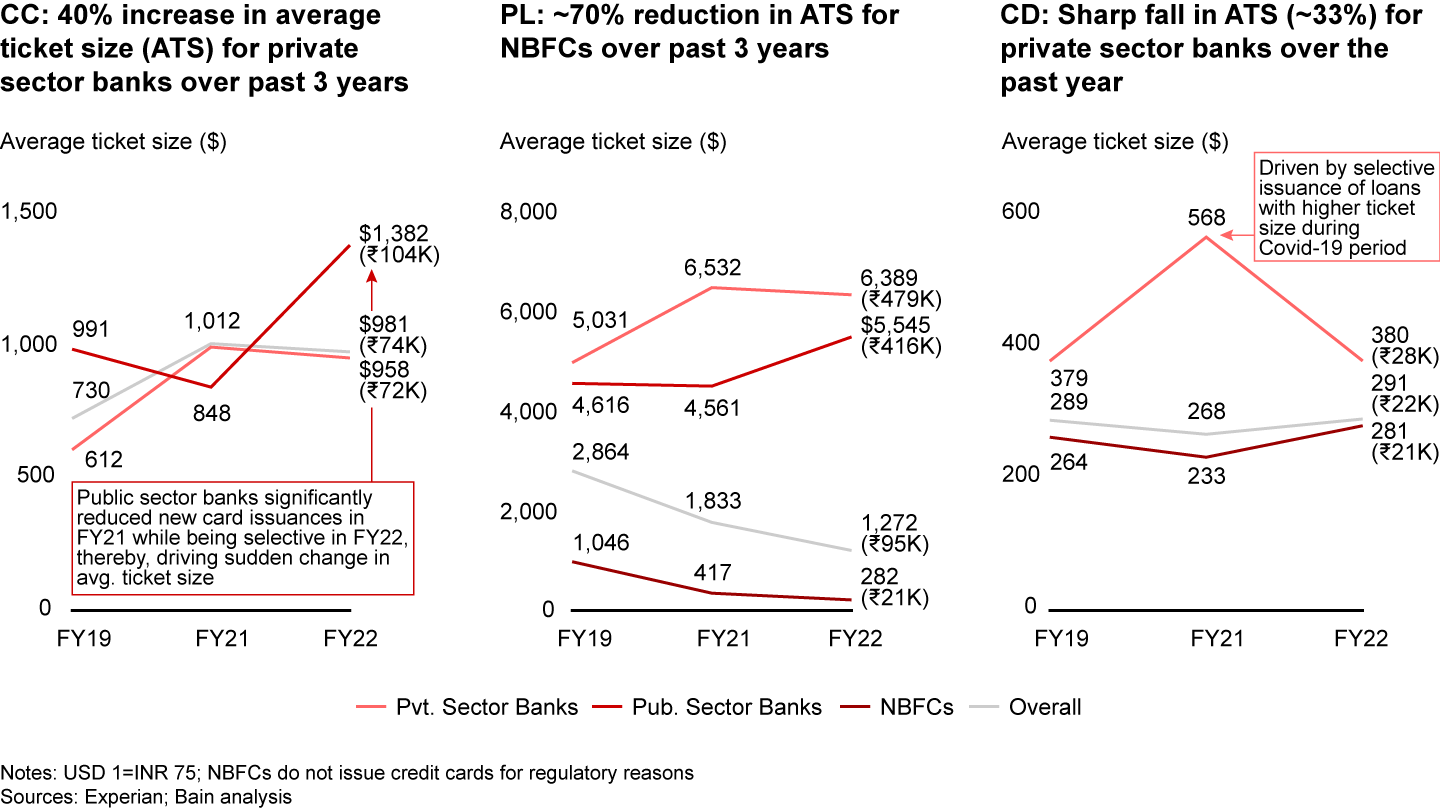
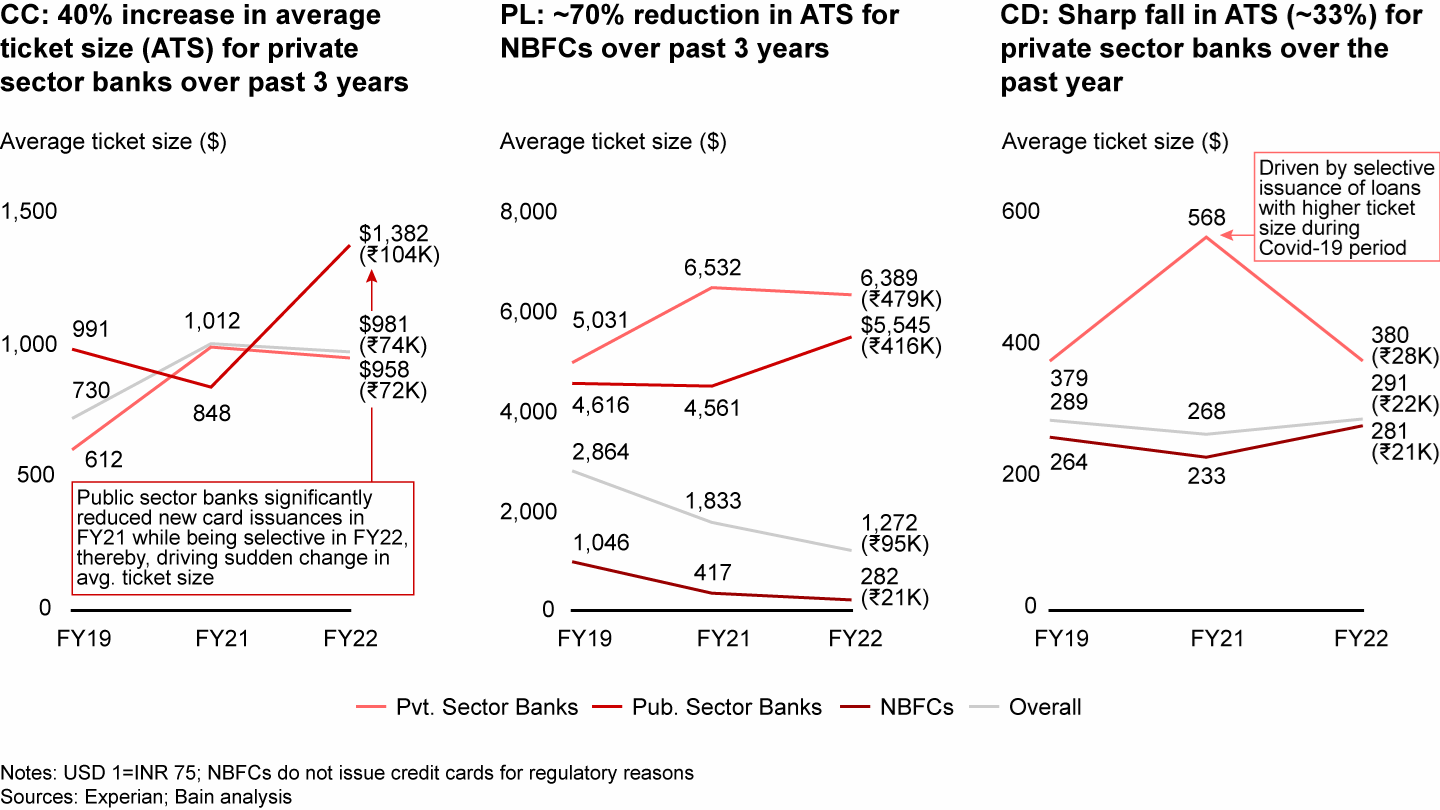
CC issuances in smaller ticket sizes (credit limit <$ 650 or ₹ 50K) grew at a 12% CAGR with no significant impact on asset quality, primarily through expansion of small-ticket loans in semi-urban regions
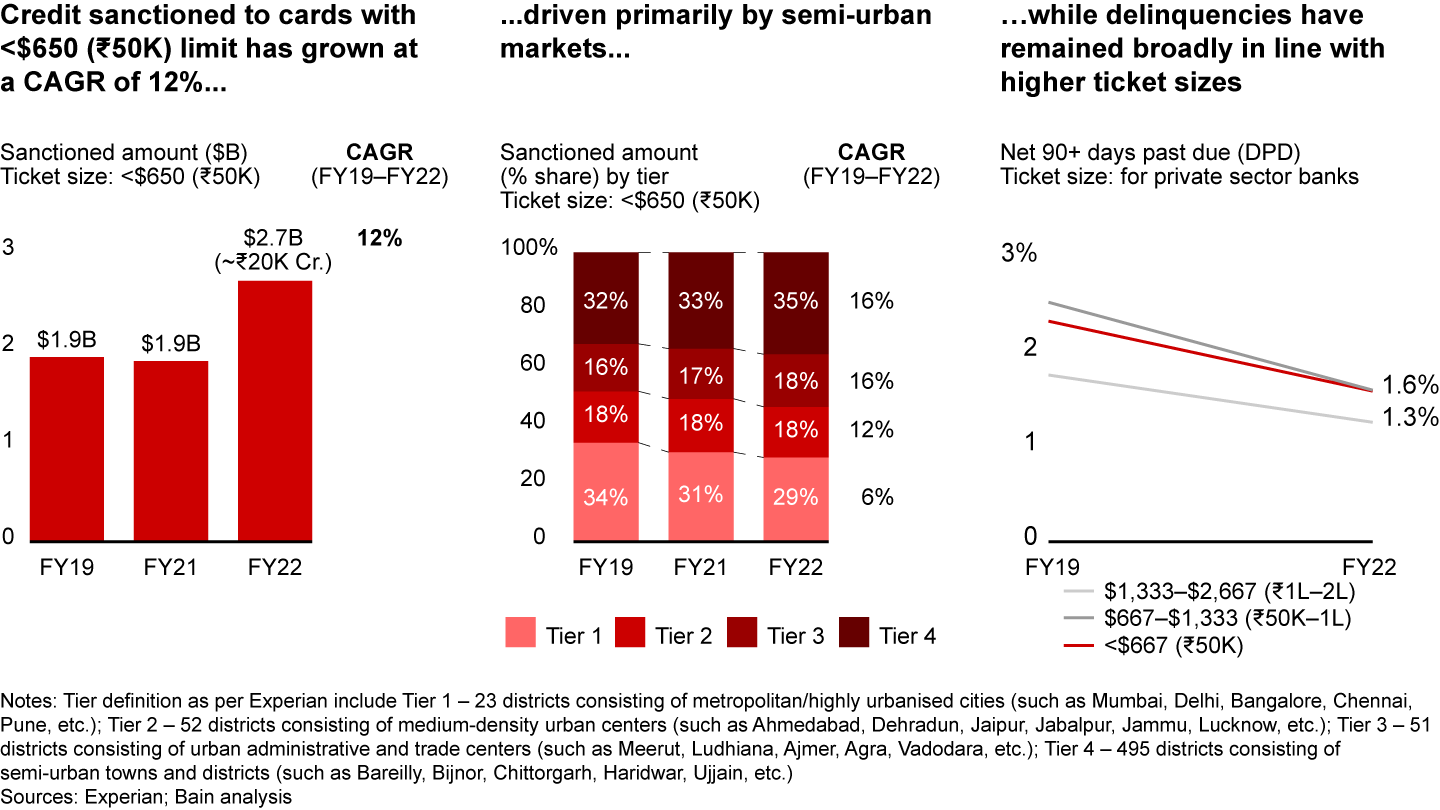
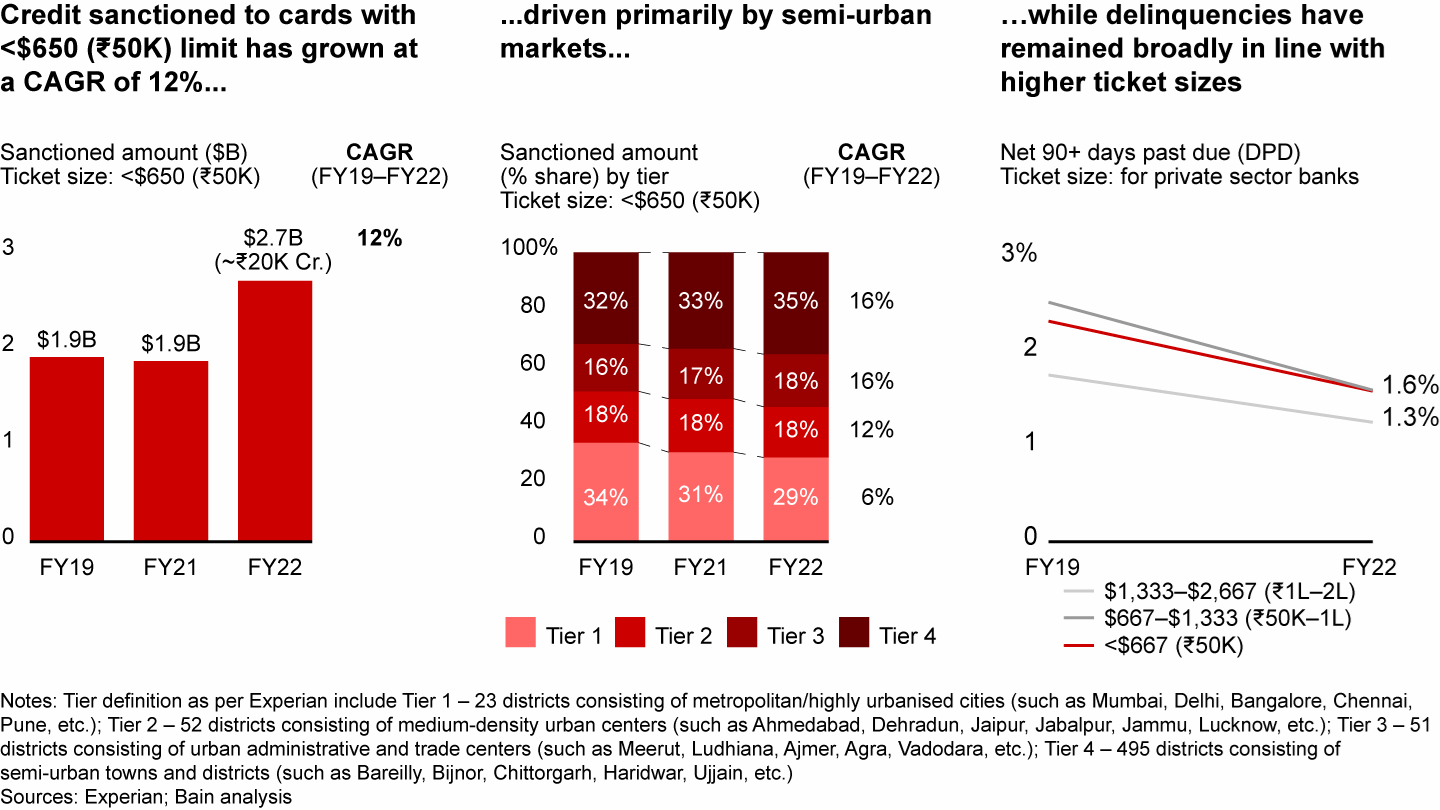
PLs within the small-ticket-size segment (credit limit <$650 or ₹50K) grew at 120% CAGR over the past three years, primarily driven by NBFCs
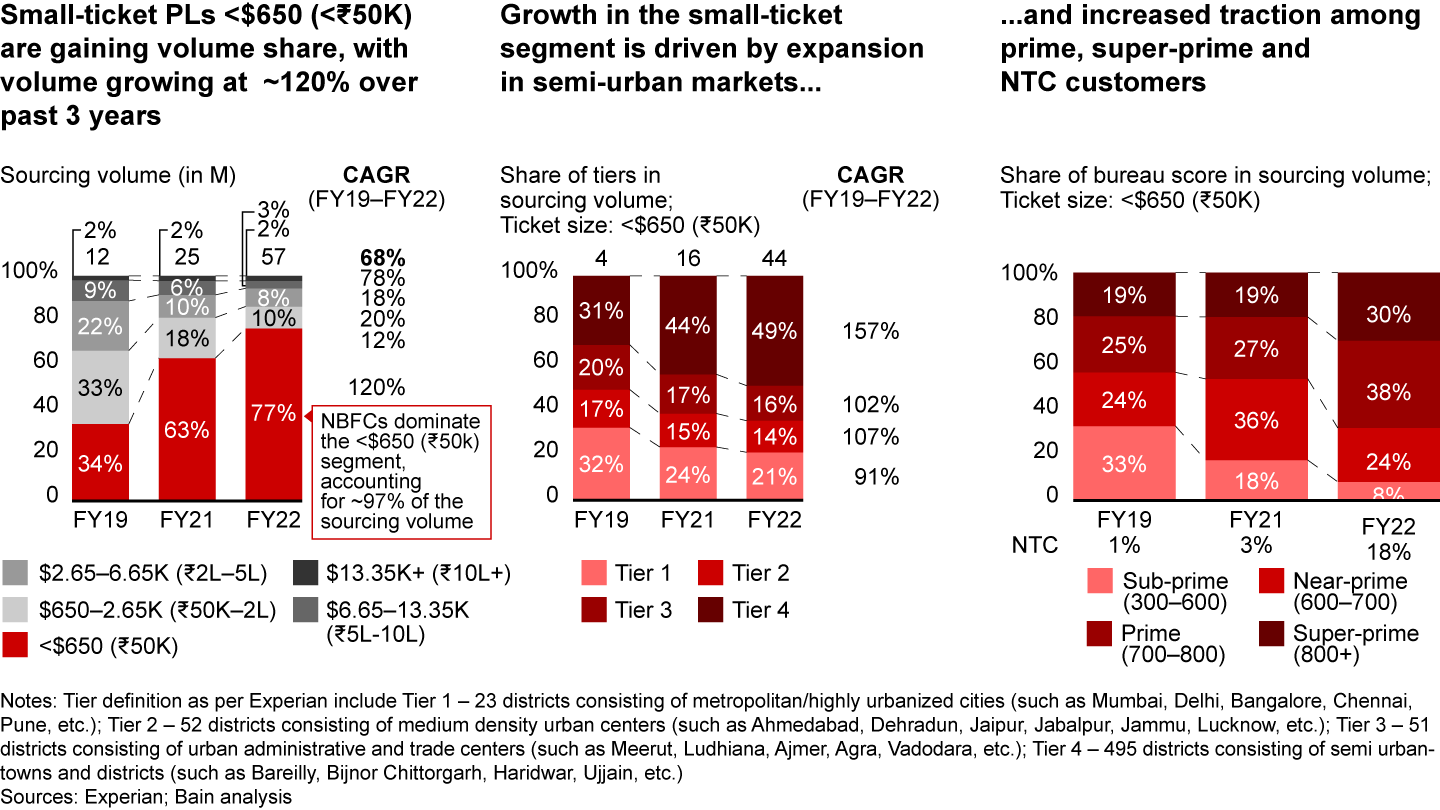
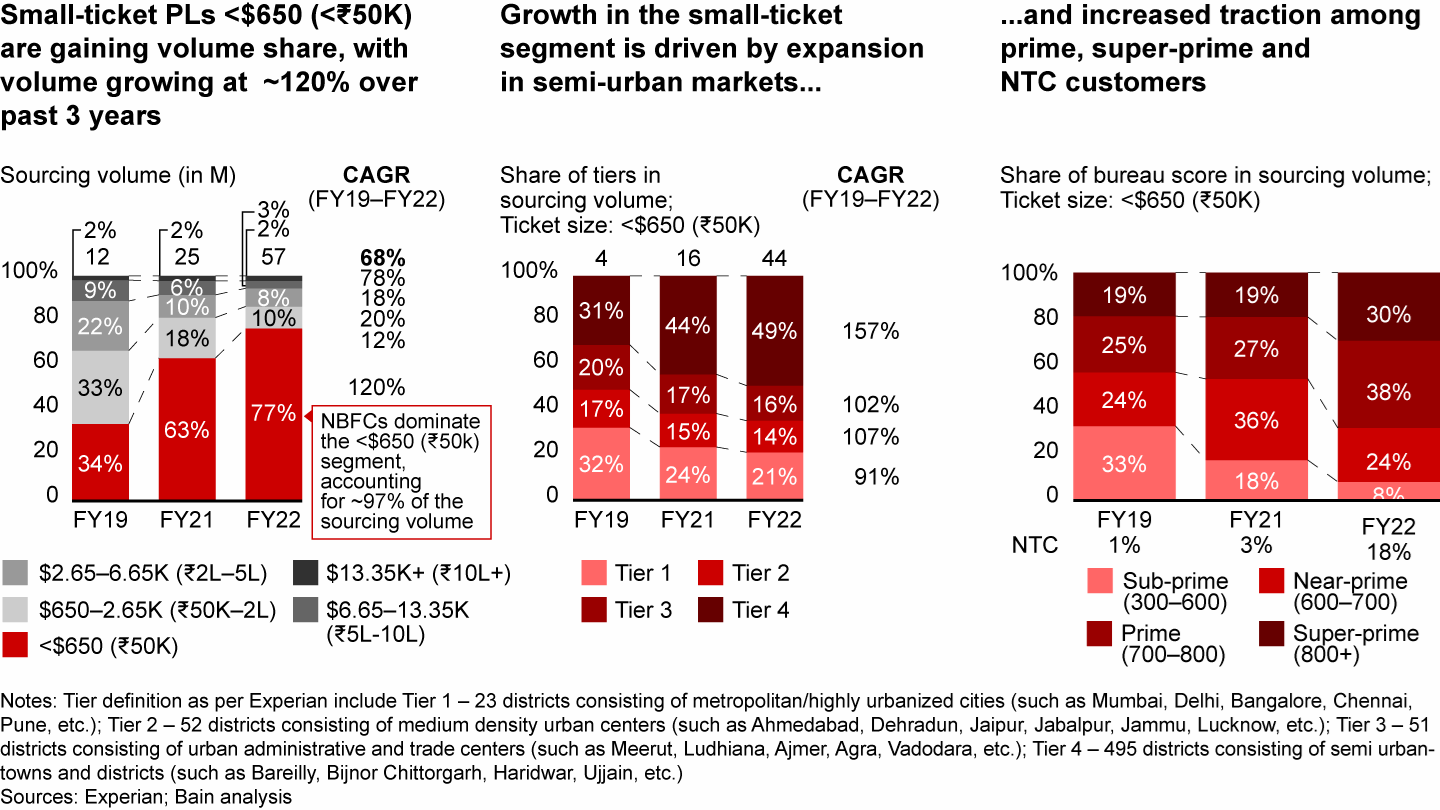
While small-ticket (<$650) PLs have shown growth, ~85% of disbursements within <$650 have been to <35 years age group, demonstrating millennial and Gen Z preference for bite-sized consumption financing
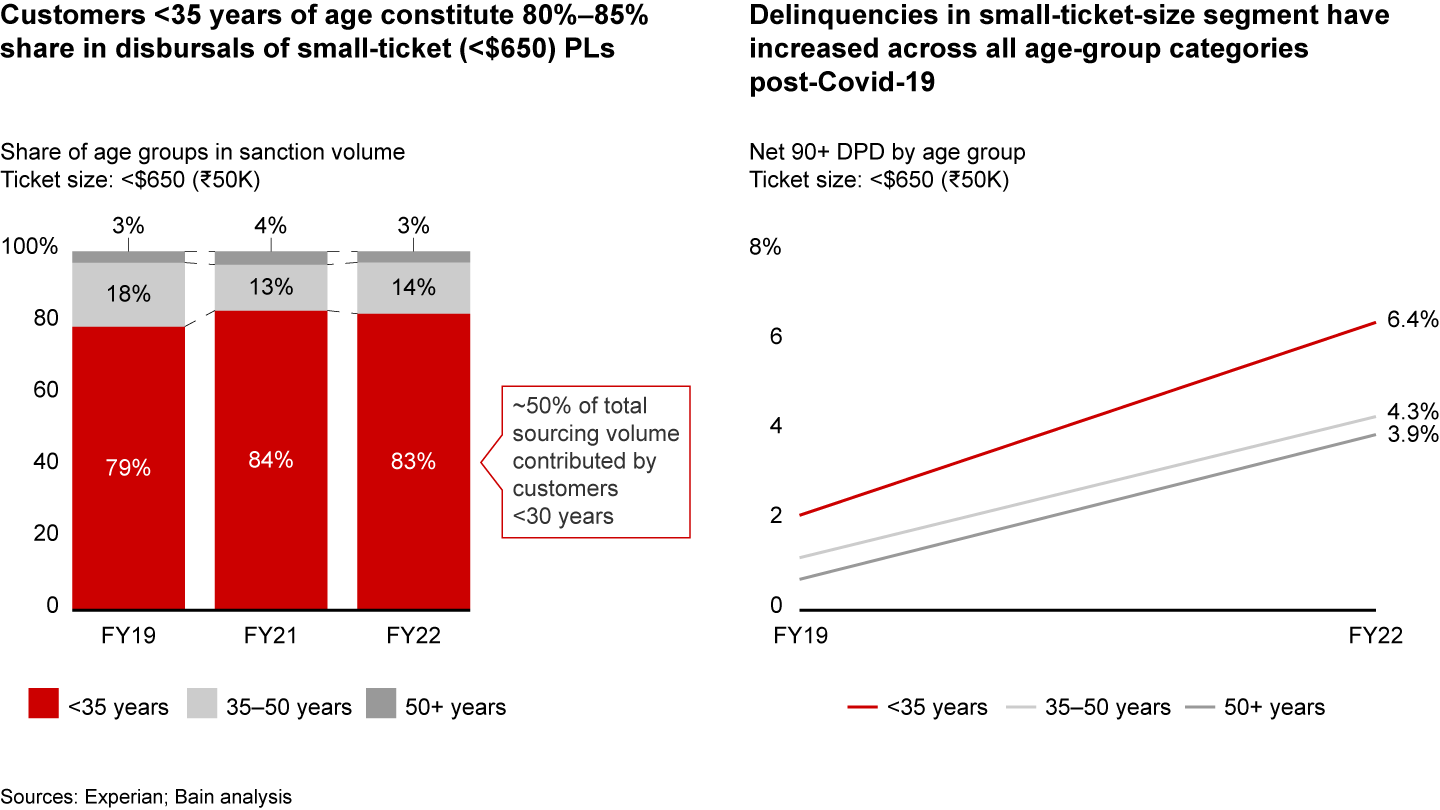
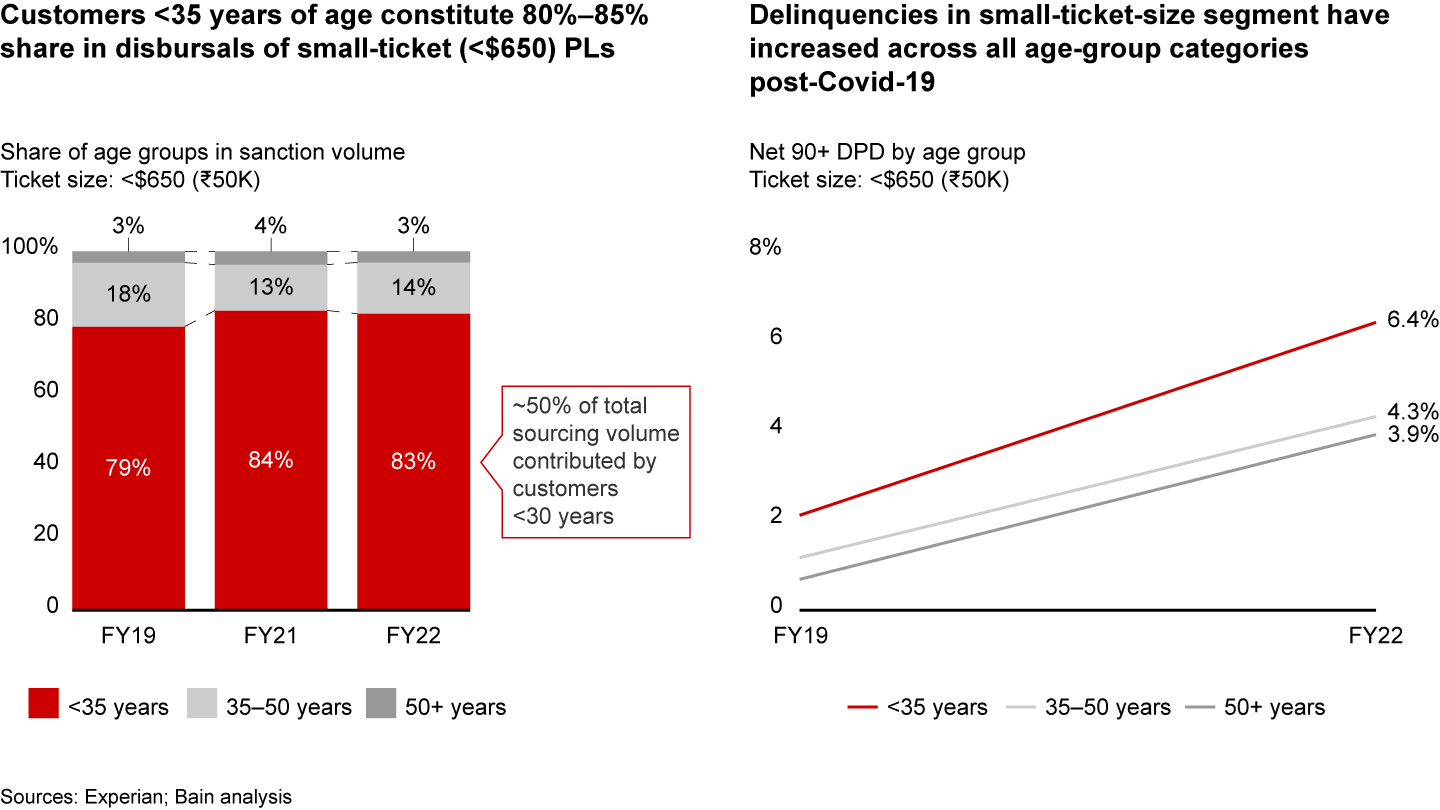
Small-ticket CDs have exceeded pre-pandemic levels, primarily driven by growth in Tier 4, with customers <40 years dominating the volumes that have shown sharp improvement in asset quality
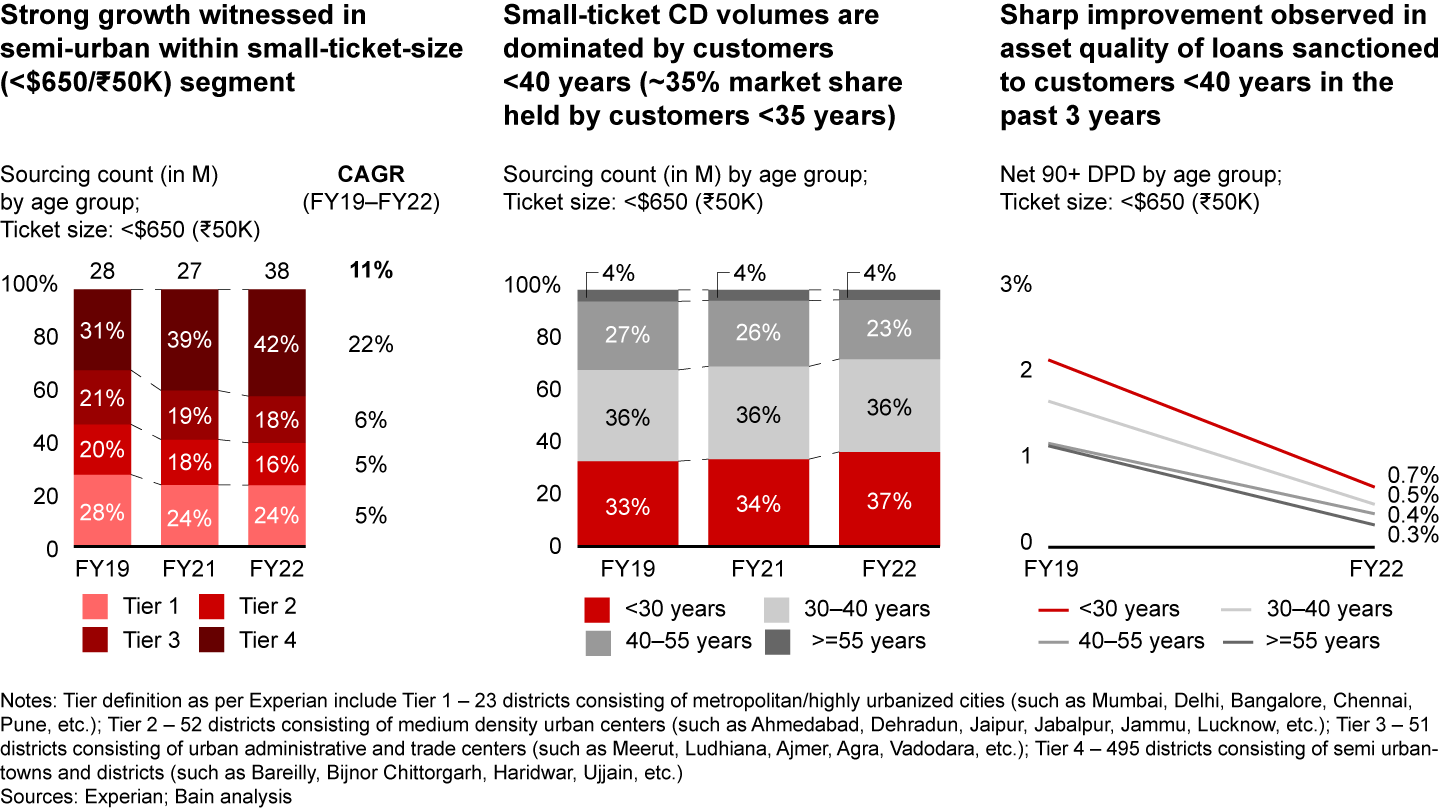
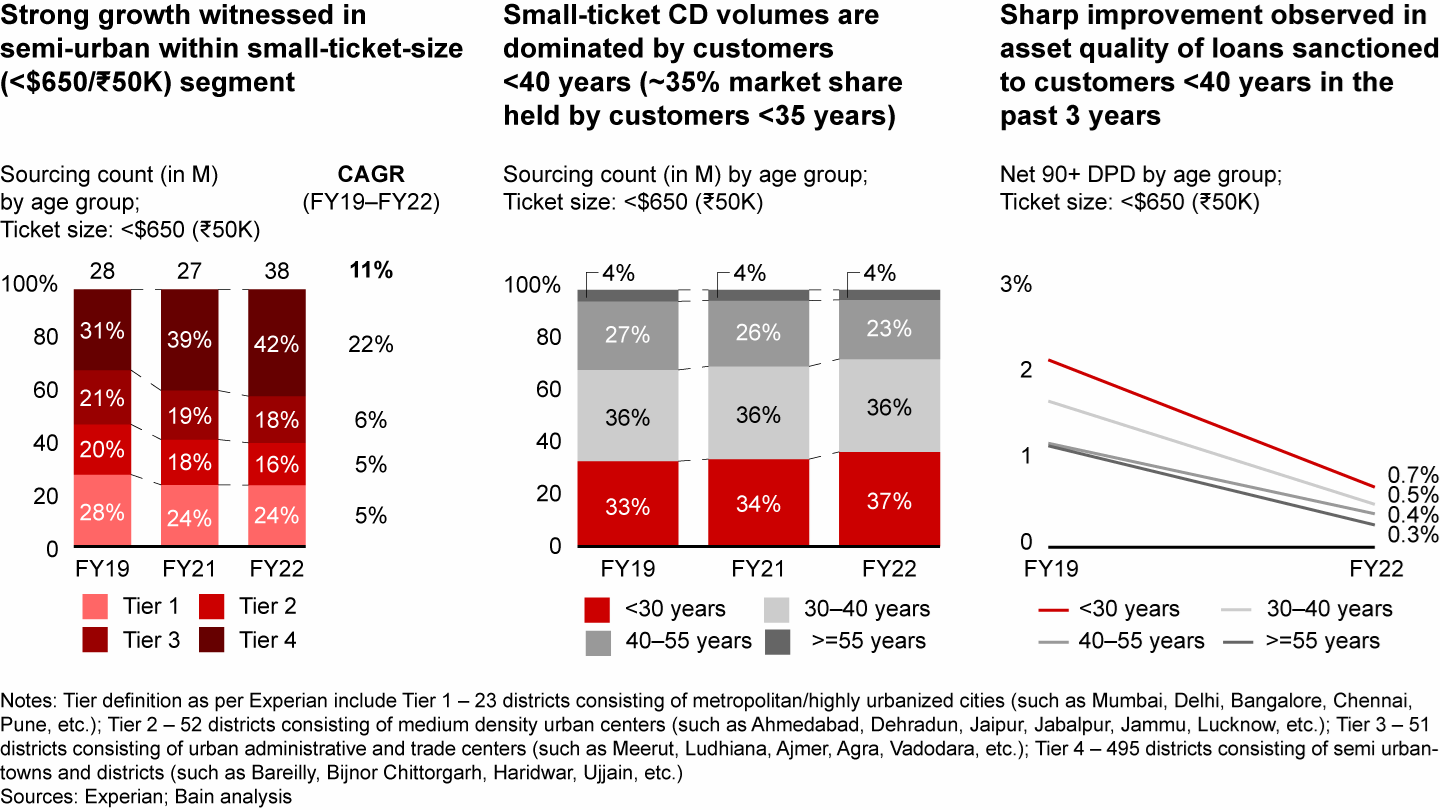
NTC customers have shown best credit behavior in CCs, but performance challenged in PL and CD loans
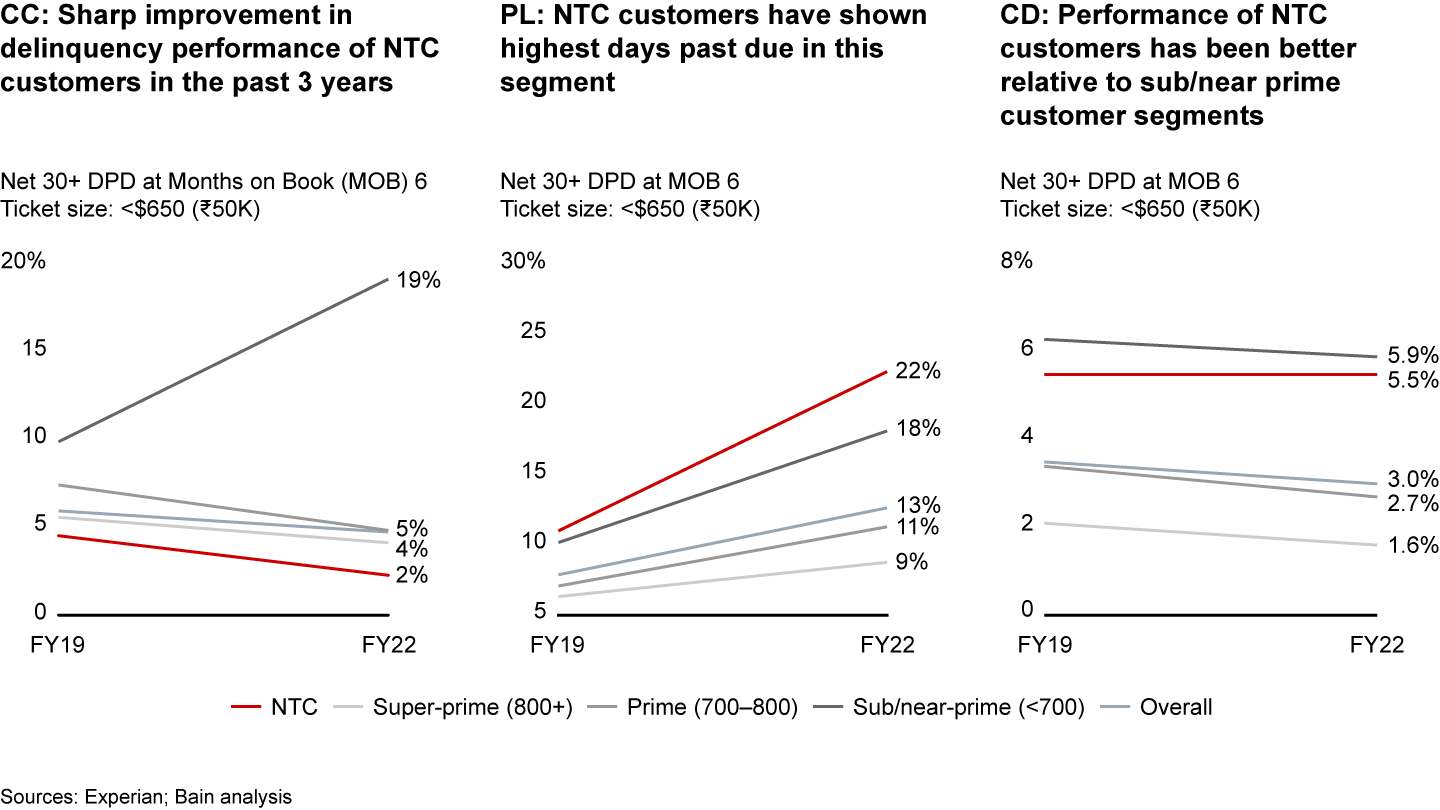
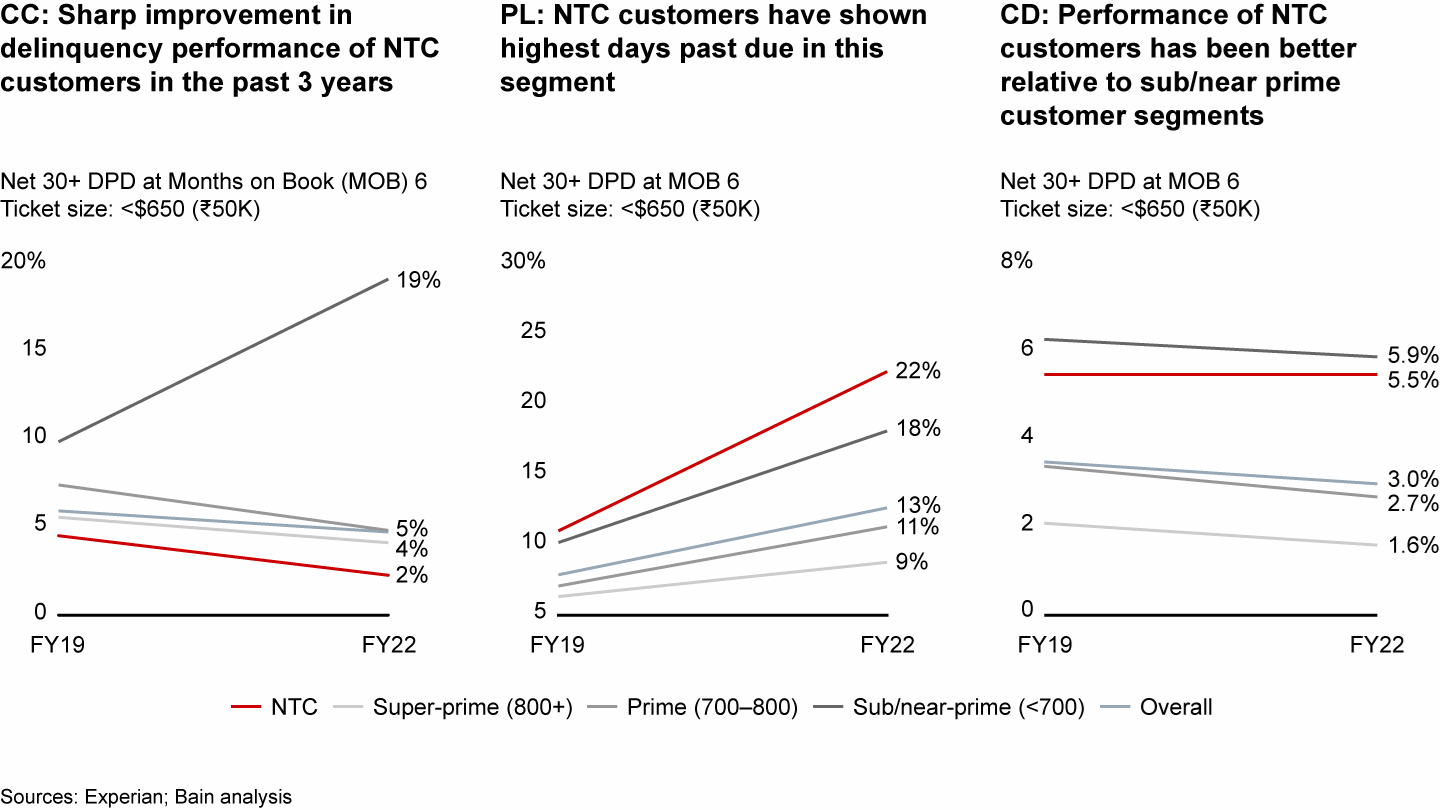
Short-term, small-ticket consumption financing solutions increasingly finding traction among customers and going forward will see further innovation from lenders
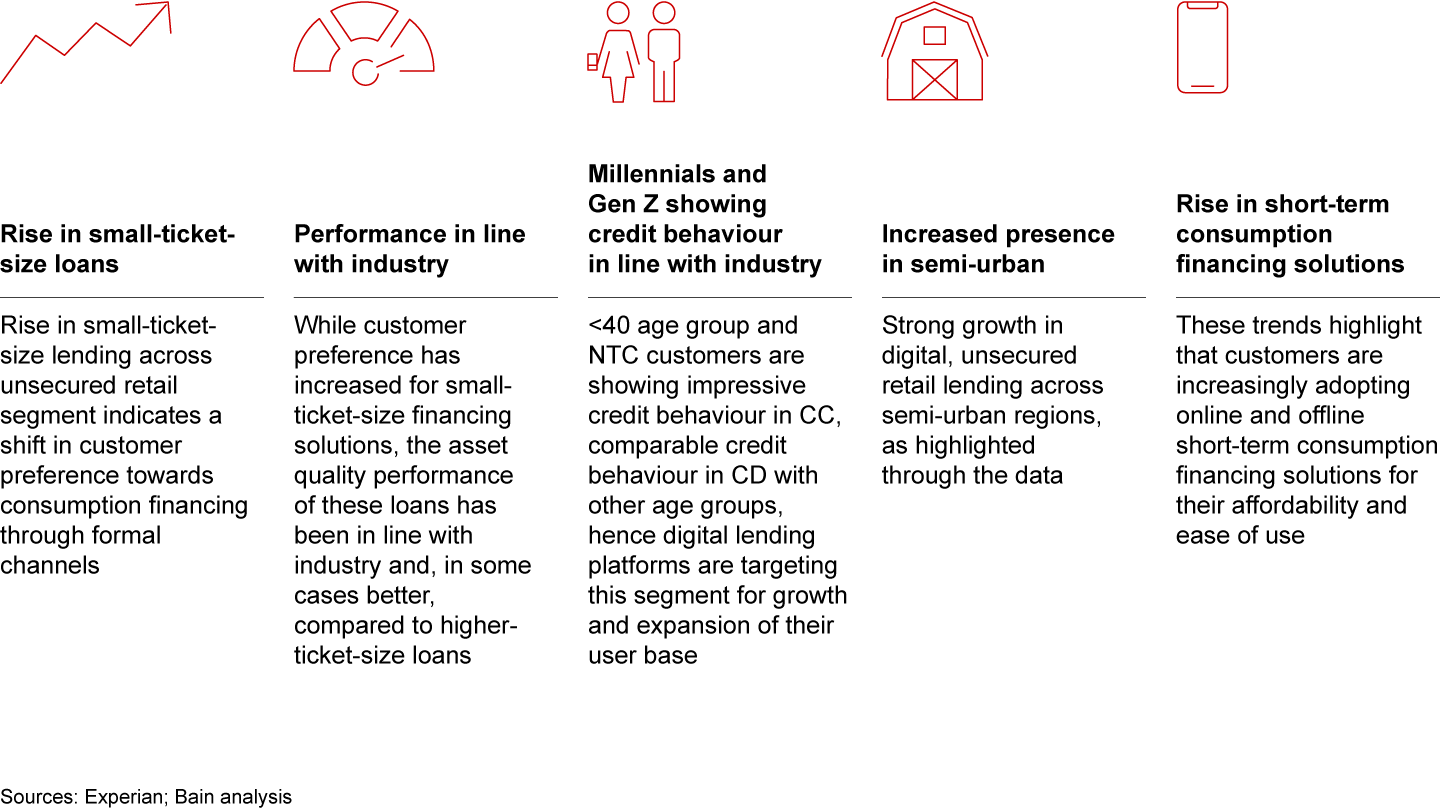
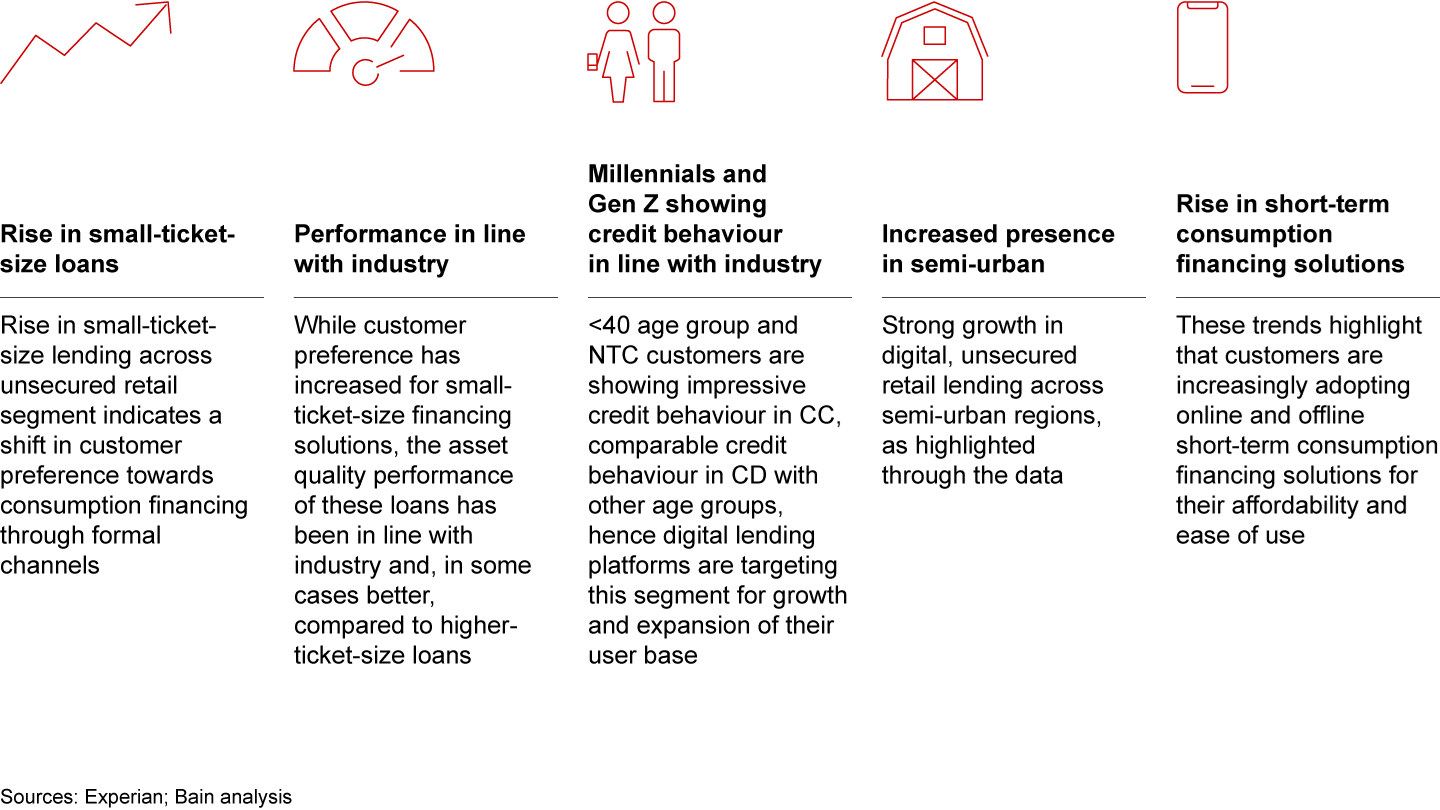
As digital lending models gain momentum, short term loans have emerged as a key credit product focused on providing consumption financing to NTC, millennial, and Gen Z customers
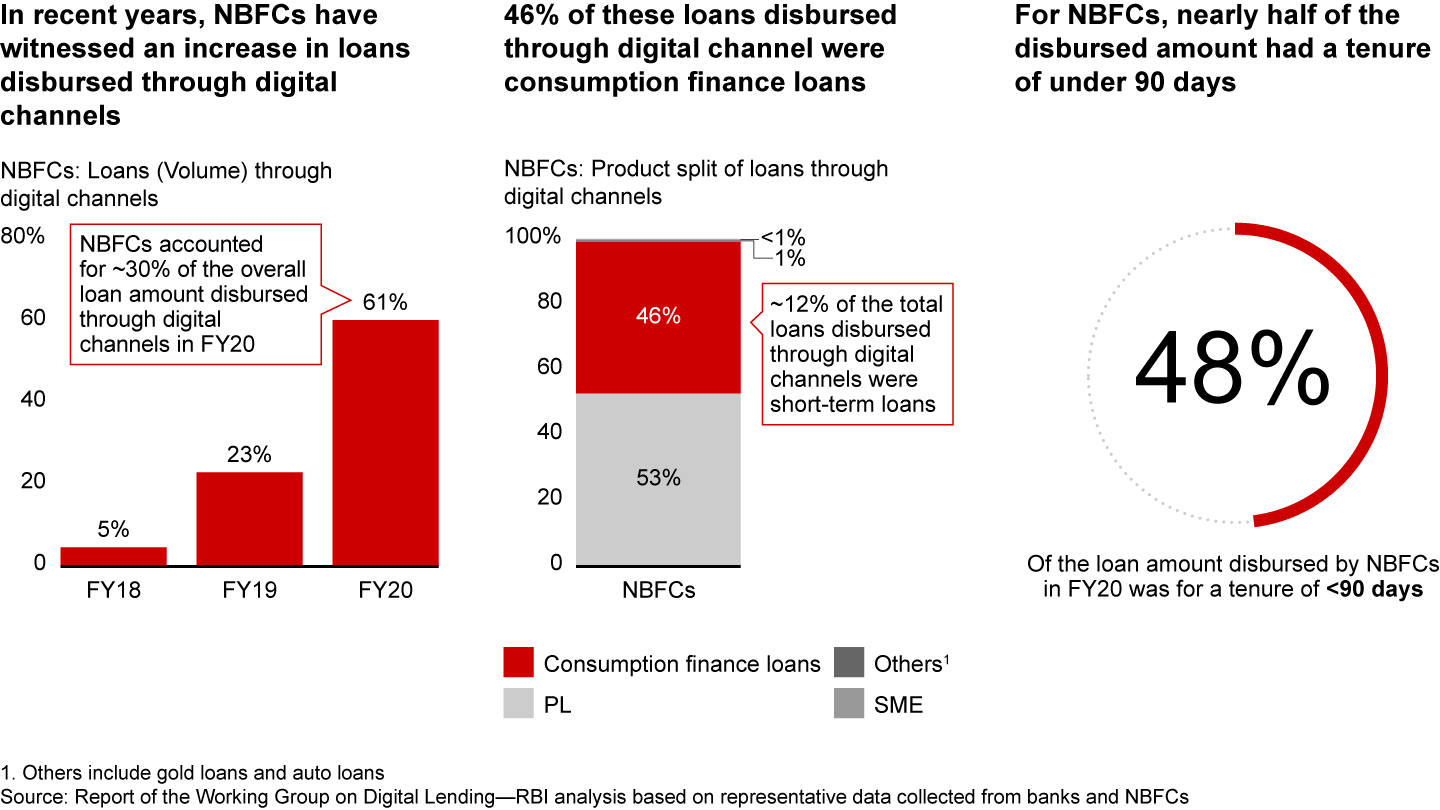
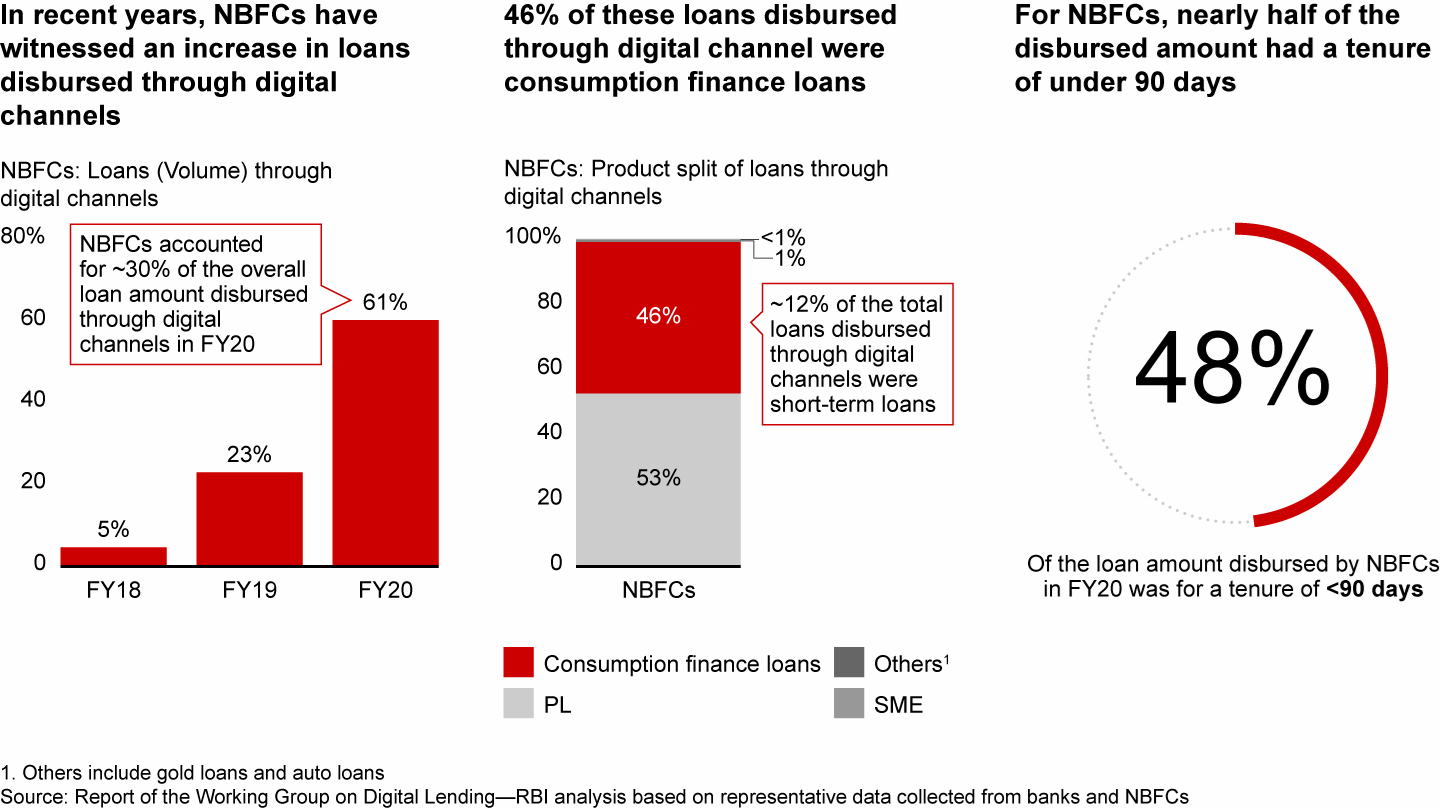
Short-term credit products are finding buyers in the Indian market due to their ease of use and lower costs due to their credit-free period; 80% of credit card users are also likely to use pay later products in the future
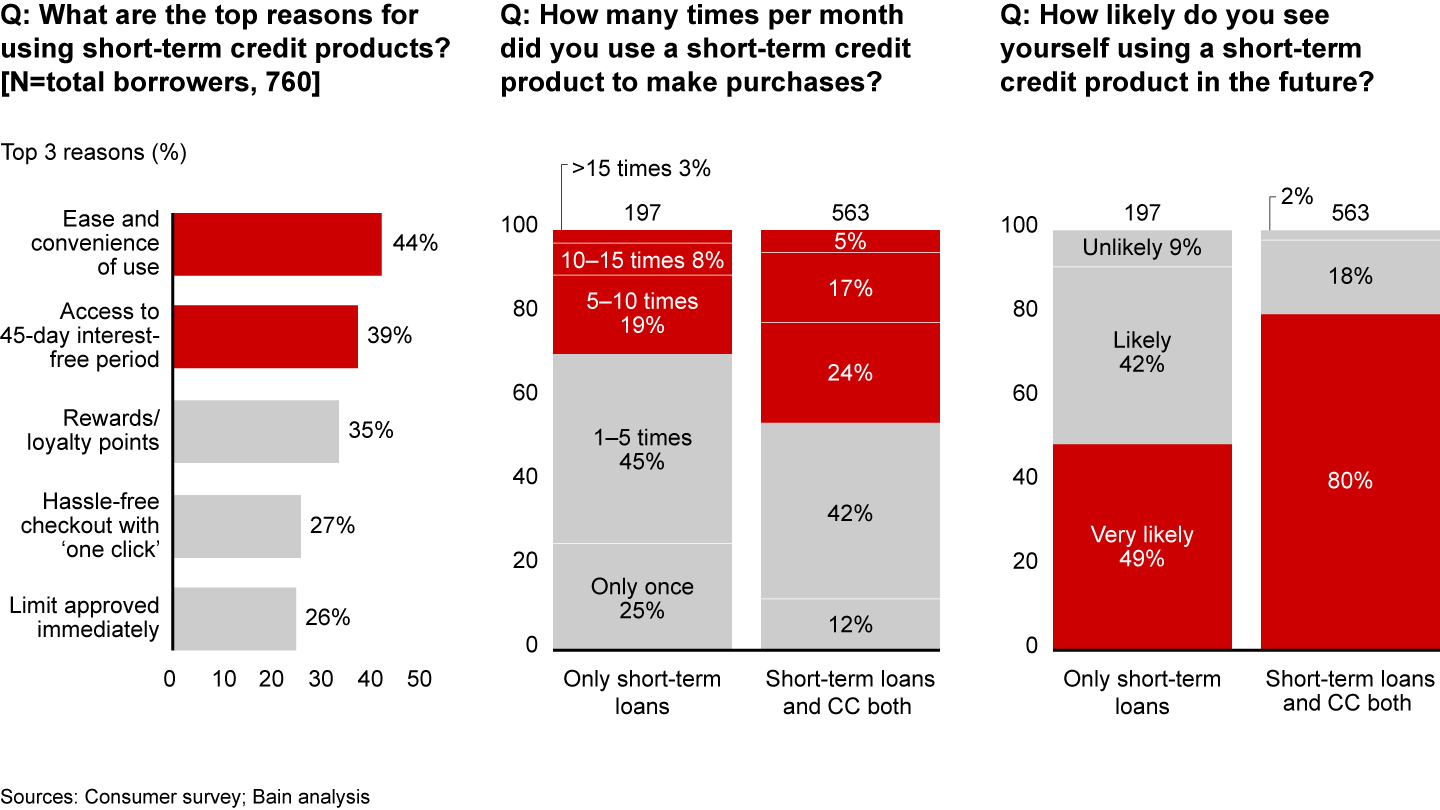
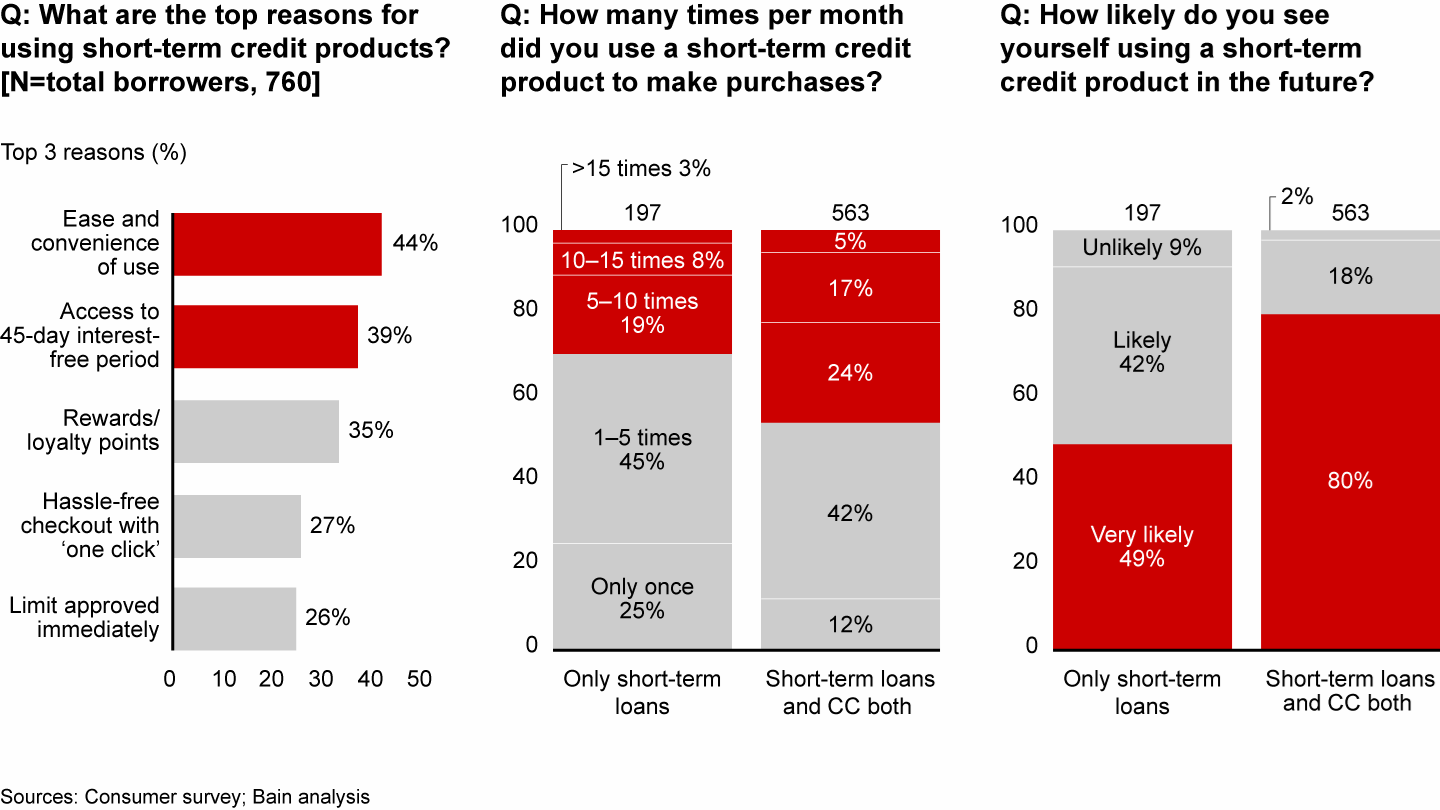
While short-term credit is finding interest among consumers, BNPL products loading credit lines on PPI have seen headwinds and will have an impact due to the new RBI circular
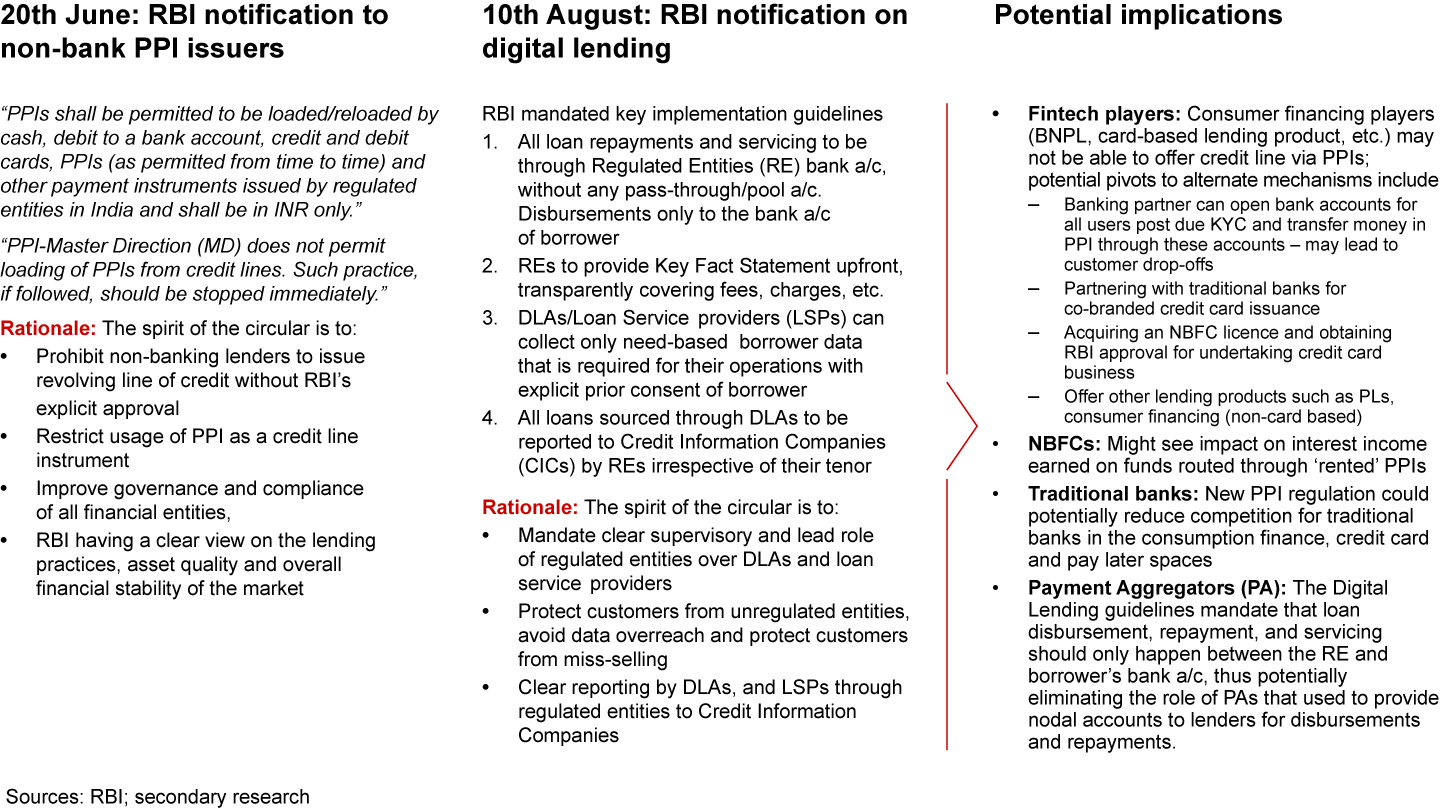
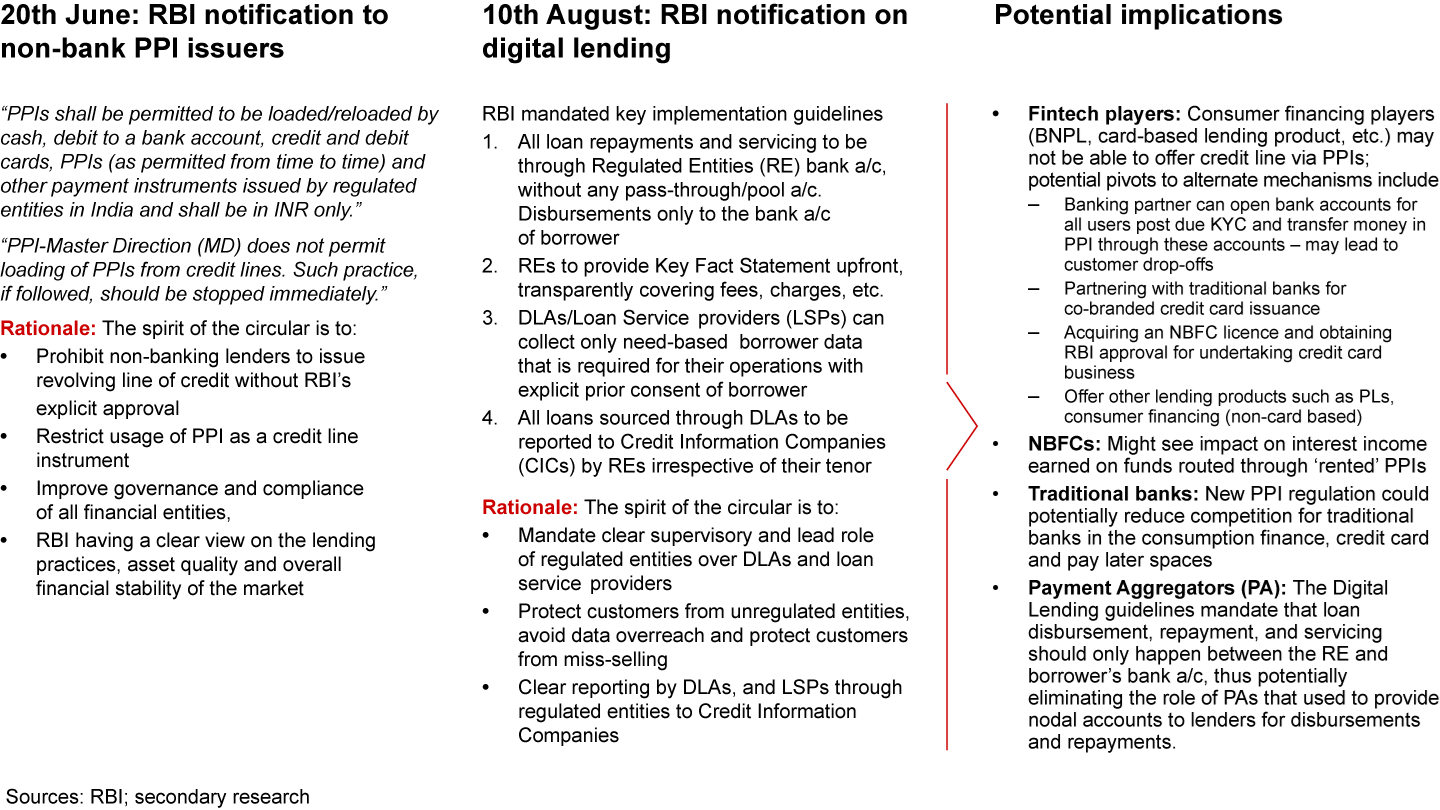
The Indian market saw emergence of three different types of BNPL products (cards or wallet-based), that will now undergo changes due to recent RBI guidance on PPI regulations
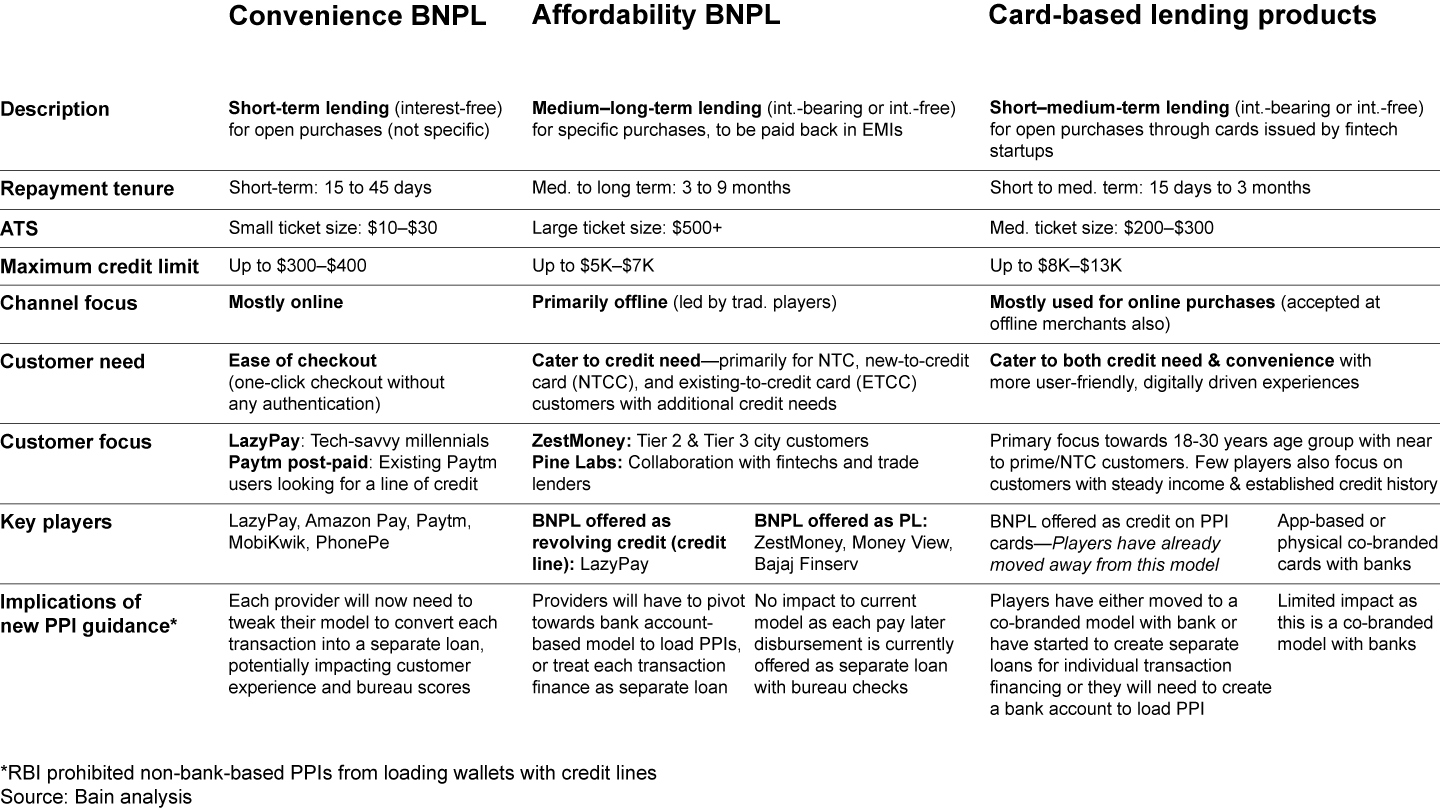
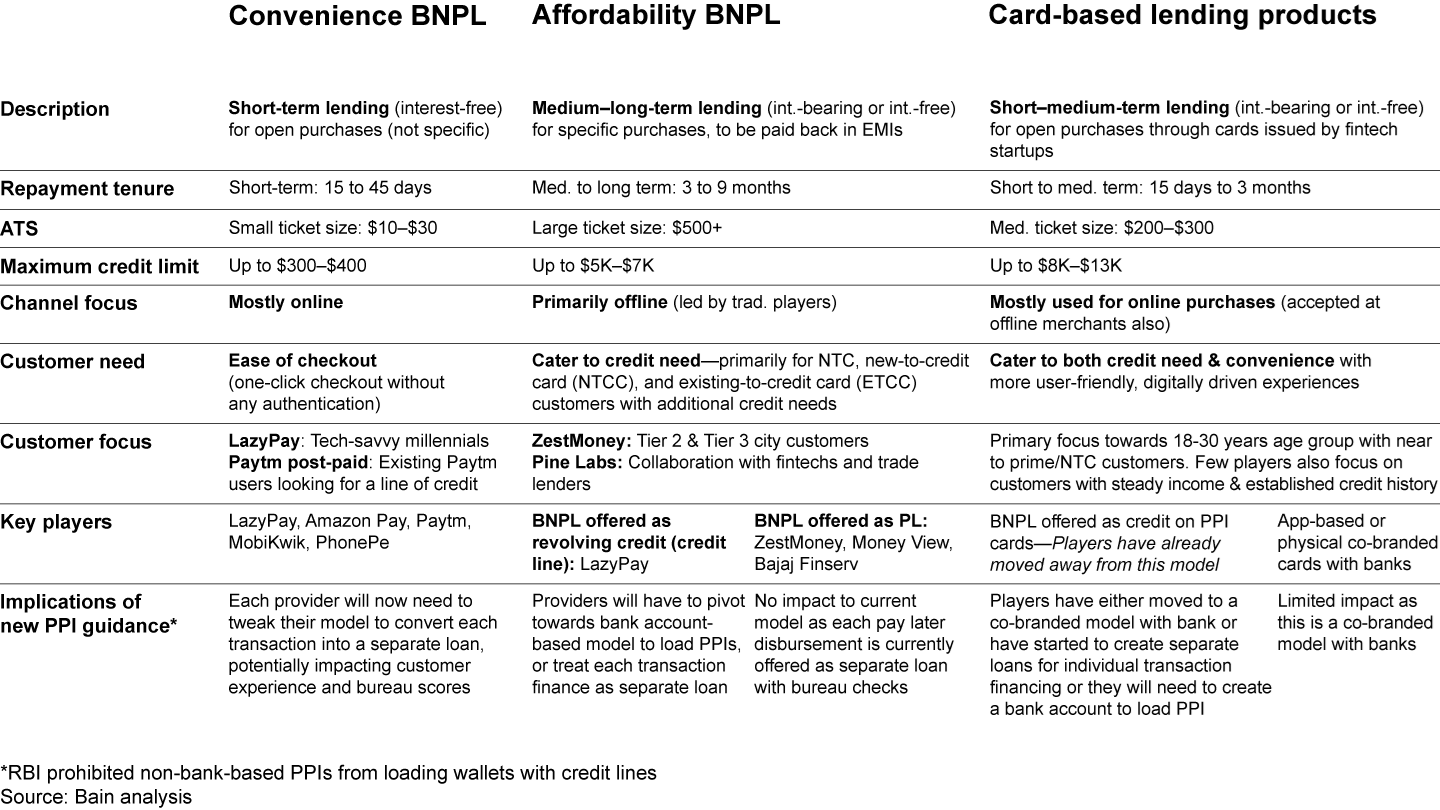
BNPL players have witnessed robust growth over the past two years; however, RBI’s recent guidance around PPI is showing signs of impact on the current form factors going forward
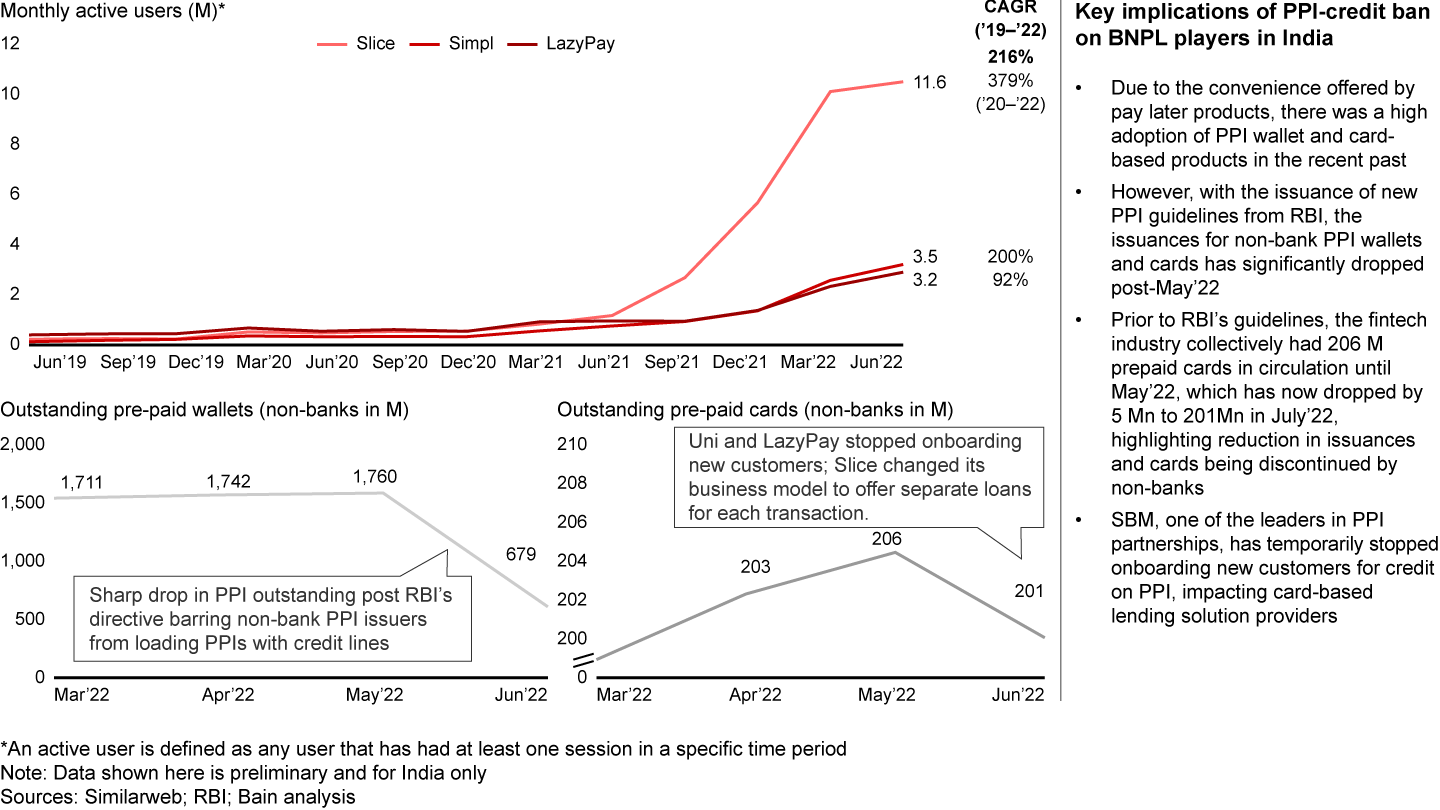
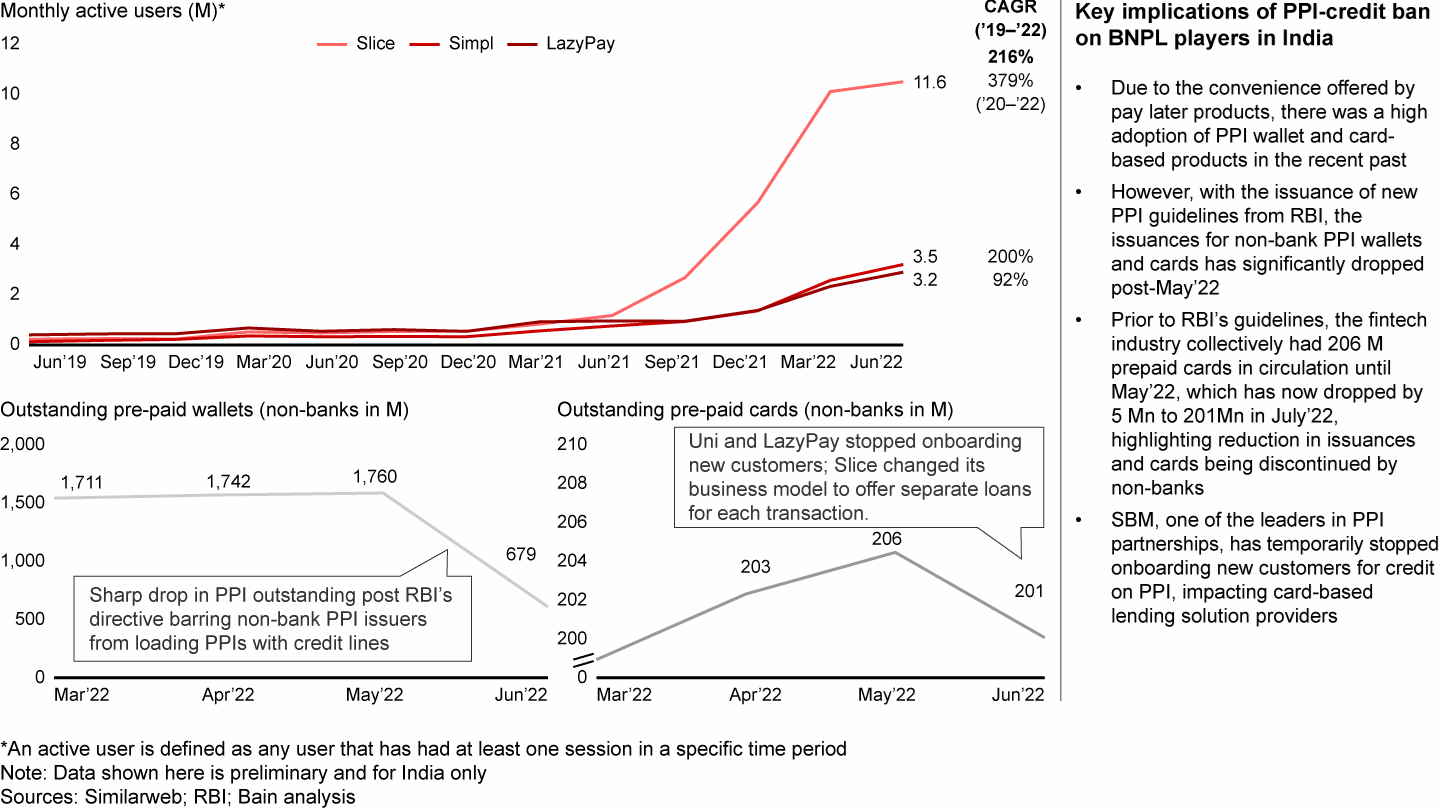
The consumption finance story remains strong; while the recent regulations will have a medium-term impact, it will further create opportunities for emergence of new form factors and closer collaboration with banks
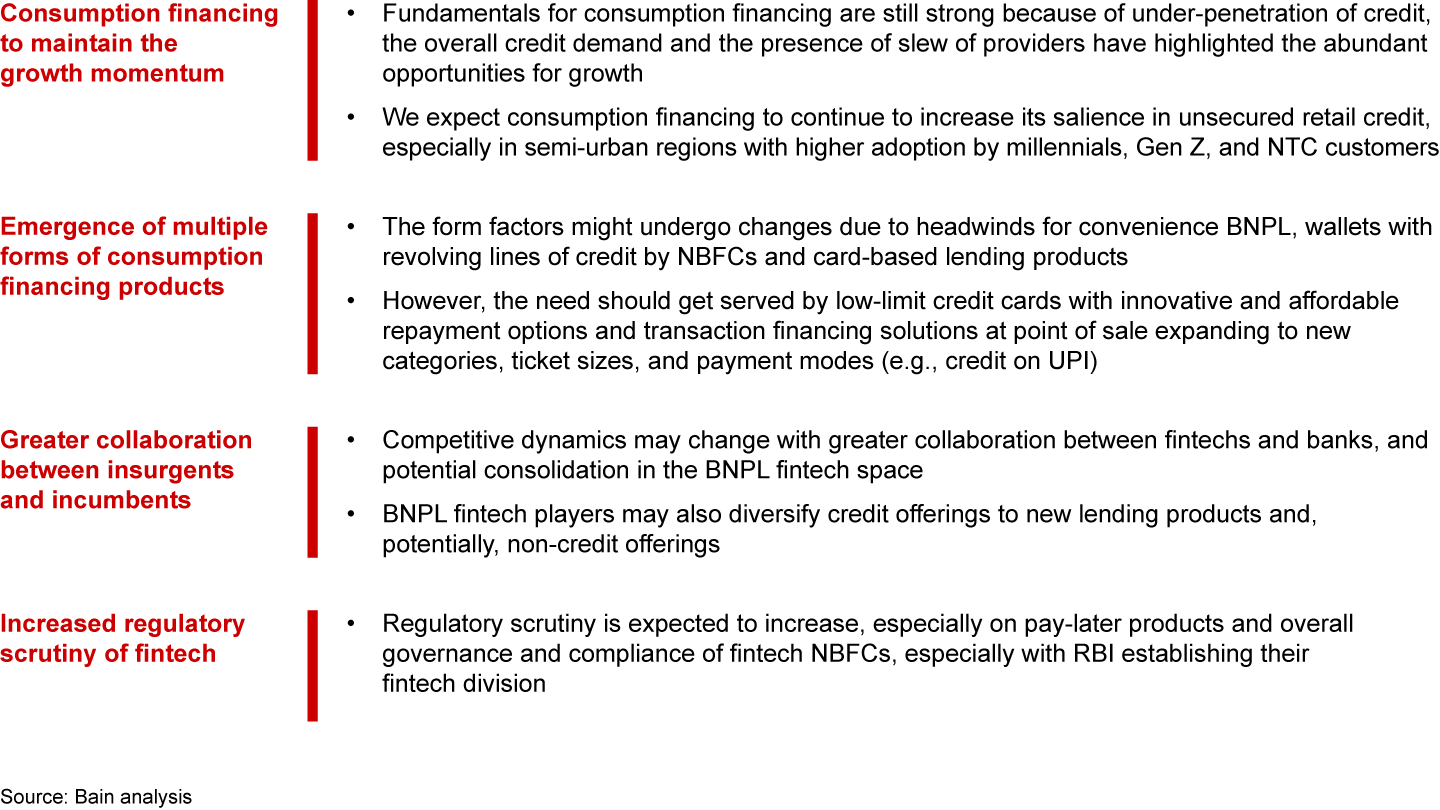
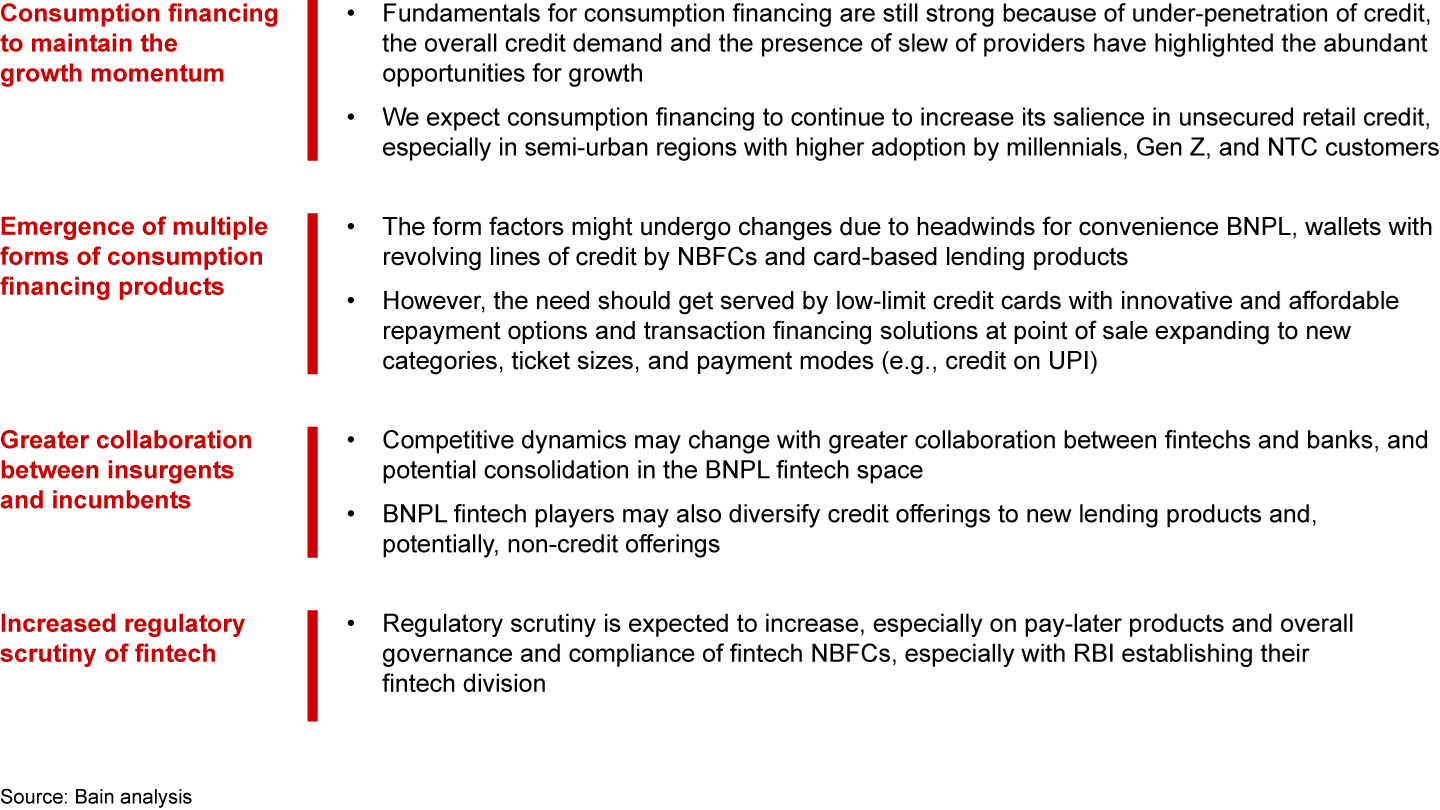

About Experian
Experian is the world’s leading global information services company. During life’s big moments – from buying a home or a car, to sending a child to college, to growing a business by connecting with new customers – we empower consumers and our clients to manage their data with confidence. We help individuals to take financial control and access financial services, businesses to make smarter decisions and thrive, lenders to lend more responsibly, and organisations to prevent identity fraud and crime. We have 20,600 people operating across 43 countries and every day we’re investing in new technologies, talented people, and innovation to help all our clients maximise every opportunity. We are listed on the London Stock Exchange (EXPN) and are a constituent of the FTSE 100 Index. Learn more at experianplc.com or visit our global content hub at our global news blog for the latest news and insights from the Group.